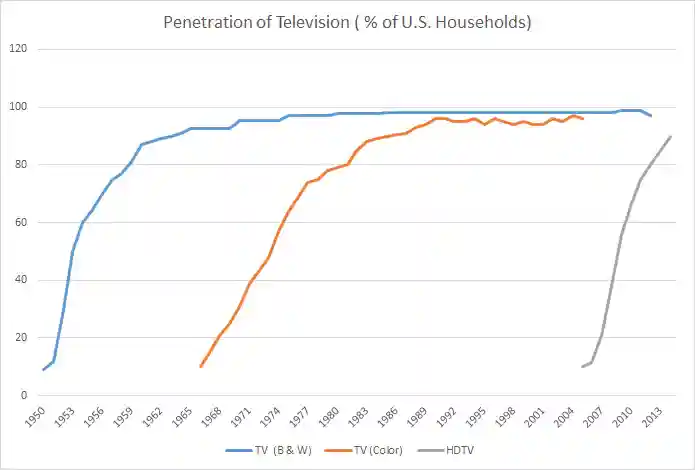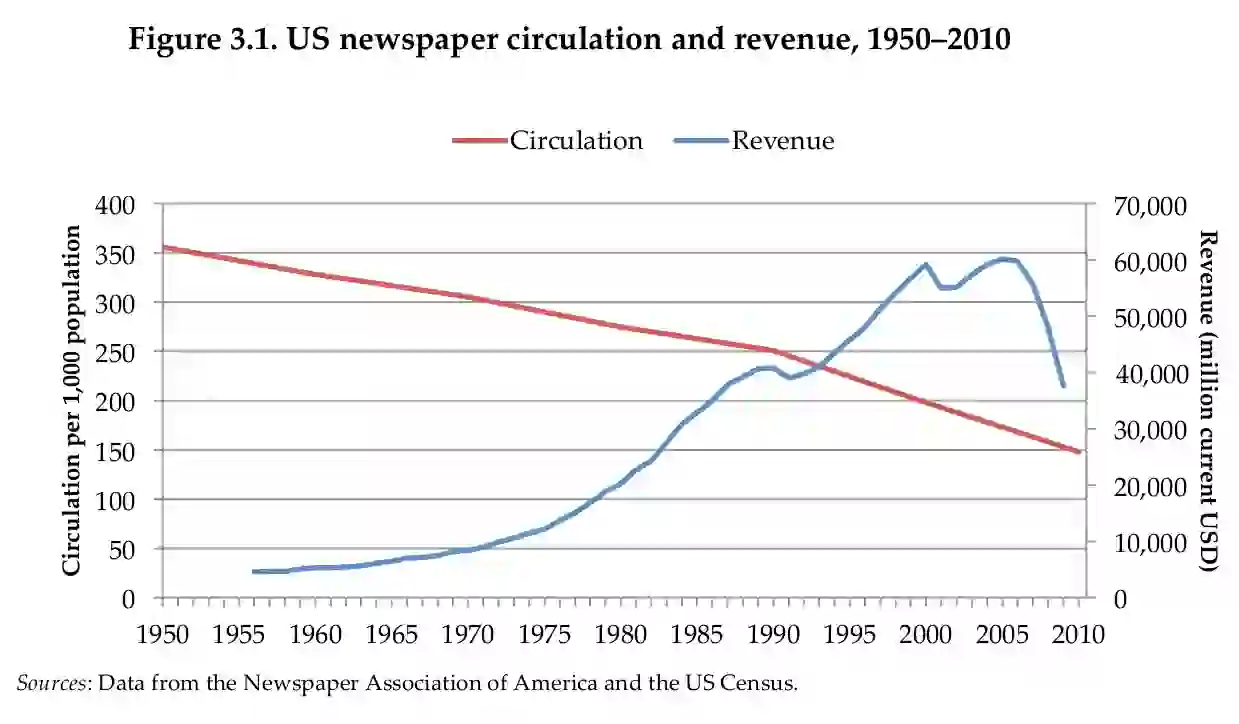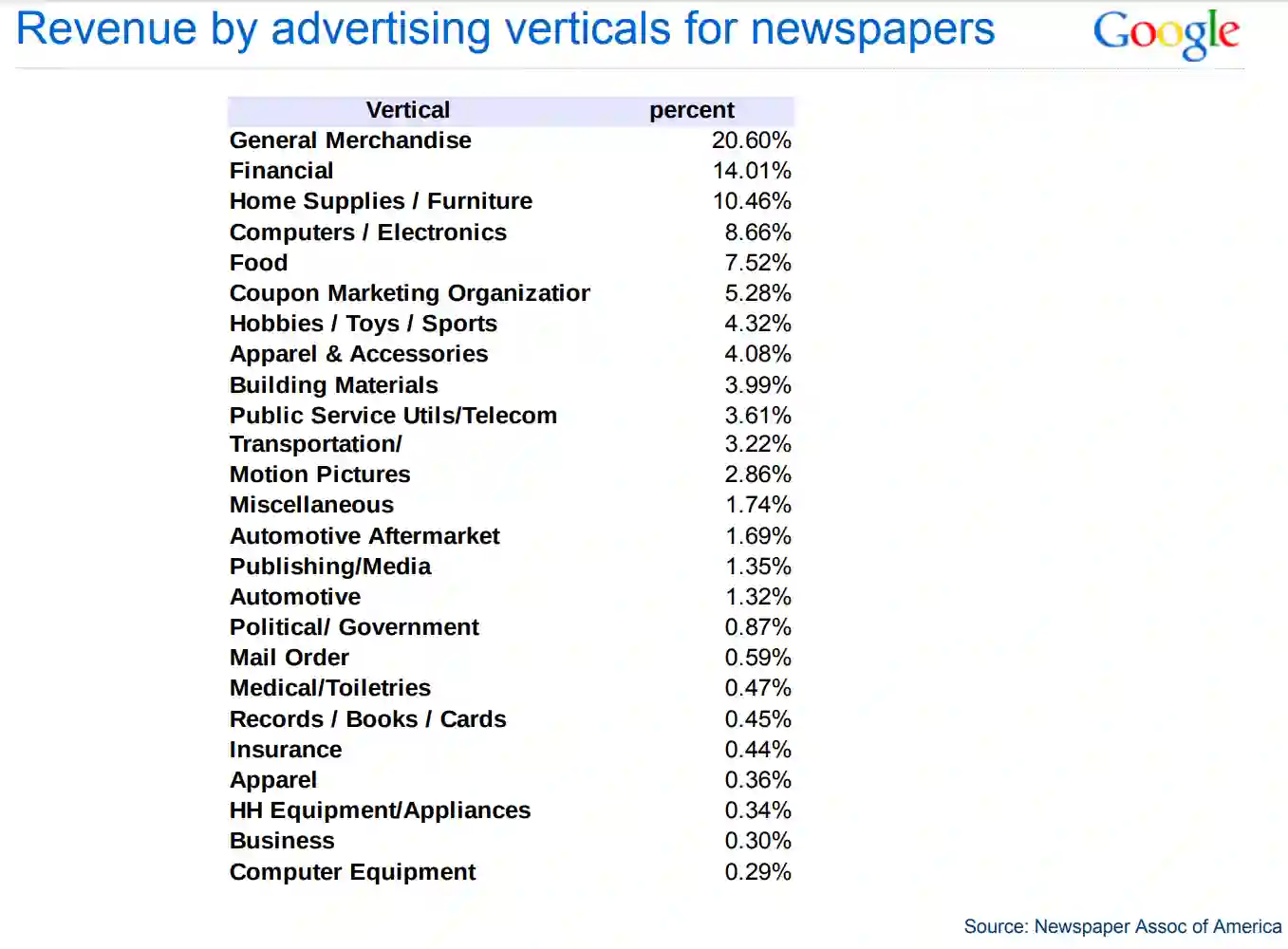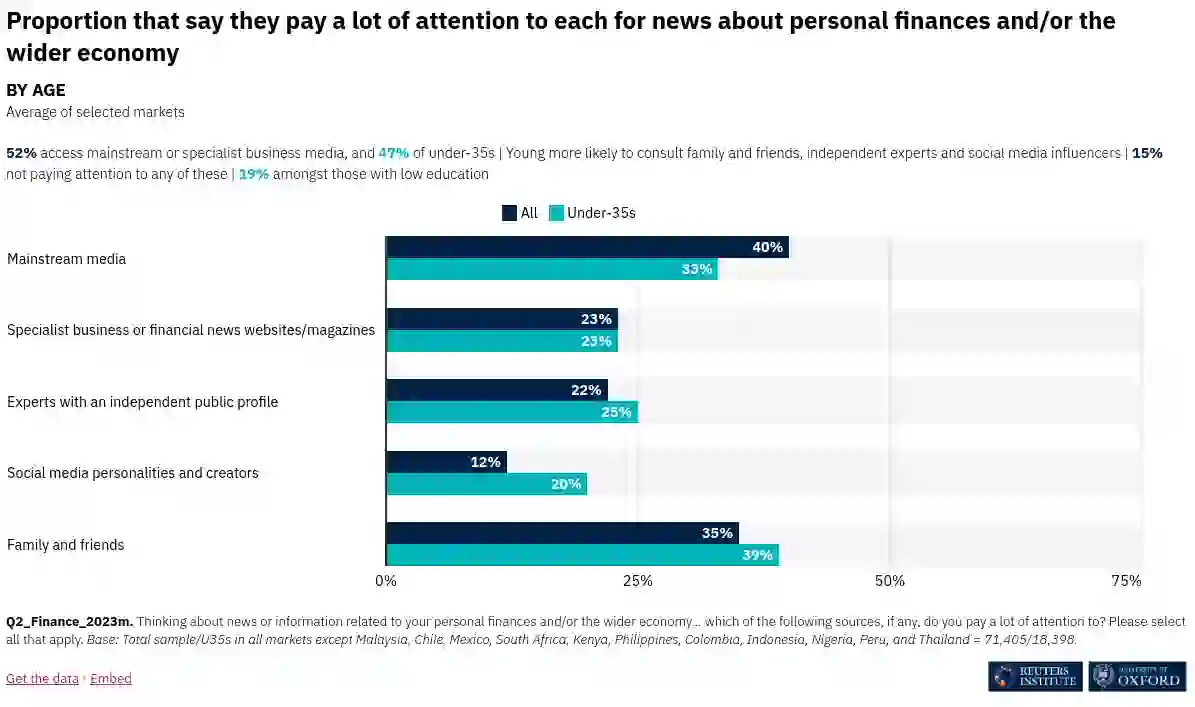“Good times become good memories, but bad times become good lessons.”
Uncle Iroh, Avatar: The Last Airbender.
What a crazy decade the 2010s were!
The tide of cheap money deluded an entire generation into thinking they were geniuses.
Everything worked until 2022. You could raise $130 million for a $400 juicer (Juicero), $1.75 billion for a mobile app that only has 10-minute shows (Quibi), $700 million for a cat picture website (BuzzFeed), or $360 million for a dog-walking startup (Wag). If you went to SoftBank or Tiger with an idea about an app that analyzes farts and tells what flower or vegetable they smell like, you’d be assaulted with a $100 million cheque—FSaaS: fart smelling as a service.
But just like peach-scented farts don’t linger forever, the good times don’t last. As interest rates around the world remain high, things are unraveling.
The good times are over.
They were too good to be true.
Now that the tide has receded, it turns out the geniuses were swimming naked. The geniuses are now trying to convince the world that their nakedness was a deliberate fashion choice.
It turns out, many of the supposedly radically innovative businesses built by galaxy-brained geniuses were just fleeting farts. They were all Zero Interest Rate Policy (ZIRP) babies. It wasn’t brains; it was a bull market.
Cue Green Day – Boulevard of Broken Dreams.
I walk a lonely road, the only one that I have ever known. I don’t know where it goes, but it’s home to me and I walk alone.
I walk this empty street, on the Boulevard of Broken Dreams, where the city sleeps and I’m the only one, and I walk alone.
Geniuses turned out to be frauds, and dreams turned out to be delusions. You know things are bad when VCs start uttering the term “forensic audit.” After a decade of crazy partying, it’s time for a detox.
The latest casualties are from digital media, an industry I have passionately followed for over a decade. A few months ago, BuzzFeed shut down BuzzFeed News, and Vice Media filed for bankruptcy. If you rewind back to 2010, these digital upstarts were supposed to be the future. They were set to euthanize legacy media companies like The New York Times, CNN, and Disney and drag the industry into the 21st century.
It all seemed so romantic.
The death of the companies has inspired countless think pieces, postmortems, and obituaries—it’s the “end of an era,” and there’s a “regime change.” Such a charade isn’t complete without derivative thunk pieces of the think pieces feigning surprise and shock. How could the digital saviors that were supposed to deliver the news publishing industry from certain damnation die?
Vice and BuzzFeed News are just the poster children for the ills that plague digital publishers. Almost all publishers are buggered to various degrees.
Why did they die? Could the death have been avoidable? Why does the media business suck? Were the deaths of these digital news media outlets a surprise?
I have answers to everything!
Before I answer the questions, let me give you some background. You don’t care about it, but I will just the same.
Flashback
I belong to a minority that still believes that a free and independent press is the difference between a thriving democracy and a banana republic.
“Four hostile newspapers are more to be feared than a thousand bayonets.” ― Napoleon Bonaparte
I know that’s a quaint notion at a time when the term “mainstream media” has become a pejorative. At its best, good journalism holds the powerful accountable. It gives us all a voice. It lifts the veil of our ignorance and makes us less stupid. The key terms here are “at its best” and “good journalism.” By no stretch of the imagination is our media always at its best. But when it is, we are all better off.
My dad read newspapers every day and I picked up the same habit. As far as I can remember, I’ve always read random things. My dad’s family didn’t appreciate the value of education. I still remember him telling me stories about how some asshole family members of his made it impossible for him to pursue his studies. Given his experiences, he made it a priority to get me and my brother to read and interact with others as much as possible. Tagging along with him on his Bajaj Chetak and Kawasaki Bajaj KB 100 to the local tea shop to meet his friends was a regular ritual.
No matter what changed as I grew up, the one thing that remained a constant was we always had newspapers. Whenever we changed houses, my dad would hunt down a newspaper agent like Liam Neeson In Taken and restart the newspaper subscription. Reading a newspaper became a daily habit from an early age. I understood very little but read them nonetheless. With time, I understood the value of newspapers.
This is how weird I was. When DNA launched in Bangalore, they had salespeople selling subscriptions. I still remember tagging along with the sales guys and helping them sell subscriptions in my neighborhood.
Over time, I started writing as well, but I was shit at it, really shit. I can’t recall why, but I also wanted to be a journalist at one point. Thank God I didn’t become one. If I had, I would be sharing a luxurious single-bedroom condominium made of zinc-aluminum sheets with migrant construction workers from Bihar on a construction site at Whitefield.
I have no idea why, but I started following the news publishing industry around 2013–14. It was the early days of social media in India, and people were poking (not that poking) each other on Facebook. Blogging was still cool, saying the term “RSS feed” out loud didn’t evoke geriatric sympathies, publishers like BuzzFeed and its clones like ScoopWhoop were starting to take off, and the internet hadn’t yet become the public toilet it is today. Torrents were a thing, with boner pill ads popping from the bottom right corner.
Ok, I’m done reminiscing. This Kannada serial-style flashback was to say that I’ve been following digital news publishing for a long time. I had stopped following the industry around 2019. The death of BuzzFeed, Vice, and the massive layoffs elsewhere rekindled my interest in the industry. For the past couple of months, I’ve been reading, watching, and listening to anything I could find about the industry. So I figured I might as well write about it.
Why?
Because I’m on the interweb and I have a blog. So clearly, I’m an expert on all things under the sun, and I must subject the world to my expertise. Them’s the rules.
I start the post with a quick history of American and European media. This isn’t a detailed history but just the key events in the evolution of news and newspapers to give you a 90,000-foot view.
Since the American media market is the largest in the world, with the richest consumers and a news publishing industry that’s in terminal decline, I trace the growth and decline of the American news publishing industry. I tell the story through the eyes of people in the industry, observers, scholars, and my own observations. In a sense, this is as much a curation of thoughts, views, and experiences of people in media as it’s my own opinion.
Jump around
Once upon a time… {#once-upon-a-time.wp-block-heading}
Those who cannot remember the past are condemned to repeat it. —George Santayana
It’s always easy to say something was obvious in hindsight, and it almost never is, with the exception of the news publishing industry.
I've got news for Mr. Santayana: we're doomed to repeat the past no matter what. That's what it is to be alive. ― Kurt Vonnegut
The troubles facing digital media outlets aren’t new. The news business has always sucked, and the script is the same as traditional newspapers—hubris, myopia, and a lack of basic economic sense. Why and how did we end up in a place where we talk about news publishers as if they’re terminal patients? You have to look to the past for answers.
As Mark Twain famously never said:
> History doesn’t repeat itself, but it often rhymes.
I’m not an archaeologist in the formal sense of the word—I don’t have any education or expertise. But when you think about it, archaeology is just digging up dirt, finding weird rocks, and making up stories about them because finding 800-year-old people is hard. So, anybody who has ever dug up dirt is an archaeologist. I was a notorious dirt digger when I was young. Furthermore, I am amazing at Googling, aka digital dirt. So, I’m an archaeologist and, by extension, a historian.
Before the written word, news was transmitted through the spoken word. Messengers and town criers were the earliest newspapers but human. Government bulletins were the precursors to modern newspapers and can be traced back thousands of years.
But if you believe in made-up things like history and evidence, one of the first newspapers can be traced back to Rome between 59 BC and 130 BC. Thanks to Julius Caesar, the Roman Empire had daily gazettes called Acta Diurna, or daily events. These bulletins contained news about births, deaths, gladiatorial fights, astrology, court trials, etc. There was a separate bulletin called Acta Senatus to report on the developments of the Roman Senate. In a way, this was the very first Twitter feed. The Han dynasty may have had Dibao, or palace reports, as early as 206 BC. Around 713–734 AD, in the Kaiyuan era, the Chinese had something called Kai Yuan Za Bao, or Bulletin of the Court_._ These bulletins were handwritten on silk and contained domestic and political news for government officials.
The modern, regularly published newspapers as we know them were not possible until the invention of the movable-type printing press by Johannes Gutenberg around 1440. Although Gutenberg gets all the credit, printing presses existed long before him. The Chinese and Japanese had woodblock printing as far back as the 7th and 8th centuries, and the Koreans had it in the 10th and 11th centuries. The Chinese had the movable-type printing press around 1040 AD, and the Koreans had it by 1230. They never caught on in China because, unlike English, the Chinese language has thousands of characters, and having a printing block for every character was impractical.
While it’s easy to write about the history of news in a neat sequential order, the evolution of news was anything but. It’s messy, chaotic, and unpredictable. To give an example, soon after the invention of the Gutenberg press, one of the earliest things to have been published was erotica:
> Among the early books printed on a Gutenberg press was a 16th-century collection of sex positions based on the sonnets of the man considered the first pornographer, Aretino—a book banned by the pope.
Soon, the printing press started spreading around Europe. In 1470, a poem describing the conquest of Negroponte by the Ottomans was published in Milan. Around the 1500s, Italy had handwritten and printed newsletters called avvissi. The avvissi were circulated both in public and private. They aggregated diplomatic, military, political, and religious news from various sources. By the 1570s, they were widely read by the city elite in Rome and Venice. The Medici dynasty invested considerable resources in setting up an information-gathering network throughout Europe to collect intelligence. Cosimo I de’ Medici created a postal network when he ascended the throne to send and receive avvisi.
Between the 1500s and 1660s, the Fugger family, one of the richest in Europe, established a vast network of correspondents to collect news in the form of handwritten newsletters. These newsletters contained political, military, religious, and criminal news. Apart from having a near monopoly in copper, the Fuggers were one of the largest lenders and were bankers to merchants, princes, popes, kings, and emperors. There’s speculation that they set up a news correspondent network to decide their lending rates. There’s debate over whether these were private newsletters or if they were circulated publicly, but it looks like they might have been public. In a way, the Fugger news network preceded finance news as we know it.
Fuggers are the richest family you have never heard of, with a reported net worth of over $400 billion.
There’s debate over what’s considered the first newspaper, but Relation aller Fürnemmen und gedenckwürdigen Historien (Account of All Distinguished and Commemorable News), published in Strasbourg by Johann Carolus may have been the first European newspaper. Some consider this a “newsbook” and not a newspaper. The Courante uyt Italien, Duytslandt, &c., was the first broadsheet Dutch newspaper and was published in Amsterdam in 1618.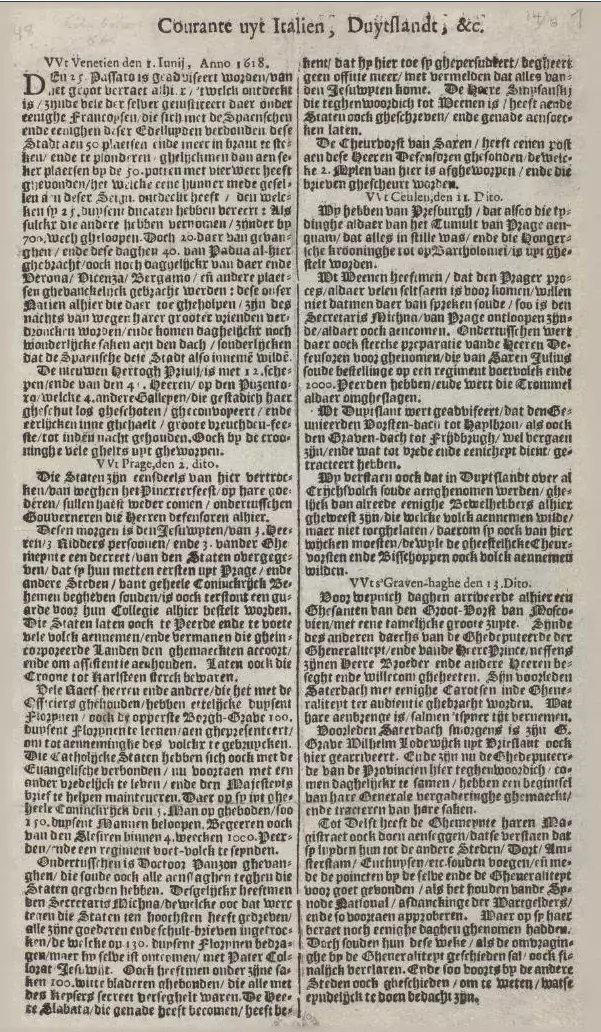
The Star Chamber Decree of 1586, under the reign of Elizabeth I, imposed restrictions on the publication of news in England. Early news publications in England were called corantos, and were printed in Amsterdam. The first coranto printed in England may have been The New Tydings Out of Italie Are Not yet Come in 1620 by Thomas Archer. This news sheet described the Thirty Years War. Publick Occurrences Both Forreign and Domestick, published in 1690 by Benjamin Harris was the first colonial newspaper in America. The paper was immediately shut down by the governor of Massachusetts, and Harris was jailed.
The Boston News-Letter and The Boston Gazette launched 14 and 15 years later, respectively, and these papers avoided politics. In 1721, James Franklin, the elder brother of Benjamin Franklin, started The New England Courant in Boston without a license. The paper opposed the British from the start, and this landed James in jail multiple times. After a couple of years, the British colonial authorities prohibited him from publishing, and he handed over the publishing of the paper to Ben Franklin to get around the restriction. The New England Courant set the template for a free and independent press.
The colonial era newspapers were small operations with six to twelve people. Most towns had one printing operation run by a master printer who owned the printing press. Setting up a printing press was a costly affair. Despite the printing press being a simple wooden contraption, it had some iron parts, like the screw, but America didn’t have the manufacturing capabilities. The screw and the type had to be imported from England. The type was more expensive than the screw.
The master printer did everything from the manual work of setting type to editing and financing the operation. These roles would separate as newspapers evolved. The master printer would typically be assisted by his wife and would employ other journeymen, apprentices, and sometimes slaves. Since most towns couldn’t support multiple print operations, journeymen and apprentices moved to different places to set up shops, forming networks of printers who would collect, curate, and distribute news. These networks also developed and spread through marriages.
Colonial-era printers made most of their money from job printing or on-demand printing, like printing pamphlets, broadsides, etc. In fact, pre-revolution printing operations weren’t profitable and barely made enough to put food on the table. Printers published almanacs, speeches, and other political material to diversify away from only relying on newspapers.
Benjamin Franklin was a true pioneer of the newspaper business and was the most successful printer, thanks to his keen business sense. Here’s Joseph Adelman, the author of Revolutionary Networks, describing the savviness of Ben Franklin:
> If you want type of any decent quality it really has to come from England that had to be imported so it's an expense on its own and then it has to be imported which adds an expense. And so many printers when they're first starting out will start out with a hand-me-down for lack of a better word set of type from a master or from someone in town who just died and they're having an estate sale to get rid of that printers belongings. So you'll buy to the cheap secondhand type that means that people are often seeking partnerships when they're trying to start an office that could be with a former master.
> That's actually something Benjamin Franklin excels at, that's part of what makes him such a success is he takes his own printing office and turns it into a training ground to send out printers to various other places. He retires himself from the printing trade in 1748 but well into the 1760s and even after the Revolution he's got printing partnerships not only in Philadelphia where he had been but in New York in New Haven Connecticut in Maryland in Charleston South Carolina in a couple of different places in the Caribbean where he's populating his former apprentices getting them out of Philadelphia so they can't compete with him and then setting up partnerships where he pays to get them set up because he has that financial capability and then takes a share of the profits.
> Benjamin Franklin was an avid ad-pitchman, using his sharp wit to craft ads for his customers. (One general was trying to convince citizens to donate horse carts to him; a Franklin-penned ad helped the general acquire over 200.) “He was the original ‘Mad Men,’” says Julie Hedgepeth Williams, a journalism professor at Samford University.
Clive Thompson/Smithsonian Magazine
Newspapers weren’t meant for the masses but rather for a small elite. Newspapers were supported by ads because most people didn’t pay for their subscriptions. 30–50% of the paper was dedicated to advertisements. Unpaid dues were such a problem that newspapers would print the names of people who hadn’t paid, begging them to pay or threatening to cancel the subscription. The advertisements were usually for runaway slaves, adultery, government notices, etc. Here’s an example: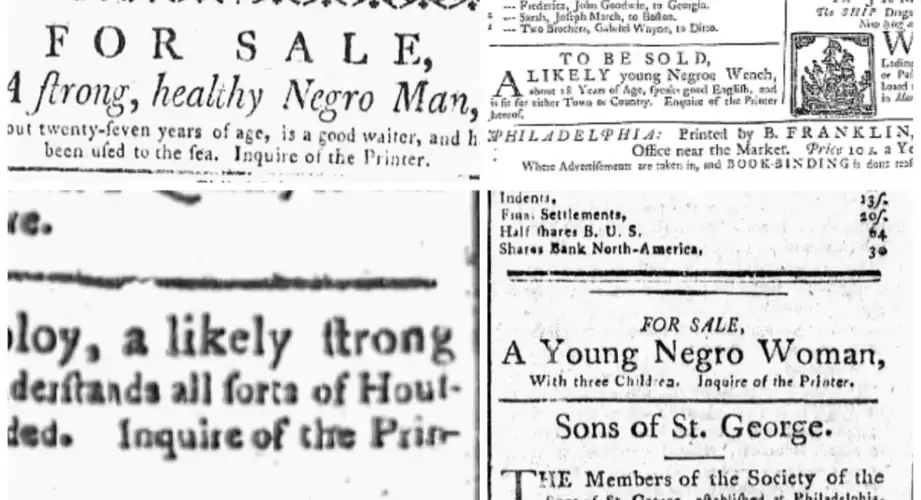
Newspapers were produced really for a small, relatively elite audience, people middle class and above. Each issue contained advertisements, which usually took up a third to half of the total space. These could include merchants and vendors, government notices, and notices searching for runaways (which included servants, the enslaved, horses and other animals, and the occasional wife). The rest of the paper was devoted to political and commercial news from the British empire, in particular from London, other colonies, and a small section devoted to local news. — Joseph Adelman
Papers weren’t always profitable, or even often so. Readers failed to pay subscriptions; some journals died after only a few issues. One early financial lifeline was text-based ads, which read like Craigslist for a slaveholding public: “I wish to buy a few negroes, of both sexes, and will pay fair prices in cash,” one typical ad read. Citizens purchased ads to talk, in Twitteresque fashion, to the world. In 1751, William Beasley took out a Virginia Gazette classified to complain about his cheating wife—“I am really of [the] opinion she has lost her senses”—and warn people not to consort with her. — Clive Thompson/Smithsonian Magazine
Like European history, the predecessors of newspapers as we know them today can be traced through Indian history. A fascinating example is that during the reign of Emperor Ashoka, various administrative departments would send reports to the emperor and the council of ministers. Courts employed writ writers who would write edicts and proclamations issued by rulers. These would also be spread orally through official messengers. The Mughals had news writers tasked with sending reports from various regions of the empire to the headquarters.
Portuguese missionaries brought the first printing press to Goa in 1566. The British East India Company installed printing presses in Bombay in 1674, Madras in 1772, and Calcutta in 1779. William Bolts attempted to start the first newspaper in Calcutta in 1776, but concerned officials ordered him to stop and leave for Europe. The Bengal Gazette, or “Hicky’s Gazette,” became the first newspaper in India. Hickey earned the wrath of the British, and he went broke eventually.
After the Bengal Gazette, the Indian Gazette, the Calcutta Gazette, the Bengal Journal, and the Oriental Magazine or Calcutta Amusements launched, Unlike Hickey, these papers operated under the patronage of the British government. Most papers during this period were started by disgruntled British employees. The papers weren’t influential because the circulation was limited to a few hundred copies.
In 1791, the United States ratified the Bill of Rights, which included the First Amendment guaranteeing freedom of speech and press. This informed the debates about freedom of the press around the world for decades to come.
> So far, I have tried to highlight the key events in the evolution of newspapers in Europe, the United States, and India. If you’ll bear with me, I want to take a detour and continue with the development of newspapers in the United States. This is not because I secretly long for an H-1B visa but because the United States is the world’s biggest media ecosystem. The industry trends in the United States are also far more advanced than in any other country.
There’s always a temptation to superimpose trends from the West on complex markets like India, but I will resist that. Having said that, looking at what’s happening to American publishers is informative. Indian media and U.S. media might not be mirror images. Still, many broader challenges and trends, like the decline of print, the growth of digital, and the preference for online and social news sources among young people, are the same.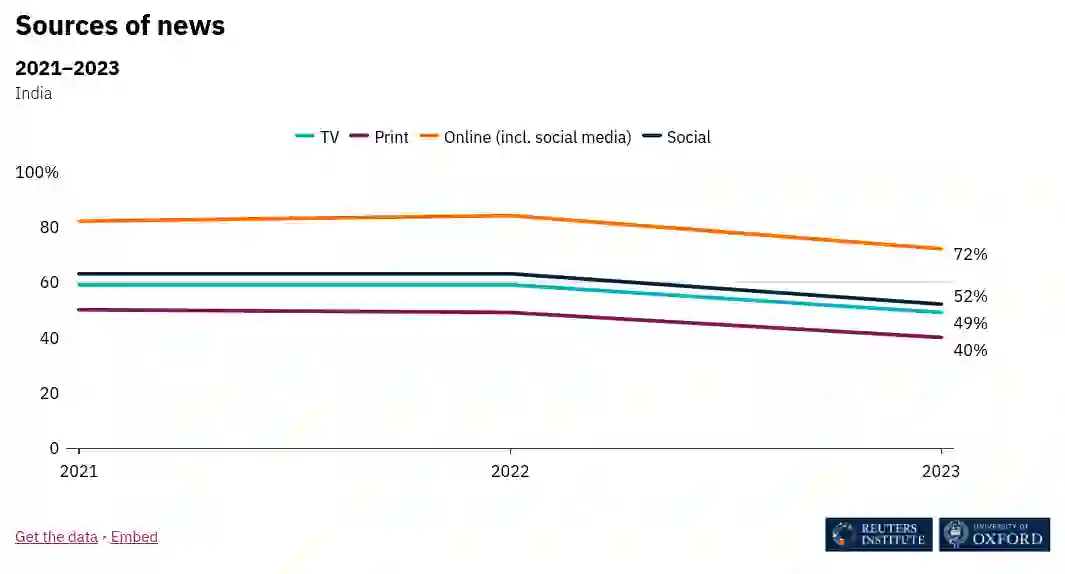
> Media observers often hold out the scenario of an ‘Americanisation’ or convergence upon a United States-like media system (Davis 2002; Hallin and Mancini 2004). Little in the evidence reviewed here suggests that this is a likely outcome of current developments. In fact, many American commercial legacy news organisations seem to be facing a more serious crisis than their counterparts elsewhere, and it is by no means certain that this is simply a precursor for things to come around the world. The United States may well be more of an exception and less of a forerunner than is sometimes assumed in discussions of international media developments.
The Changing Business of Journalism and its Implications for Democracy
The American press from the late 1700s until well into the 19th century is indistinguishable from today’s press. Newspapers of that era often exchanged their papers with each other and reprinted select content from other papers with or without attribution. In a way, this was the early version of blogging.
The United States declared its independence in 1775 but was still discovering its feet as a young nation. America didn’t yet have today’s two-party system. George Washington was unanimously elected president for two terms. In fact, the founding fathers were all against the idea of multiple political parties and warned against partisan divisions.
The American press of that era flourished not only because of the government’s steadfast belief in a free press but also because of the profound and virulent differences between Alexander Hamilton and Thomas Jefferson, two of the most influential leaders. Both had irreconcilable views of what the young republic should aspire to. Abusing one another in person was ungentlemanly, so these differences played out in the press directly and through proxies.
Notions of objectivity and fairness weren’t even part of the lexicon. The American press of the era was bitterly partisan and divisive. They openly identified with political parties. Newspapers and political parties were tied at the hip.
Newspaper printing on its own wasn’t enough to make money. Political parties funded loyal newspapers and bailed them out when they were in trouble. Printers were rewarded with lucrative government printing contracts, jobs, and political appointments for their support. In many ways, the party press of the era flourished in large part due to the bitter rivalry between Hamiltonian Federalists and the Jeffersonian Democratic-Republicans. Leaders from both parties used papers loyal to them overtly and covertly to attack each other.
The government also helped fledgling newspapers by subsidizing postal charges. Newspapers sent to regular readers received a 90% postal subsidy, while postage was free if the papers were sent to other editors and newspapers. This enabled the exchange system I mentioned earlier and helped spread the news across the country.
This early phase of the development of America gave a preview of the treacherous complications of guaranteeing free speech. Facing the prospects of a war with France in 1798, Federalist President John Adam signed the Alien and Sedition Acts into law, making it illegal to say or print anything against the government. Newspaper editors supporting the democratic republicans opposed the bill and willingly provoked the government to get arrested so that they could draw attention to the government’s abuses. The editors channeled this attention and outrage to their benefit, and in the election of 1800, John Adams was defeated, and Thomas Jefferson was elected president.
The naked partisanship wasn’t the only difference between newspapers in the 1800s and today. The early newspapers were colorful and didn’t subscribe to the notion of civility. The election of the 1800s was one of the dirtiest election campaigns in the history of the United States. The political distrust and animosity played out in the press, leading to some memorable insults. Our politics today could use a bit of the color of the 1800s.
Things got ugly fast. Jefferson's camp accused President Adams of having a "hideous hermaphroditical character, which has neither the force and firmness of a man, nor the gentleness and sensibility of a woman."
In return, Adams' men called Vice President Jefferson "a mean-spirited, low-lived fellow, the son of a half-breed Indian squaw, sired by a Virginia mulatto father."
As the slurs piled on, Adams was labeled a fool, a hypocrite, a criminal, and a tyrant, while Jefferson was branded a weakling, an atheist, a libertine, and a coward.
John Adams and his people for their part were already spreading rumors that Thomas Jefferson was sleeping with slaves in Monticello (which in fact he was). They also used one of my favorite all-time slurs in American election campaigns by simply saying, ‘Well, you can’t vote for Thomas Jefferson because he’s dead. And how can you vote for a dead man?’”
While they didn’t get as much attention, magazines and periodicals were also developing, along with newspapers. Johann Rist, a German theologian and poet, is credited with publishing the first magazine Erbauliche Monaths-Unterredungen, or Edifying Monthly Discussions. By the 18th century, like newspapers, magazines were growing in popularity.
Until the 1830s, newspapers cost about six cents, and the poor and the working class were priced out. All that changed in 1833 when Benjamin Day launched The Sun, a tabloid-style paper priced at one cent. Falling paper costs and the new steam printing press technology made it possible to produce more papers at a lower cost. The Sun was supported by advertising. Unlike the six-cent papers supported by political parties that catered to the “elite,” The Sun focused on general interest stories, crime, gossip, and scandals that entertained the masses. These penny papers introduced newspapers to the masses. Soon, other penny papers started with varying degrees of success.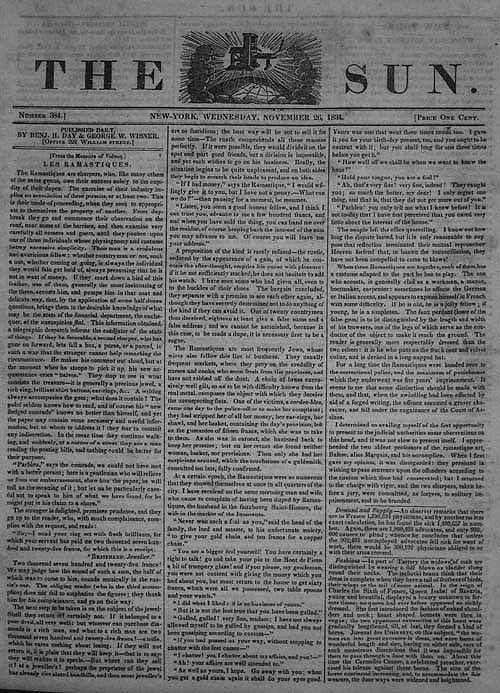
Some historians describe the penny press as a revolutionary step in the evolution of newspapers, but the reality is much more prosaic. Media scholar John Nerone argues that penny papers were a step in the natural evolution of newspapers, and there wasn’t anything revolutionary about them. Since penny papers were supported by advertising, they claimed to be independent. In reality, American newspapers remained partisan well into the 19th century.
The spread of fake news on the internet has become a major concern today, but it’s nothing new. Early American newspapers had a tenuous relationship with the truth. Newspaper publishers weren’t above making shit up to sell papers. One of the most famous made-up stories to have ever been published is the six-part series in The New York Sun on the presence of life on the moon. The series depicted a fantasy lunar world full of forests, oceans, unicorns, bipedal beavers, and conversational man-bats. The story spread like wildfire across the United States and Europe.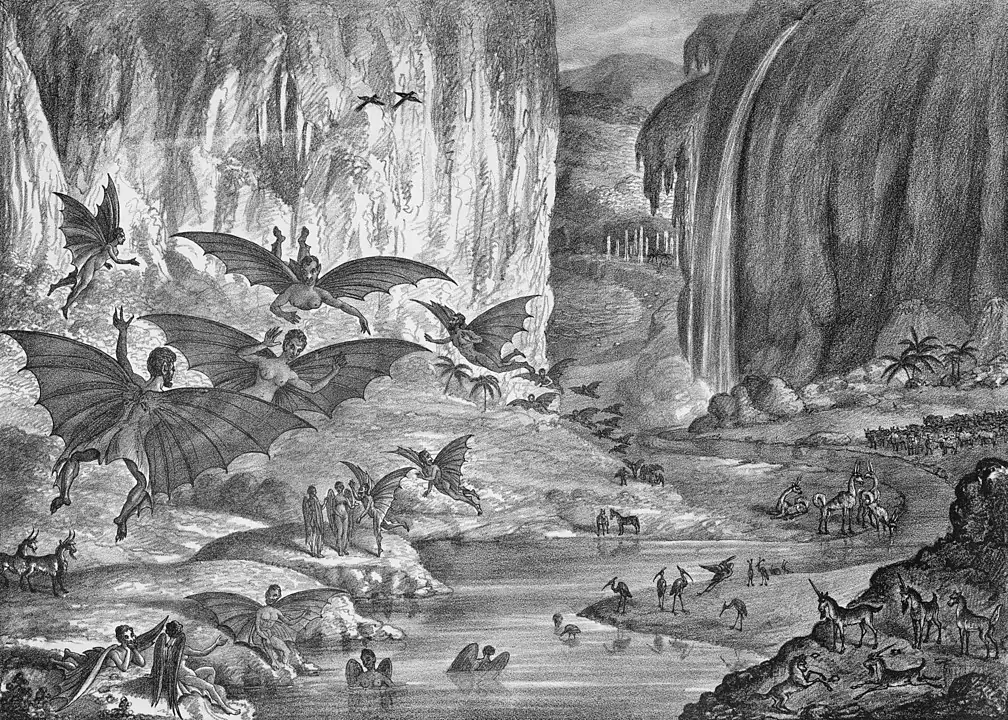
In Pirates of the Caribbean: Dead Man’s Chest, there’s a scene where Tom Hollander, who plays Cutler Beckett, tries to coerce William Turner to find Jack Sparrow and recover the compass from him. Beckett says:
Will Turner: Somehow I doubt Jack will consider employment the same as being free. Lord Cutler Beckett: Freedom! Jack Sparrow is a dying breed. The world is shrinking. The blank edges of the map filled in. Jack must find his place in the new world or perish.
“What hath God wrought!”
That was the first telegraph message sent by Samuel Morse. With that message, the world became a smaller place. This reminds me of another scene from Pirates of the Caribbean: At World’s End:
Barbossa: The world used to be a bigger place. Jack Sparrow : World's still the same. There's just less in it.
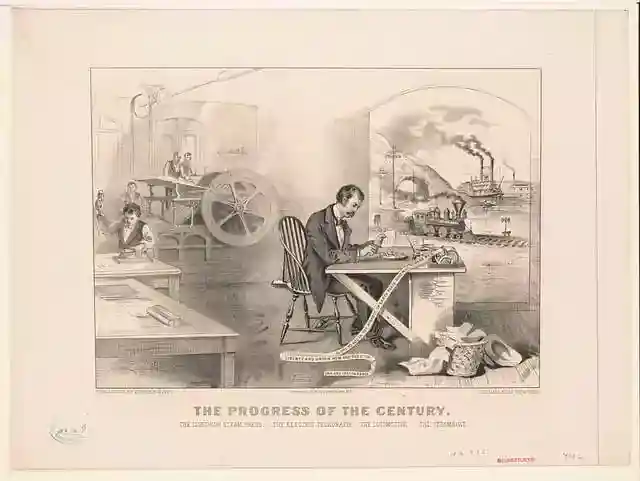The first transatlantic cable was laid in 1858 but failed within weeks. By 1861, the transcontinental telegraph line had been completed, connecting the Atlantic and Pacific coasts. In 1861, a third cable was successfully laid after another failed attempt between Ireland and Canada. With that, transatlantic communication became possible.
The world was never the same again.
The impact of the telegraph on newspapers was dramatic. The telegraph helped newspapers transcend physical limitations and transformed the business of news. Journalist Tom Standage called the telegraph the Victorian internet in his book of the same title. Thanks to the telegraph, newspapers no longer had to publish stale news. They could gather breaking news from across the world. Several large newspapers began publishing multiple editions in a day by updating the same paper with the latest news.
Today, we lament that news has become entertainment, but this bellyaching is due to a lack of historical memory. The impulse to sensationalize news has been a constant throughout the history of news. In the aftermath of the telegraph, newspapers maintained public bulletins outside their offices that would be updated day and night with telegraphic updates. Some papers used to project cartoons between election updates, and some even hired artists to enact news events.
Collecting news and using a telegraph to transmit it was costly. In 1846, five New York City newspapers agreed to share expenses to gather news, and the Associated Press (AP) was created. The AP used everything from pigeons and ponies to row boats to intercept European ships to collect international news and transmit it over the telegraph. Over its 177-year history, the AP has been a witness to the first draft of history. In 1850, Paul Julius Reuter used pigeons to deliver stock prices between Brussels and Aachen due to a gap in telegraph lines. In 1851, he moved to London and started Reuters, the other famous wire service. In a short span, wire services became important suppliers of news for newspapers.
A confluence of factors led to the dramatic growth of newspapers from the 1850s. As the century progressed, railroads spread across the United States. This opened up new economic opportunities, enabling enterprising settlers to tame the vast wild lands. The completion of the transatlantic cable in 1861 made long-distance communication easy. As territories spread, factories and transportation systems expanded. Another important enabler for the proliferation of newspapers was the US postal system. Postal coverage spread throughout the 1880s, and newspapers enjoyed preferential rates.
During the same period, literacy rates in the United States rose as the number of schools and colleges increased. Advances in printing technology reduced the cost of printing and increased the output. Since the invention of the Gutenberg press, the printing press had remained unchanged. The wooden presses required considerable force and were prone to breaking. This changed in the 1800s.
Early 1800: Charles Mahon (Earl of Stanhope) is credited with building the first iron printing press. This increased the output to 200–400 pulls per hour.
1810: Frederick Koenig and Andreas Bauer patented a steam-powered cylindrical printing press. In 1814, The Times in London printed the first newspaper with this design, capable of printing 1100 sheets per hour.
1846: Richard Hoe creates the revolving press that can print up to 8,000 sheets an hour. The output improves to 20,000 sheets with further enhancements.
1863: William Bullock improves on Richard Hoe’s rotary press to create a press that can print 12,000 sheets on both sides. Later improvements raised this number to 30,000.
1886: Ottmar Mergenthaler invented the Linotype automatic typesetting machine that revolutionized printing. It removes the need for manual typesetting, thereby speeding up printing.
Despite all these advancements, newspapers weren’t cheap. They cost 4-6 cents at a time when the average wage of a worker was one dollar. Newspapers remained an elite affair. The major obstacle stopping newspapers from reaching the masses was the cost of printing.
Until the 1870s and 1980s, paper was made from used clothes and rags. As printing technologies improved, the demand for paper increased, but rags were in short supply. In the 1850s, many countries banned rag exports, which sent prices shooting up. But in the late 1860s, inventors figured out a way to make paper from wood pulp, and the price of paper fell. This kick-started the era of mass newspapers catering to the long-neglected working class.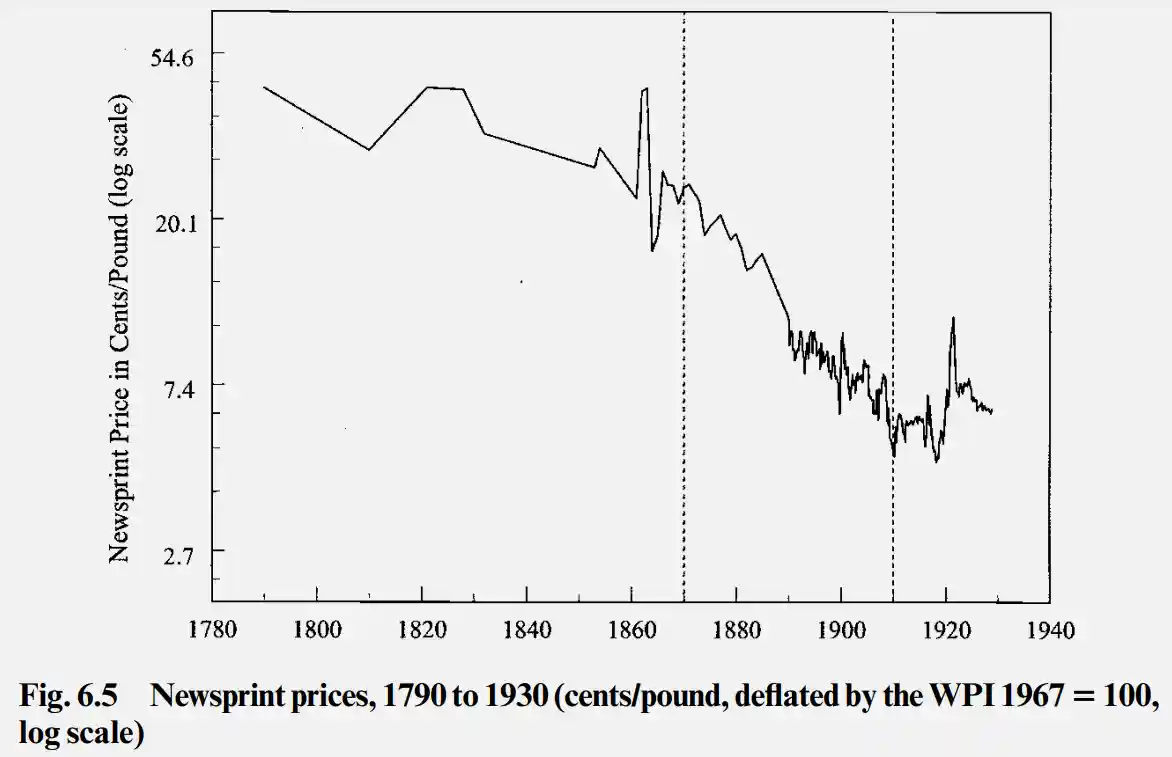
As print technologies improved, communication technologies improved as well.
“Mr. Watson – Come here – I want to see you.”
Those were the words on the first telephone call on March 10, 1876, between Alexander Graham Bell and his assistant Thomas Watson.
Twenty years ago, America invaded Iraq based on the lies that Saddam Hussein was developing mass destruction (WMDs) and had links to al-Qaeda. All the major news outlets became cheerleaders for the Bush administration and helped sell the war to the American public. Over half a million people died, and the war cost the United States over $3 trillion. This wasn’t the first time the American media was complicit in warmongering.
In 1895, the Cuban War of Independence broke out. This was when the rivalry between Joseph Pulitzer’s New York World and William Randolph Hearst’s New York Journal hit a fever pitch. The press barons were battling each other for supremacy, and their papers featured lurid and sensationalist stories to increase circulation. Both saw the Cuban War as an opportunity to achieve dominance.
Throughout the 1890s, both papers published exaggerated and even downright false stories. They were agitating for war, pushing the United States to intervene in Cuba. The term “yellow journalism” was coined to describe the sensationalist style of news. In 1898, the US invaded Cuba, defeated the Spanish, and liberated Cuba. Some historians attribute the invasion to warmongering by the press, but others argue that while the press played a role in the decision to invade by swaying sentiment, they weren’t the cause.
At the turn of the 19th century, the United States was entering the second industrial revolution. The economy was booming thanks to expanding transportation, expansion of cities, immigration, new communication technologies, and advancements in manufacturing technologies.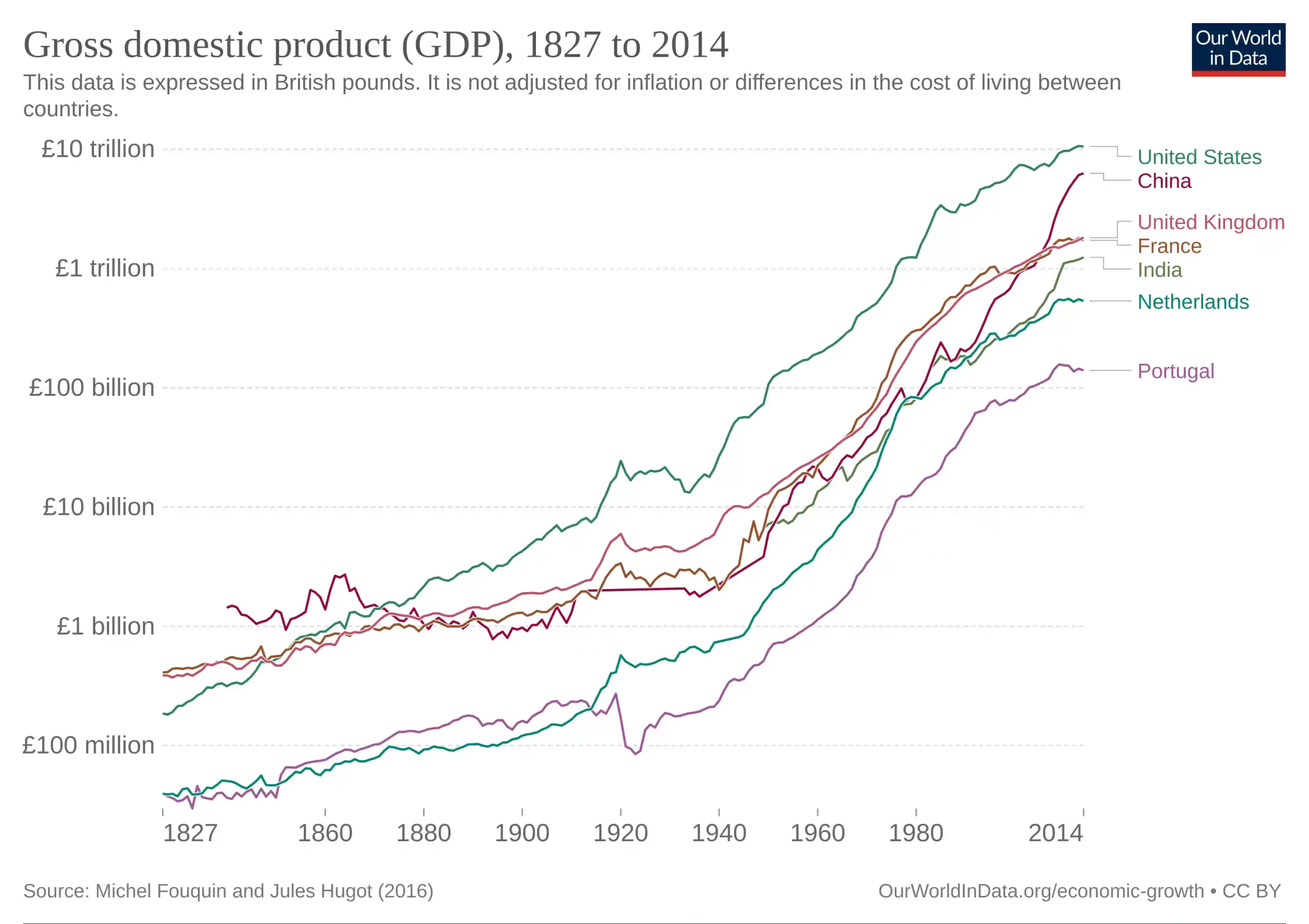
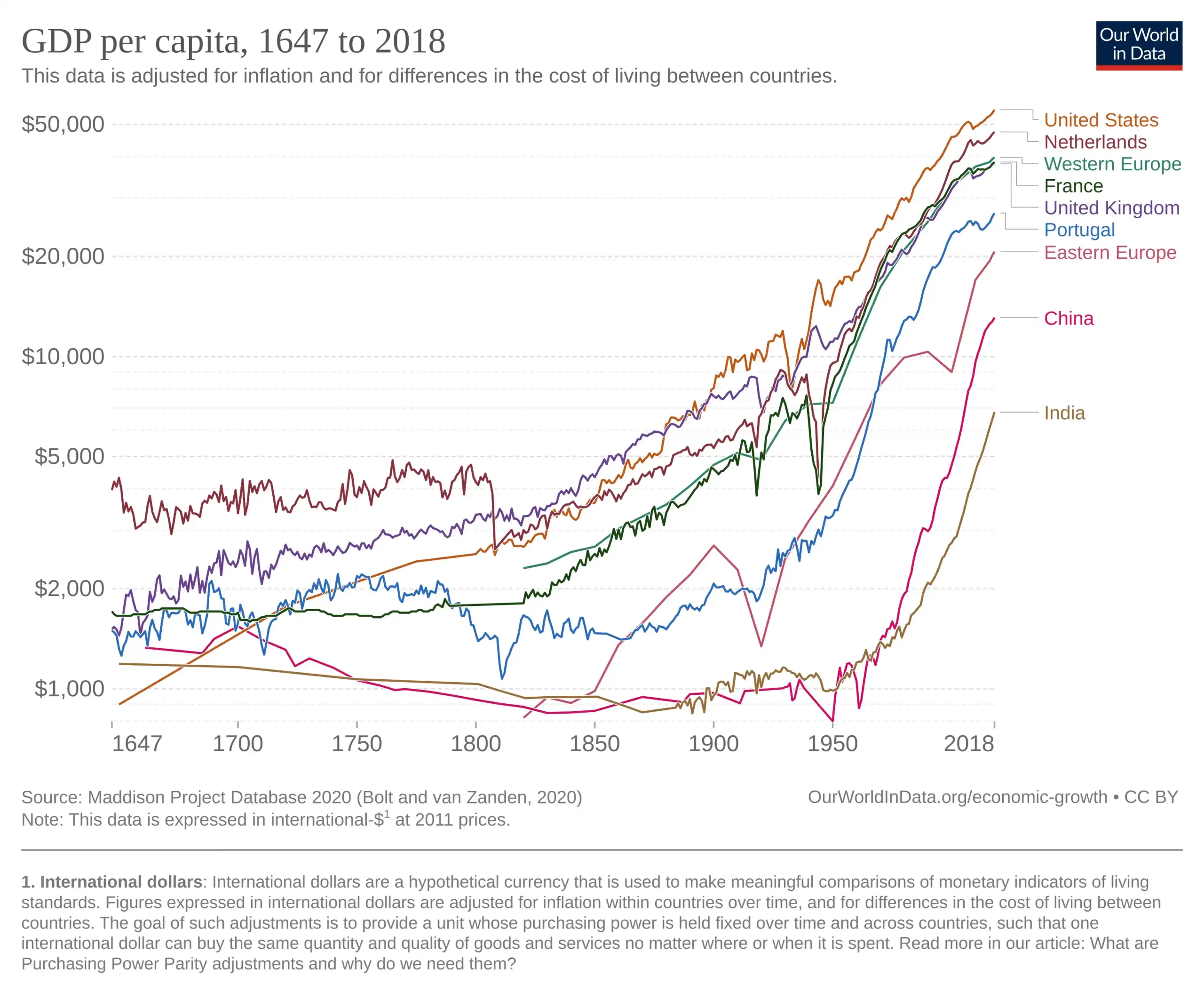
A key development that unleashed the ravenous spirit of capitalism was the development of the concept of limited liability in the mid-1800s. Before this period, there was no concept of limited liability, and all shareholders were personally liable. Limited liability enabled a new breed of corporations to raise money from the public. This, along with the other factors, supercharged the transition of the United States from an agricultural to a manufacturing economy. Individual and family-owned businesses gave way to large corporate entities.
As the American economy was taking off, so was mass consumerism and the demand for advertising. In 1841, Volney Palmer started a real estate agency in Philadelphia, looking to make a living. Business was dull because the city was in the throes of a depression. Palmer soon started a coal agency, an unlikely addition to the real estate business, but times were tough.
In 1842, he started a newspaper advertising business after spotting an opportunity when he saw underutilized ships and canals. He entered into contracts with newspapers to sell their advertising space, becoming, in essence, a newspaper advertising agent. He drummed up business by convincing manufacturers to sell their wares in other places by taking advantage of the empty ships and canals. While there were many failed attempts, many historians recognize Volney Palmer’s operation as the first advertising agency.
The number of newspapers grew exponentially from a few hundred in the 1700s to more than six thousand by the 1870s. Thanks to the growing economy. There was tremendous demand for advertising. Display advertising demand rose as railroads enabled companies to reach consumers across the United States. America imported the department store format from Europe, and retail advertising demand exploded. Advertising as a proportion of newspaper and magazine revenue rose from 44% in 1879 to 54.5% in 1909, reaching 60% by 1909.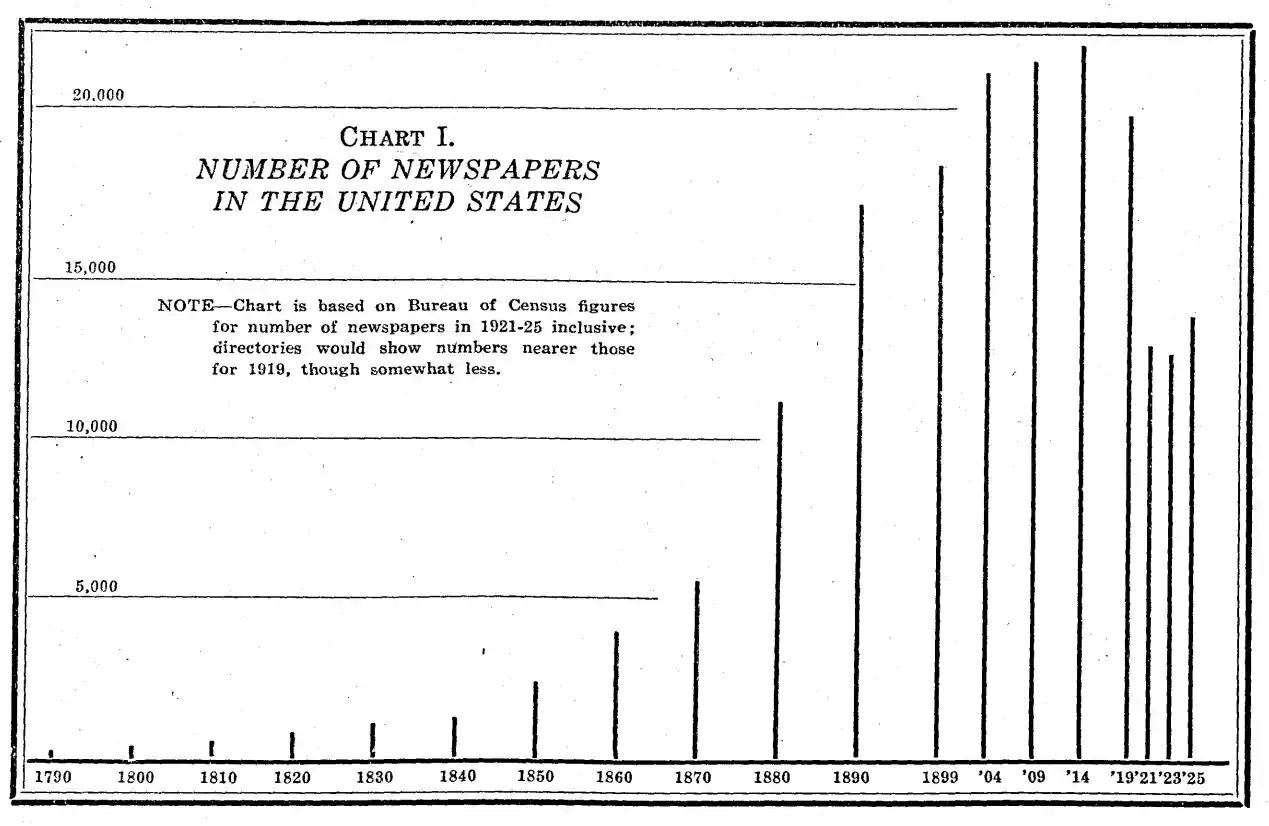
From the 1850s, the United experienced dramatic and volatile economic growth. The shaded areas represent recessions.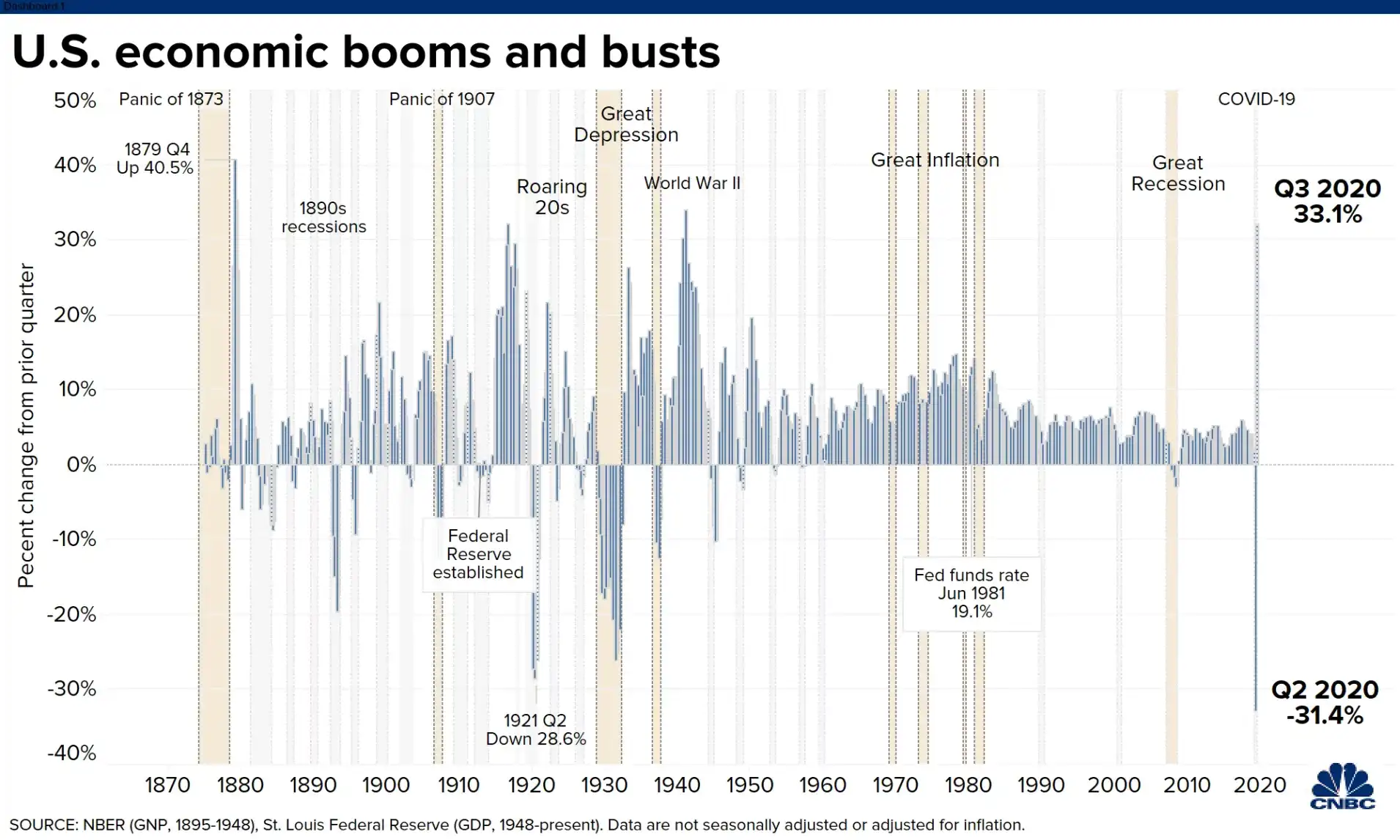
Technological advancements led to a shift from small businesses to large companies. The boom and bust cycles of the period led to rapid production, overcapacity, and ruinous competition. The excessive competition led to a sharp drop in prices and profitability and precipitated consolidation among large swathes of the industry. The United States saw the largest merger wave in history from 1895. About half of the manufacturing industry may have participated in the mergers.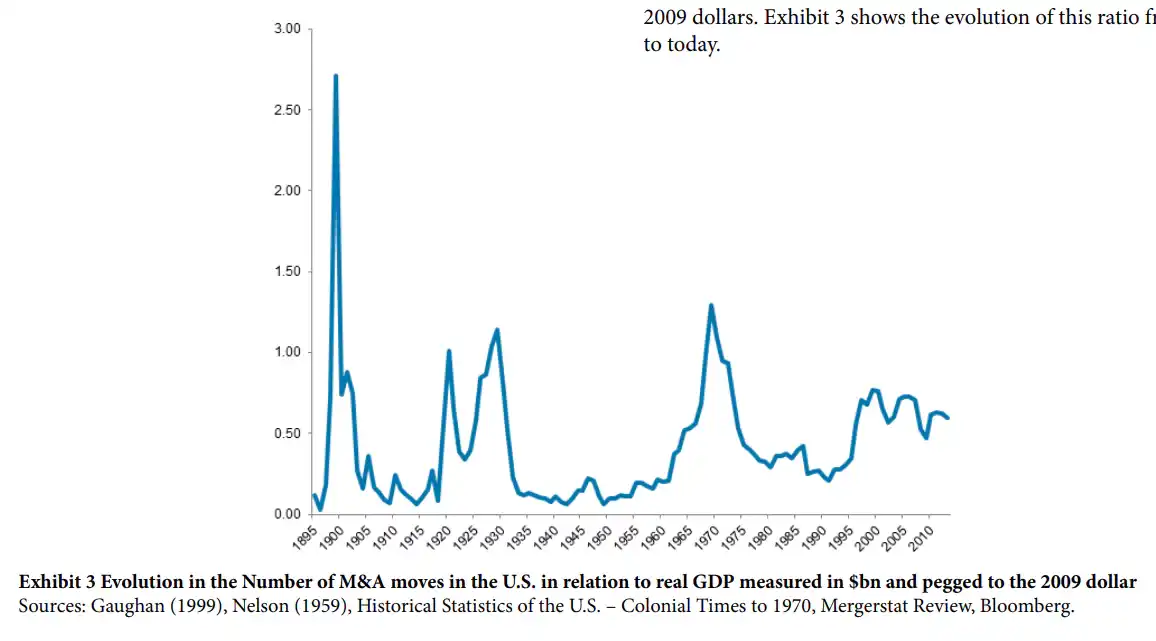
People like John D. Rockefeller, Cornelius Vanderbilt, and Andrew Carnegie emerged as the greatest tycoons America had ever seen. They used brutal tactics such as collusion, cartelization, political capture, and stock price manipulation to crush competition. They had near monopolies on oil, railroads, and steel at their peak. Major industries like coal, sugar, whiskey, tobacco, and meatpacking used trusts to integrate vertically and horizontally. These trusts had near total control over the industries they operated in. John D. Rockefeller’s Standard Oil was the poster child of this era. It controlled 90% of American oil refineries.
Ida Tarbell saw Rockefeller’s brutal tactics when he destroyed her father’s fledgling oil business at 14. Despite studying biology, she discovered her love for writing and became a journalist. Working at McClure’s magazine, she started to publish a mammoth expose of Standard Oil, beginning in 1902. Over 19 parts, she laid bare the machinations of the oil refining giant and its brutal practices. Her dogged work was responsible for the eventual breakup of Standard Oil in 1911. The Standard Oil series is still considered one of the finest examples of investigative journalism.
In reading the history, it wasn’t surprising to me that the role of women in newspapers was ignored. Even as America grew, attitudes about women remained rooted in the dark ages—a woman’s place was at home.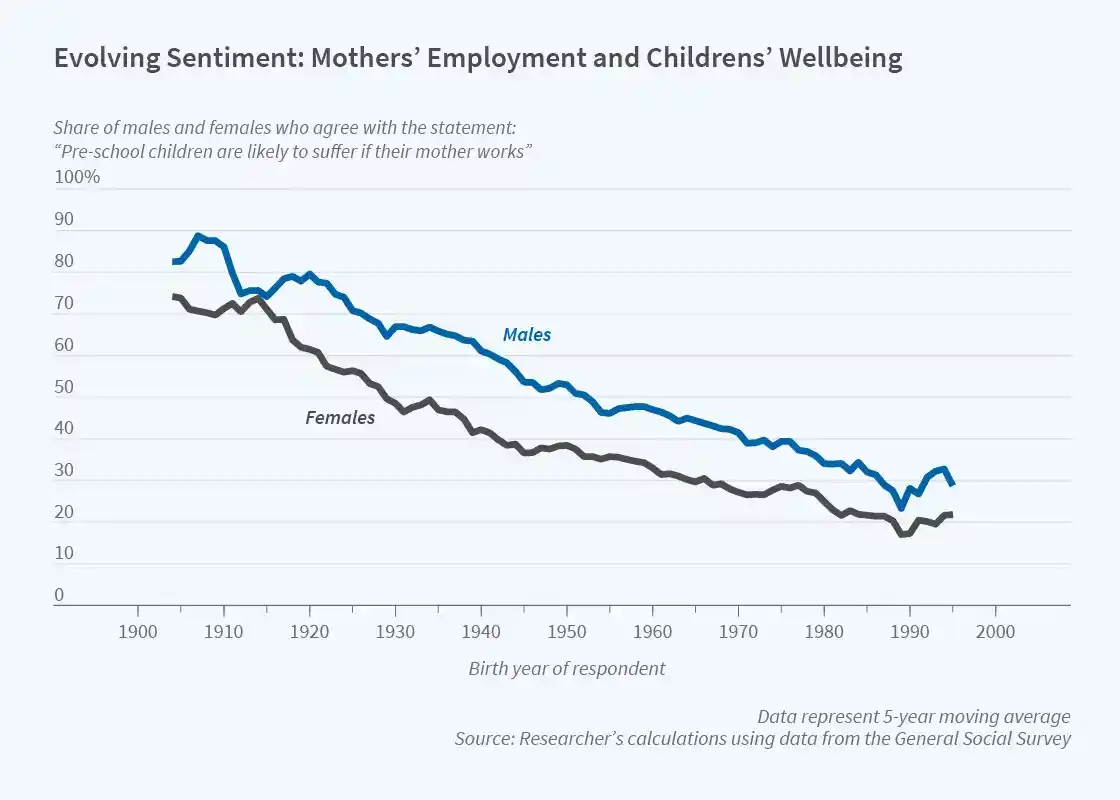
Despite the conservative views, several trailblazing women worked as investigative reporters, writing about important issues under pseudonyms:
> The young woman was one of the nation’s so-called girl stunt reporters, female newspaper writers in the 1880s and ’90s who went undercover and into danger to reveal institutional urban ills: stifling factories, child labor, unscrupulous doctors, all kinds of scams and cheats. In first-person stories that stretched over weeks, like serialized novels, the heroines offered a vision of womanhood that hadn’t appeared in newspapers before—brave and charming, fiercely independent, professional and ambitious, yet unabashedly female.
Throughout the history of the United States, you can see the tension between the state and the press. While people consider America a beacon of free speech, that wasn’t always the case. In 1917, the United States entered the world war and, within weeks, passed the Espionage Act to stifle dissent. The law was amended in 1918 with the Sedition Act and had a chilling effect on free speech. Over 2,000 people were prosecuted under the law.
As circulation and advertising revenues grew, so did competition. Commercial interests forced newspapers to be less partisan. Rising advertising demand and revenues forced newspapers to appeal to the masses. Newspapers couldn’t afford to alienate their readers with partisan takes. From the late 1900s, the American press began its slow journey toward professionalization.
The share of political newspapers that claimed to be independent rose from 11 percent in 1870 to 62 percent in 1920.3 Another measure of bias is the use of charged language by the press. Negative words such as “slander,” “liar,” and “villainous” are used by papers to dismiss undesirable statements; words such as “honest,” “honorable,” and “irreproachable” are used to defend political heroes. Using textual analysis, we find a substantial drop in partisan and charged language across the late nineteenth and early twentieth centuries. The Rise of the Fourth Estate: How Newspapers Became Informative and Why It Mattered
The period from 1880 to 1990 was the golden age for American newspapers. Advancements in printing technologies, communications, and photography made newspapers even better, faster, and more visual. They enjoyed absolute dominance since they were the only mass medium for advertisers. Even during the Depression of the 1930s, newspaper circulation continued to rise.
But the roots of their troubles today can also be traced to this period. Like the telegraph, the radio also had many fathers. In 1920, KKDA, owned by Westinghouse Electric, became the first radio station to go on air. By 1930, about 45% of Americans had a radio set, and radio advertising had crossed $100 million. Between 1927 and 1930, radio advertising rose by seven times, and not even the Great Depression could put a dent. World War II further increased the popularity of radio, as people preferred getting the news about the war from radio to newspapers.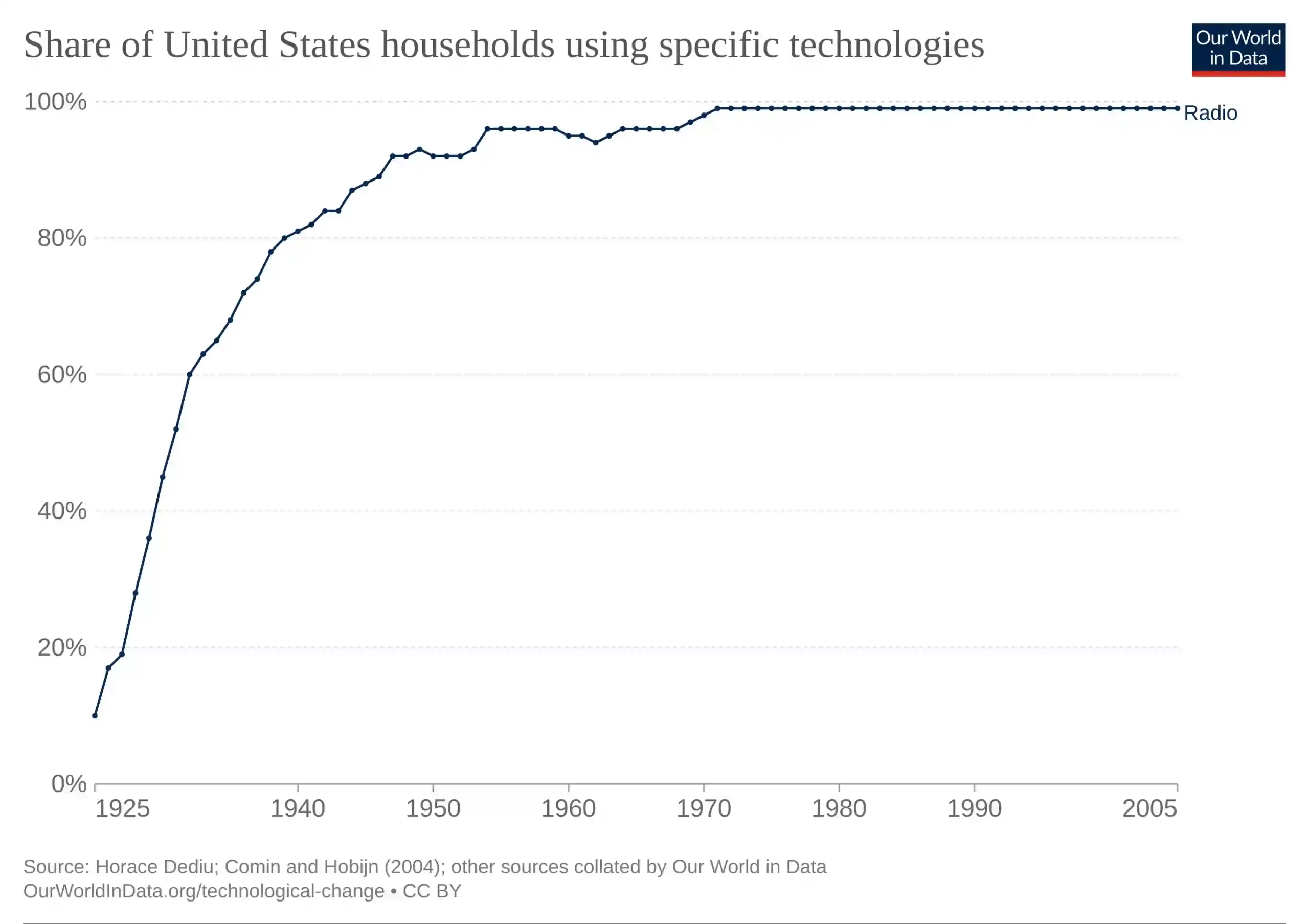
Though absolute circulation rose, the great depression of the 1930s was a death knell for many newspapers as advertising revenues fell by 40–45%. Several newspapers shut down; others slashed costs, cut salaries, and merged. The slow decline of newspapers started around this time.
U.S. advertising expenditures as a share of National Income had declined from a peak of more than four per cent in the 1920s to 1.5 per cent in 1945, then recovered in the post WWII era to just under three per cent in 1957, still shy of the pre-Great Depression peak
Aggregate Advertising Expenditure in the U.S. Economy: What’s Up? Is It Real?
Today, the plight of newspapers is so dire that governments are intervening to protect them. But people forget that they were the barbarians of yesteryear. In the early days, radio stations couldn’t gather news, so they read out the stale news from newspapers. They could, however, buy timely news from newswire services like the Associated Press (AP).
Newspapers felt threatened by the prospect of losing sales and advertising revenues. Since the AP was a cooperative owned by the newspapers, it was forced to stop selling news to radio broadcasters. In a failed attempt, newspapers even tried to collude to stop radio broadcasters from broadcasting news.
Like the telegraph and the radio, the invention of television was the result of the efforts of many scientists and engineers in the 1800s and 1900s. There were experimental broadcasts starting in the 1920s, but the first regular broadcast began in 1939 by the National Broadcasting Company (NBC).
By 1955, 60–70% of US households had a television. From $128 million in 1951, TV advertising spending hit $1 billion in 1955. Television started to take some advertising away from newspapers. It’s easy to overextend this assumption of TV hurting newspapers, but one has to be careful. It’s important to remember that television advertising and newspaper advertising are imperfect substitutes.
> In 1952, 6 percent of all advertising spending, or $454 million, went to television ads; by 1960, $1.6 billion, or 13 percent, did.
American newspapers started feeling the heat with the rise of radio and television. Newspapers didn’t know it at the time, but their fortunes had turned. The other important trend throughout the 1900s was consolidation. The number of newspapers hit a peak in 1909 and started declining. There was a corresponding rise in the number of newspaper chains. By 1933, newspaper chains controlled 37% of all newspaper circulation.
Unlike the pre-Civil War era, running a newspaper was no longer an amateur operation. Installing printing presses, purchasing real estate, and setting up distribution required massive capital investments. Cutthroat competition for readership in the 1900s further complicated things. Fixed costs continued to rise as printing technologies advanced throughout the 1990s. These upfront costs created entry barriers for new newspapers, and they enjoyed significant pricing power and obscene profit margins due to their reach.
The 1950s were a tipping point for the American newspaper industry. A series of unfortunate coincidences set the stage for massive consolidation. As World War II ended, the United States lifted the wage freezes imposed in 1942. The pent-up demand led to a massive inflationary shock and sent newspaper production costs spiraling. This was a precipitating factor for consolidation.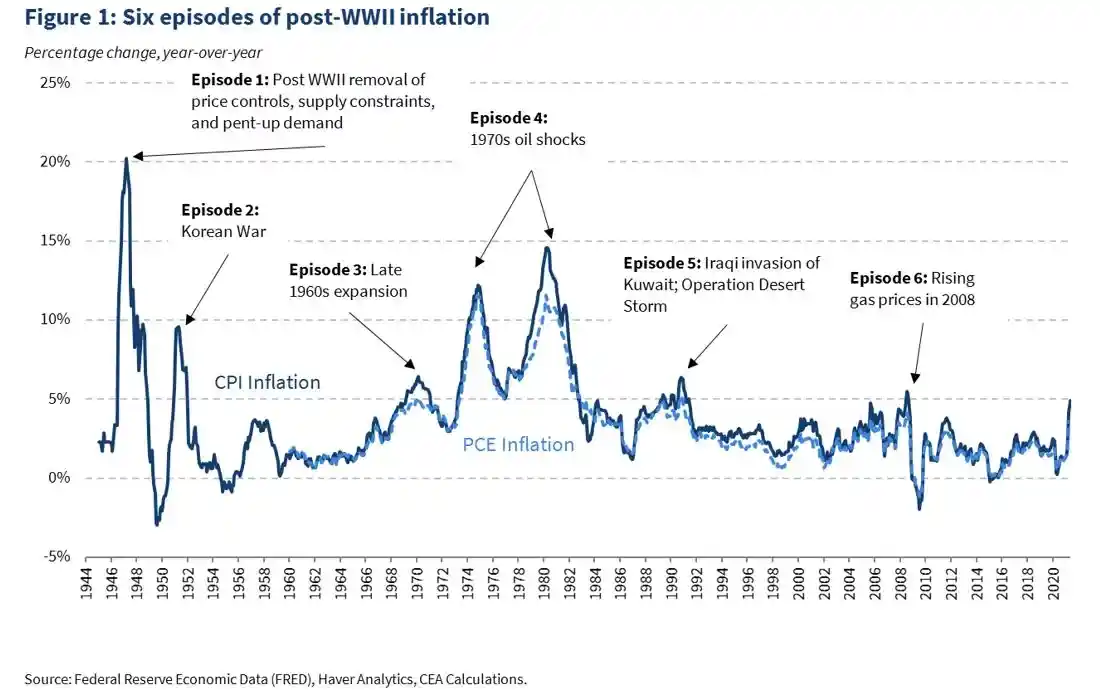
The soaring newspaper profits caught the attention of the Internal Revenue Service (IRS). The IRS changed the appraisal methodology of newspaper companies from book value to market value around this time. This change made it impossible for many independent newspaper owners and their heirs to pay the new taxes. They were forced to sell, and this led to the further consolidation of newspapers.
Even as newspapers consolidated, the quality of journalism remained high. Papers continued to invest in editorial.
Daniel Ellsberg, an analyst at the RAND Institute, leaked a classified study about US involvement in Vietnam to reporters at The New York Times and The Washington Post in 1971. The study showed that successive administrations had deceived the American public about the purpose and true cost of the war. The war was an epic disaster. This led to the Watergate scandal, which ended with the resignation of President Richard Nixon. In a high-watermark for American journalism, Arthur Sulzberger, chairman of The New York Times, and Katherine Graham, owner of The Washington Post, bet the entire house in a remarkable display of courage and published the leaked documents. The Nixon administration tried to stop the publication, but the US Supreme Court allowed the papers to publish in a landmark decision, affirming the freedom of the press. This period marked the birth of the adversarial American press.
The scale of the consolidation was stunning from the 1960s. In 1920, 92% of American newspapers were independently owned, and 42% of American cities had competing newspapers. By 1986, only 30% of the newspapers were independently owned, and only 2% of the cities had a competing newspaper. By 1970, 98% of US newspapers were monopolies, and the vast majority of cities had no competing papers.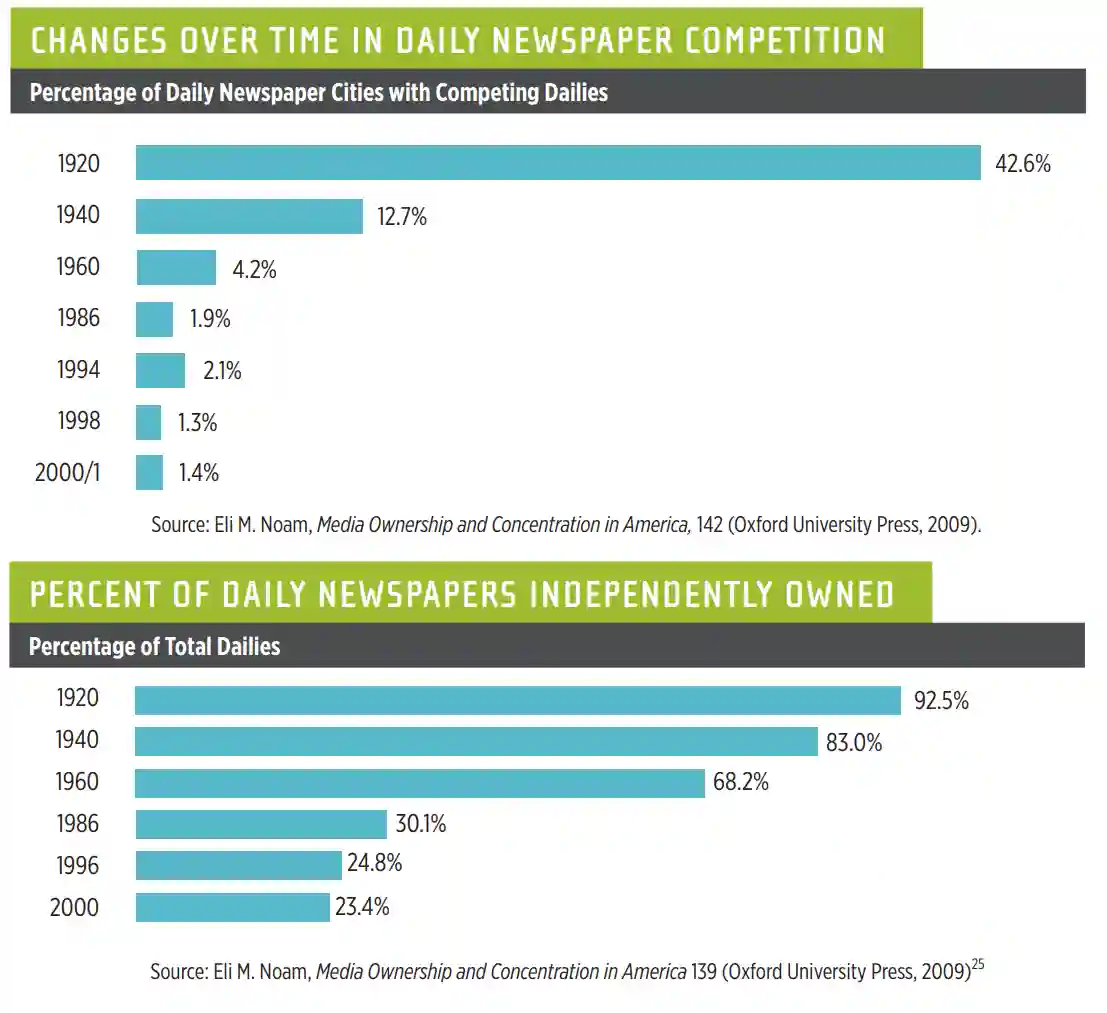
Large chains like Gannett, Knight Ridder, and McClatchy gobbled up these newspapers.
> Between 1960 and 1980, 57 newspaper owners sold their properties to Gannett Co. By 1977, 170 newspaper groups owned two-thirds of the country’s 1,700 daily papers. From 1969 to 1973, 10 newspaper companies went public, including the Washington Post Co., New York Times Co., and Times Mirror Co.
The U.S. Newspaper Industry in Transition
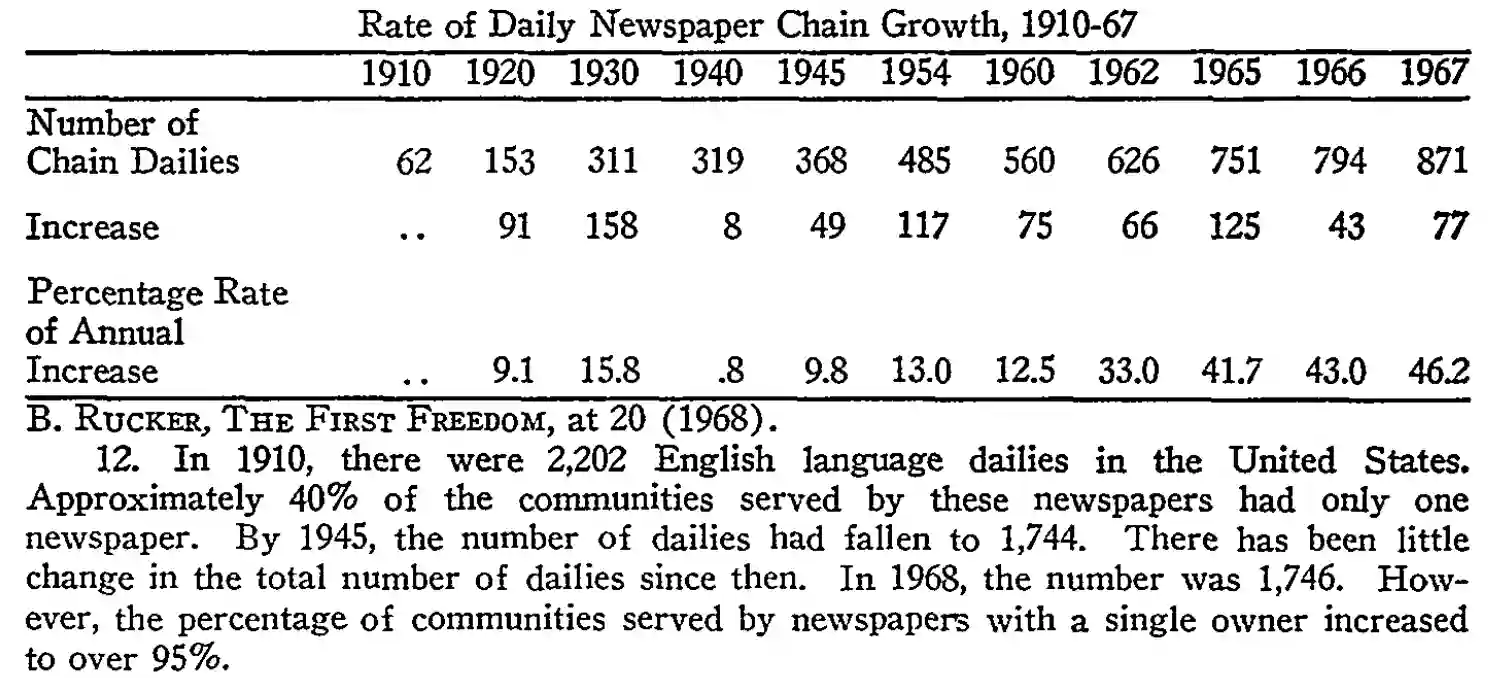
> At the beginning of the twentieth century, eight groups controlled just 27 journals. Led by Hearst and Edward Scripps that number climbed to 63 groups owning 328 papers by 1935. In the final decade of the century, 135 chains controlled 1,228 journals.
Ambarish Chandra and Ulrich Kaiser
Wall Street took note of the ludicrous profit margins and wanted a piece of the action.
Exactly how profitable are newspapers? At least as measured by operating margins, the answer is very profitable. (Operating margin is profit divided by revenue, before taxes. It is a way to define a company’s efficiency.) Using this measure, newspapers achieve profit margins about two to three times the average for U.S. manufacturing industries. (This is the category that newspapers are placed in by the Census Bureau.)
> The average operating margin for a U.S. manufacturing company in 1997 was 7.6 percent. The comparable average for publicly traded newspaper companies in 1997, according to Veronis, Suhler & Associates, Inc., was 19.5 percent. Gannett, often cited as an industry benchmark for profitability, achieved 26.6 percent in 1997. Some newspaper companies, such as The Buffalo News, owned by investor Warren Buffett, had margins that were in the 30’s. With the exception of television stations, which often enjoy operating margins of more than 45 percent, newspapers are hard to match for profitability among U.S. media investments. In the mid-1990’s, newspapers outperformed consumer magazine and book publishers, direct mail and promotional services, radio broadcasters, cable and pay-per-view networks.
The acquired papers were no longer owned by family owners with ties to their communities. They were Lego blocks in large listed corporations run by managers seeking efficiencies. Since they were listed on the stock exchanges, shareholders demanded continued profits. The American newspaper industry took a sharp left turn. Profits took center stage, and the quality of news became a distant priority. This quote by an analyst at Drexel Burnham in 1986 was telling:
John Reidy, who follows the newspaper industry for the securities firm Drexel Burnham Lambert Inc., said, "Properties in the right market are very attractive businesses on a long-term basis. . . . There is an increasing recognition that there is no electronic replacement for newspapers, and many see the attraction of doing business as the only newspaper in town."
The US Congress passed the Newspaper Preservation Act in 1970 to ensure the survival of newspapers. The law provided exemptions to antitrust laws by allowing newspapers to merge their production and commercial capabilities as long as they maintained separate editorial operations. The intuition was that this would maintain a plurality of voices and stop the inexorable rise of one-paper towns. The law essentially allowed papers to collude and fix prices with a legal sanction. It wasn’t enough.
> The Act grants participants in JOAs immunity from general antitrust laws and permits them to engage in such otherwise illicit practices as price-fixing, profit-pooling, and market allocation.
Joint Operating Agreements In the Newspaper Industry
> It’s an article of faith among some publishers and media observers that the internet is responsible for the newspaper industry's woes.
That’s a bald-faced lie.
As I mentioned earlier, the newspaper industry’s troubles predate the internet. Discussions about the problems of newspapers are accompanied by charts like this. You’ll hear people say everything was hunky-dory until the 2000s, and then the internet came and destroyed the poor newspapers. But headline numbers obscure a lot of the underlying trends. The popular canards are, well, stupid.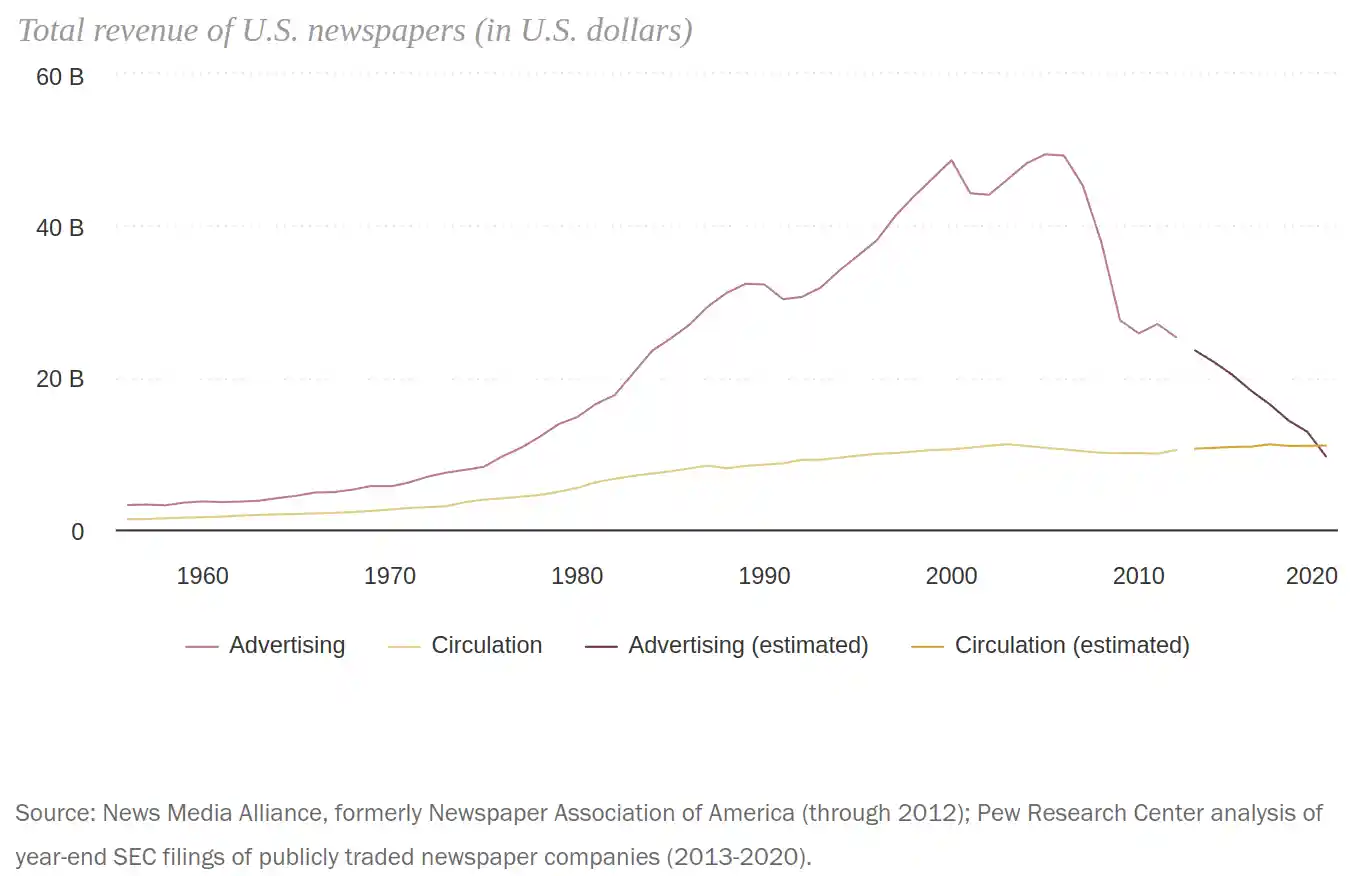
Tech observer and venture capitalist Benedict Evans had done yeoman’s work going back in time to collect numbers of American newspapers. Here’s the real story: newspaper circulation peaked in 1984 at 63.3 million copies and has been falling ever since. But the real story is that newspaper circulation per capita peaked around 1945. In other words, a smaller percentage of the population bought newspapers, even as the population grew.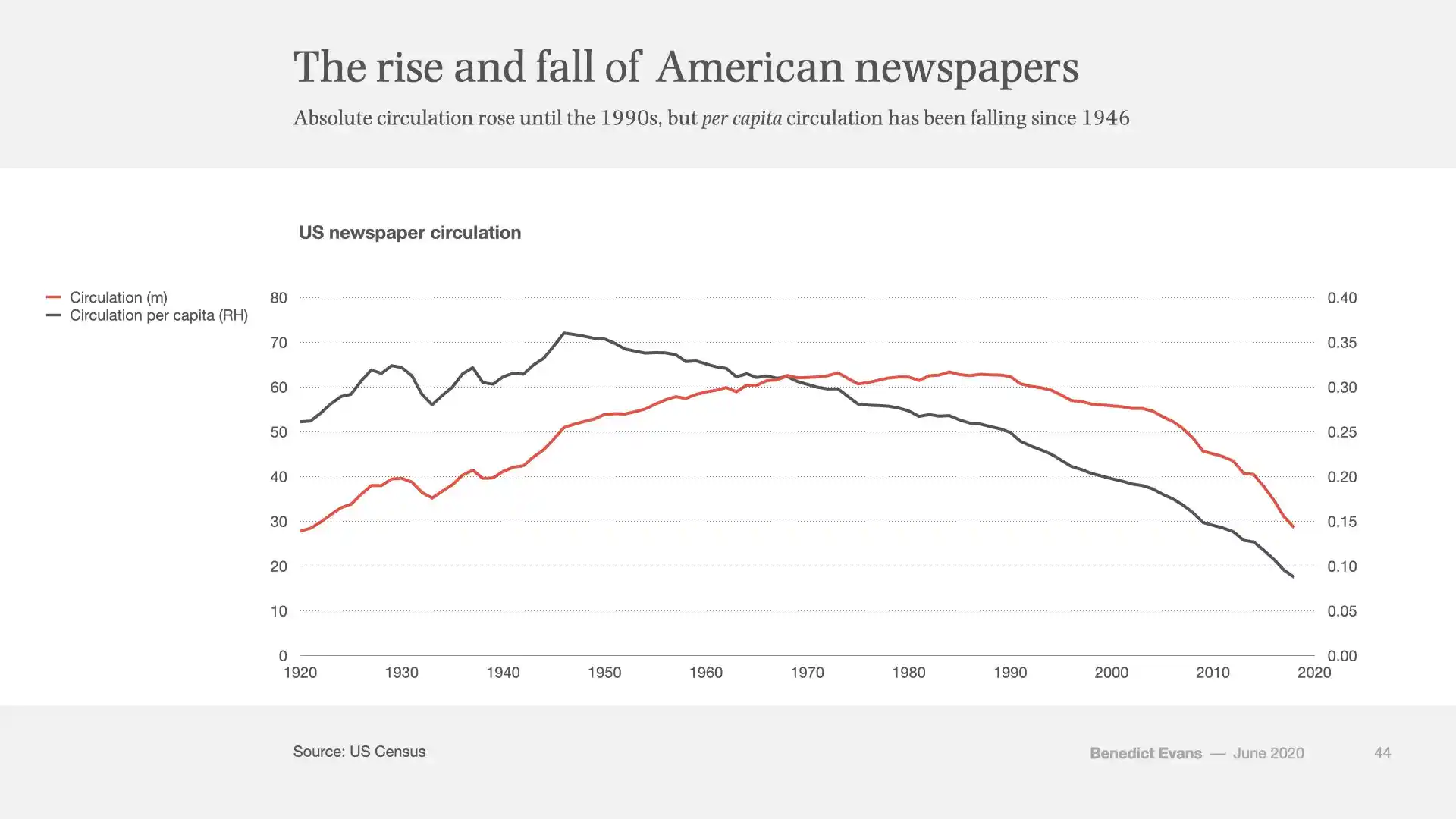
> On one hand, the dominance of newspapers has been diminishing for a long time. From 1940 to 2010, the number of daily newspaper subscriptions in America rose by 2 million—but the number of households increased by 83 million. Here is another way of looking at it: about as many Americans subscribe to newspapers today as did in the early 1940s, even though the number of households is more than three times larger.
The Federal Communications Commission (FCC)
Here’s a chart of advertising revenues, newsprint consumption, employees, total circulation, and per capita circulation indexed to 1950.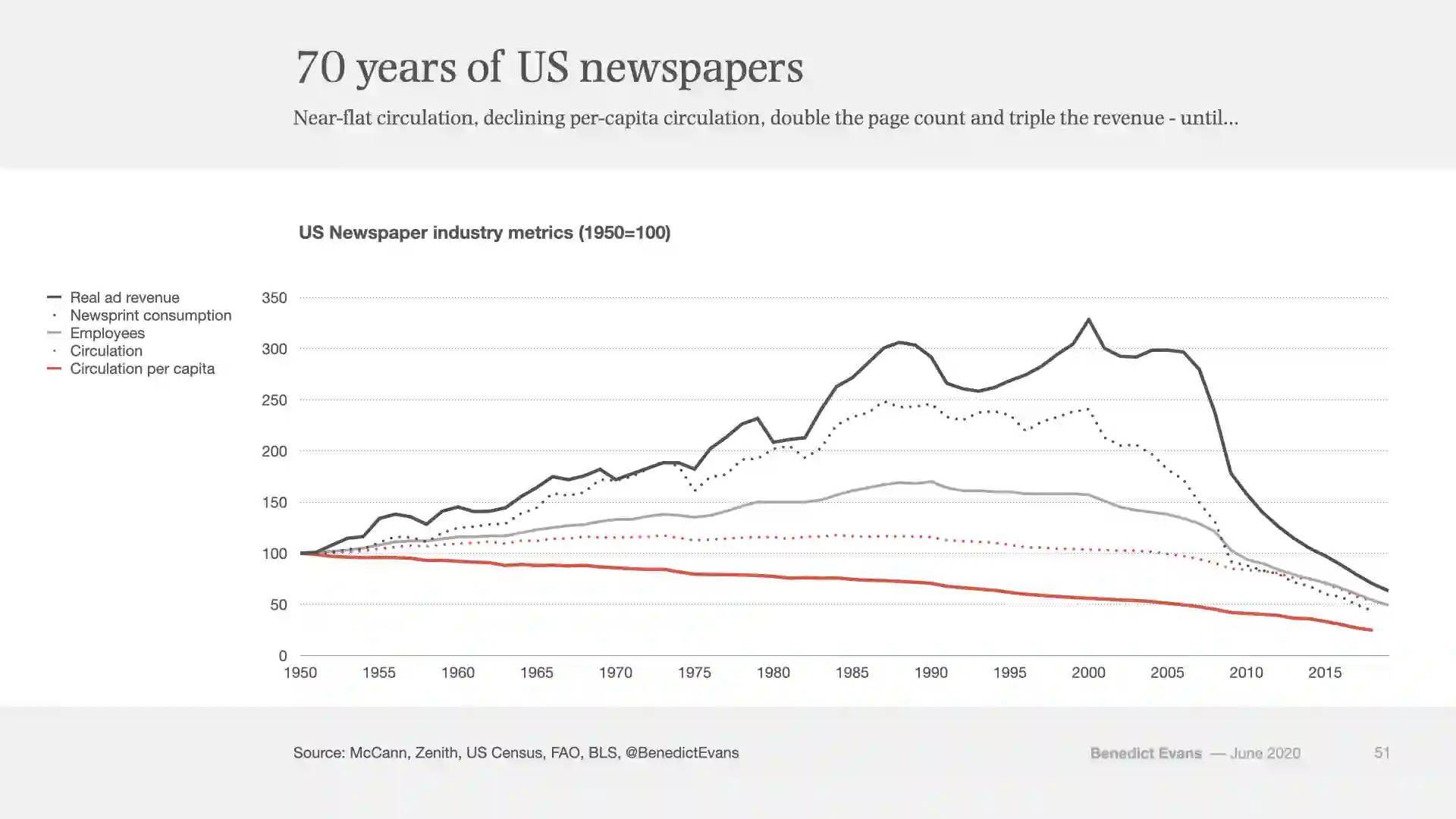
US advertising spending by medium: Newspapers had been losing advertising share for a long time, even before the internet.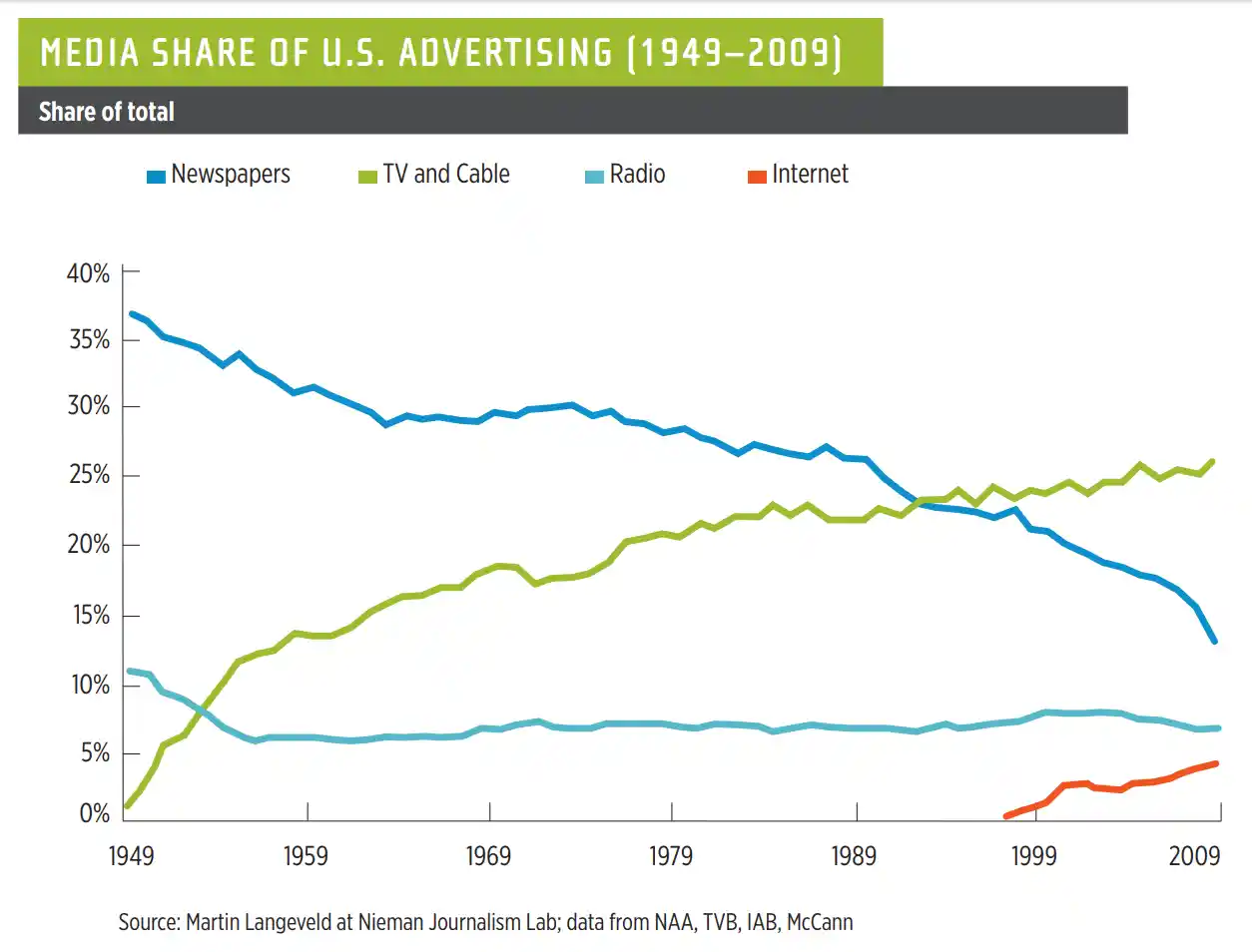
As circulation flatlined, newspapers had to choose between lower profits and sacrificing quality. By the 1970s, the choice was made—newspapers sacrificed quality for profits. First, the newspapers cut editorial budgets, circulation, and production costs and fired reporters. Then, they cut the volume of news and increased the number of advertisements and advertising prices to maintain those ridiculous profit margins and please shareholders.
> It no longer is a business, as publishers once joked, in which even the brain dead could make money.
As competition disappeared, surviving newspapers raised ad rates. Between 1965 and 1975, ad rates rose 67 percent (remaining below the inflation rate); but between 1975 and 1990, as more newspapers became monopolies, rates skyrocketed 253 percent (compared with 141 percent for general consumer prices). — FCC Newspapers raised their ad rates three times as fast as inflation from the early 1970s to the late 1980s, the newspaper analyst John Morton told Barron’s in 1990.
Then came the internet!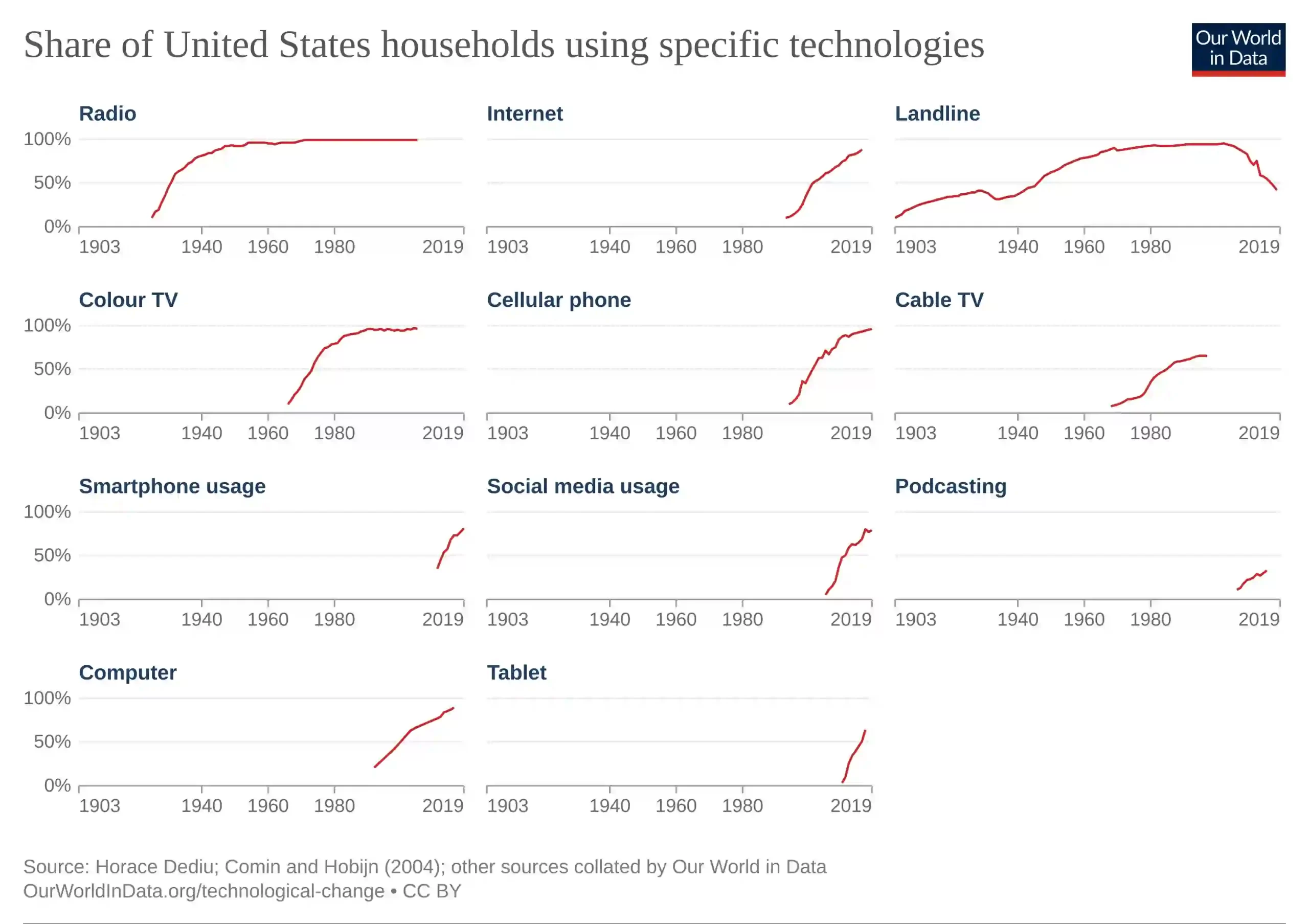
Even with the competition from radio and television, newspapers were still the only choice for targeted local advertising and classifieds. Despite declining circulation, newspapers commanded immense pricing power and continued to increase advertising rates from the 1970s to the 1990s. In this period, the large chains and conglomerates had a single-minded focus on maximizing margins and revenues. This made newspapers brittle, and when the internet arrived, they were like a tin can caught in a hurricane.
Even with the competition from radio and television, newspapers were still the only choice for targeted local advertising and classifieds. Despite declining circulation, newspapers commanded immense pricing power and continued increasing advertising rates from the 1970s to the 1990s. In this period, the large chains and conglomerates had a single-minded focus on maximizing margins and revenues. Newspapers had become brittle, and when the internet arrived, they were like a tin can caught in a hurricane.
As Kathryn Weymouth, the last Graham family publisher of the Washington Post, remarked when she passed the baton to Bezos: “If journalism is the mission, given the pressures to cut costs and make profits, maybe [a publicly traded company] is not the best place for the Post.”
Rodney Benson and Victor Pickard/The Conversation
Unbundling {#unbundling.wp-block-heading}
Newspapers enjoyed a privileged position as gatekeepers between readers and advertisers before the Internet. A newspaper was a bundle of news, sports, entertainment, weather, and games. You had to buy the entire paper regardless of your interests, and everybody got what they wanted. This is crucial to understanding how newspapers lost the plot. On the one hand, they aggregated advertisers; on the other, they aggregated readers’ attention.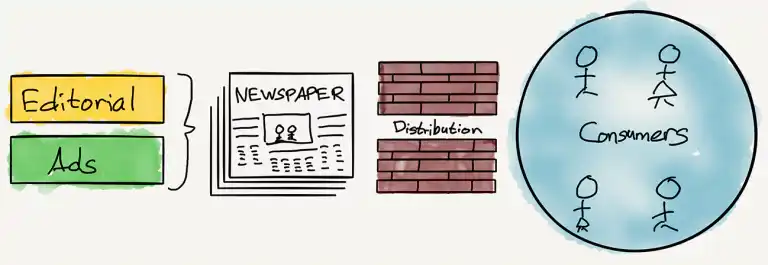
So a key starting point for understanding the problem, which I think actually is a core part of the problem, is that the problem has been misunderstood, is that newspaper, the newspaper crisis, at least in places like the US and Australia, results from them no longer being as effective as a tool for attracting attention. And that really gets to the core, that the core business of newspapers was not to actually inform or provide news, but it was to attract attention for advertisers.
Amanda Lotz, media scholar and Professor at the Queensland University of Technology
Newspapers were always in the business of advertising. Advertisers weren’t subsidizing quality journalism; they were buying the attention the newspapers aggregated. Before the internet, newspapers were the best medium to reach consumers, and that was all that mattered to advertisers. For a long time, the interests of the newspapers and the advertisers were aligned, and everybody was happy.
Then came the internet. It unbundled the newspaper and destroyed this arrangement.
Advertisers didn’t have to rely on newspapers to reach audiences because the newspaper was a dumb bundle. Advertisers could only target consumers based on the geographies that newspapers operated in. But internet companies like Google offered a far superior advertising proposition. Advertisers could slice and dice audiences and micro-target consumers.
The readers no longer had to buy the entire newspaper bundle; they could read whatever they wanted online. The internet stripped the news bundle to its atomic unit—the news story. Readers no longer had to rely on publishers like The New York Times and Gannett to assemble a news bundle. In a sense, everybody on the internet could be their own publisher. They could build their own bundle of what they wanted to read, watch, and listen to. They could read about politics in The New York Times, sports on ESPN, and entertainment on Variety. This was a boon for readers, not so much for newspapers.
> Publishers also typically engage in horizontal integration, bundling hard news with horoscopes, gossip, recipes, sports. Simple inertia meant anyone who had tuned into a broadcast or picked up a publication for one particular story would keep watching or reading whatever else was in the bundle. Though this was often called loyalty, in most cases it was just laziness—the path of least resistance meant that reading another good-enough story in the local paper was easier than seeking out an excellent story in a separate publication.
> The web wrecks horizontal integration. Prior to the web, having a dozen goodbut-not-great stories in one bundle used to be enough to keep someone from hunting for the dozen best stories in a dozen different publications. In a world of links and feeds, however, it is often easier to find the next thing you read, watch or listen to from your friends than it is to stick with any given publication. Laziness now favors unbundling; for many general interest news sites, the most common category of reader is one who views a single article in a month.
Post Industrial Journalism: Adapting to the Present
Classified advertisements, such as hiring ads, real estate listings, and automobile sale advertisements, were the biggest casualties of the internet. Newspapers charged exorbitant prices for a few lines of text, and these ads accounted for 40–50% of newspaper advertising revenue. Classified advertising revenues peaked in 2000 at $19.6 billion as sites like Craigslist, Monster, Zillow, eBay, and Cars.com became popular. By 2010, classifieds revenues had dropped by 70% to $5.6 billion.
Any industry that saw 40–50% of its revenues vanish should have died, but the newspaper industry continued to hobble along. It shows the extraordinary position newspapers were in. As classified revenues started dropping, so did other print advertising. For a long time, brands advertised in newspapers because they had no choice. They had no clue if people who bought newspapers cared about the ads. Since newspapers were local monopolies, businesses had no choice but to advertise. But, on the internet, advertisers paid only for the ads consumers saw. This was a revolutionary shift, and there was a sharp decline in print advertising.
As Professor Amanda Lotz put it, the internet stripped away the profitable parts of the newspaper bundle and left the publishers with the most expensive part—the news.
> Internet communication technologies have unbundled the newspaper the internet has improved replaced or at least affected just about every part of the bundle and done so in different ways. The key here, where i'm kind of going with this argument is that it used to be that an accumulation of things added value to a newspaper and bit by bit the internet has stripped many of them away and what is left is largely the most expensive part and what is missing are all the different ways that used to pay for it.
Newspaper readership was declining long before the internet, as radio, television, and other mediums started competing for attention.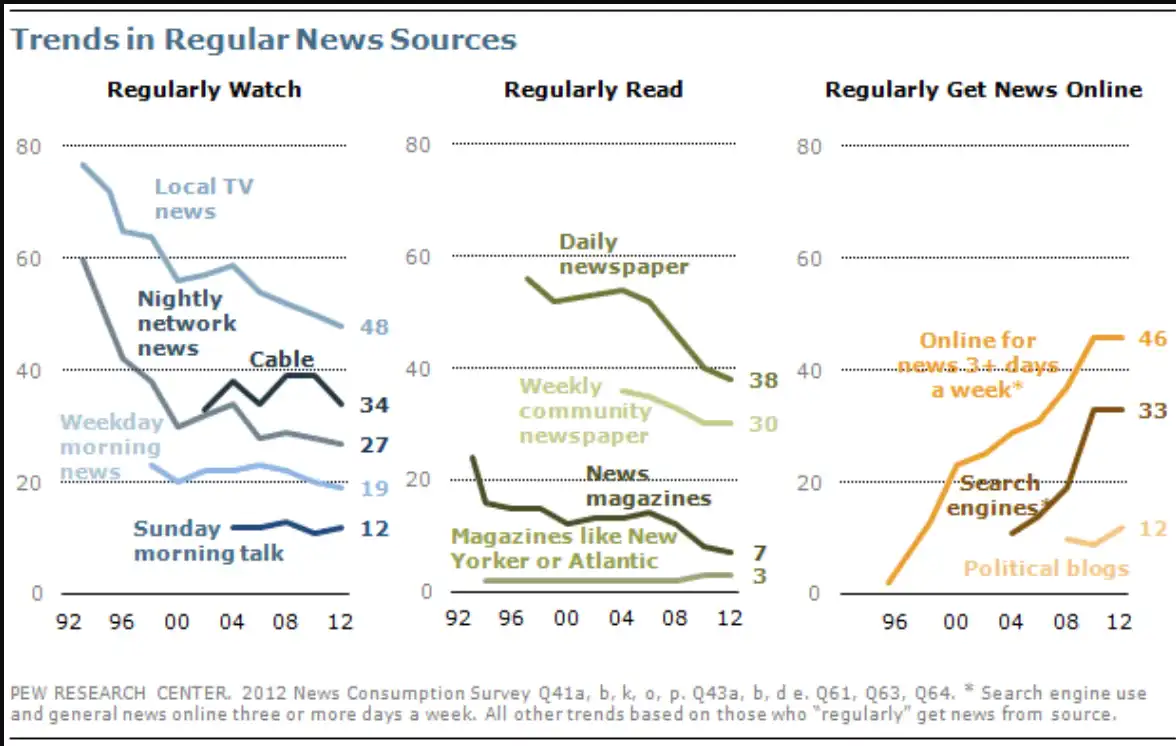
By the turn of the century, Americans had more media competing for their attention than at any point in history. Sure, news mattered, but videos and movies mattered more.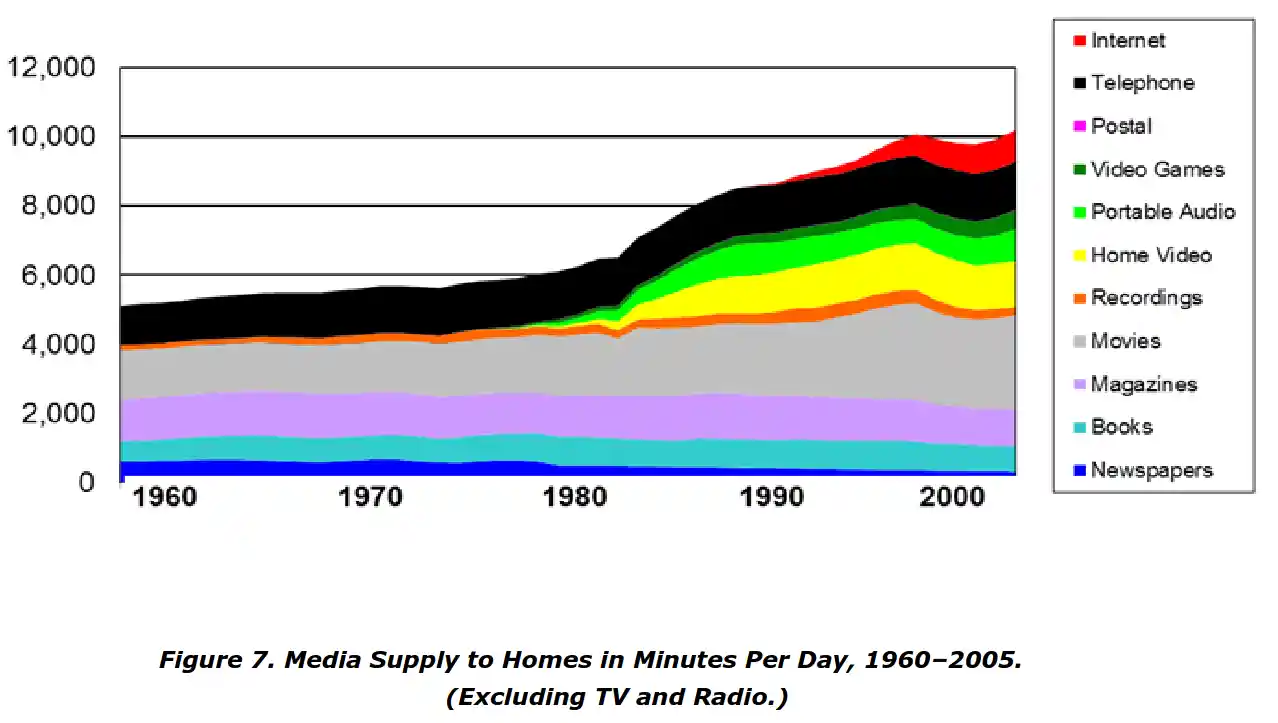
> Within the span of a single human generation, people's access to information has shifted from relative scarcity to surplus.
The newspaper industry’s inflation-adjusted revenues peaked at $89 billion in 2000 and plummeted 80% to $18 billion in 2020. Newspaper subscription revenues also took a large hit, dropping by over 50% from $15.8 billion in 2000 to $7.8 billion. Online advertising revenues reached $3.3 billion in 2020, but they were a drop in the bucket compared to the losses in subscription and print advertising. Newspapers were trading “print dollars for digital pennies.”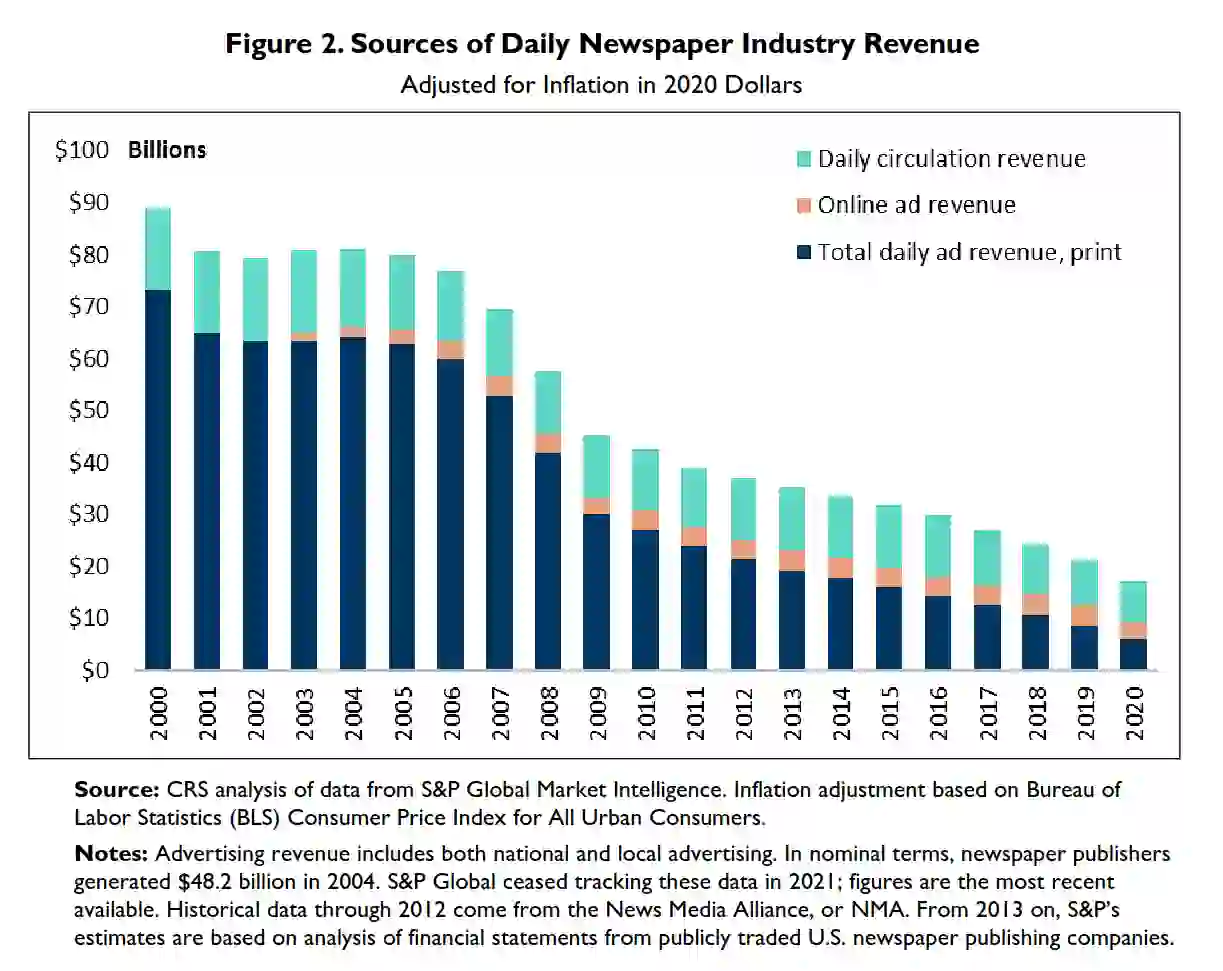
The internet caused a dramatic shift away from traditional advertising channels. Print and radio were the biggest losers.
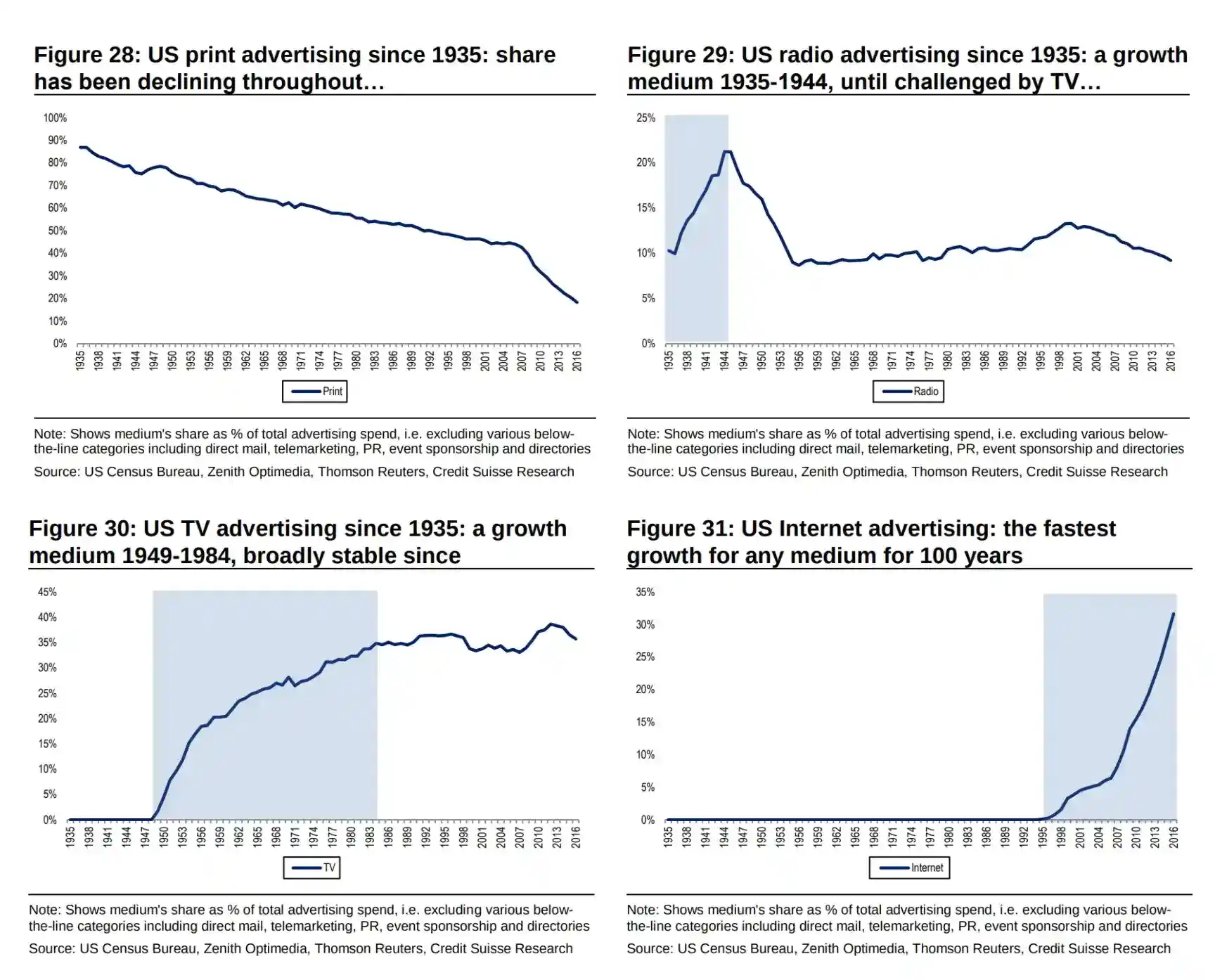
The internet didn’t kill newspapers. Newspapers were stabbed by radio, television, and other economic shifts. As they lay bleeding on the ground in a dimly lit parking lot, the internet walked in and tripped over something in the dark. The internet looked down, picked up the object it had tripped over, and held it up in the light—it was the bloody knife that had been used to stab newspapers. As the shocked internet stared at the knife, the cops rushed to the crime scene, and the internet was accused of the stabbing.
What killed the newspapers wasn’t the internet, but a change in how people consumed information coupled with a generational shift in attitudes. Each successive generation has adopted a new medium to get its news: it started with radio, television, cable television, followed by the internet, social media, and so on. As I write this post, version one of social media is dying; what comes next is anyone’s guess.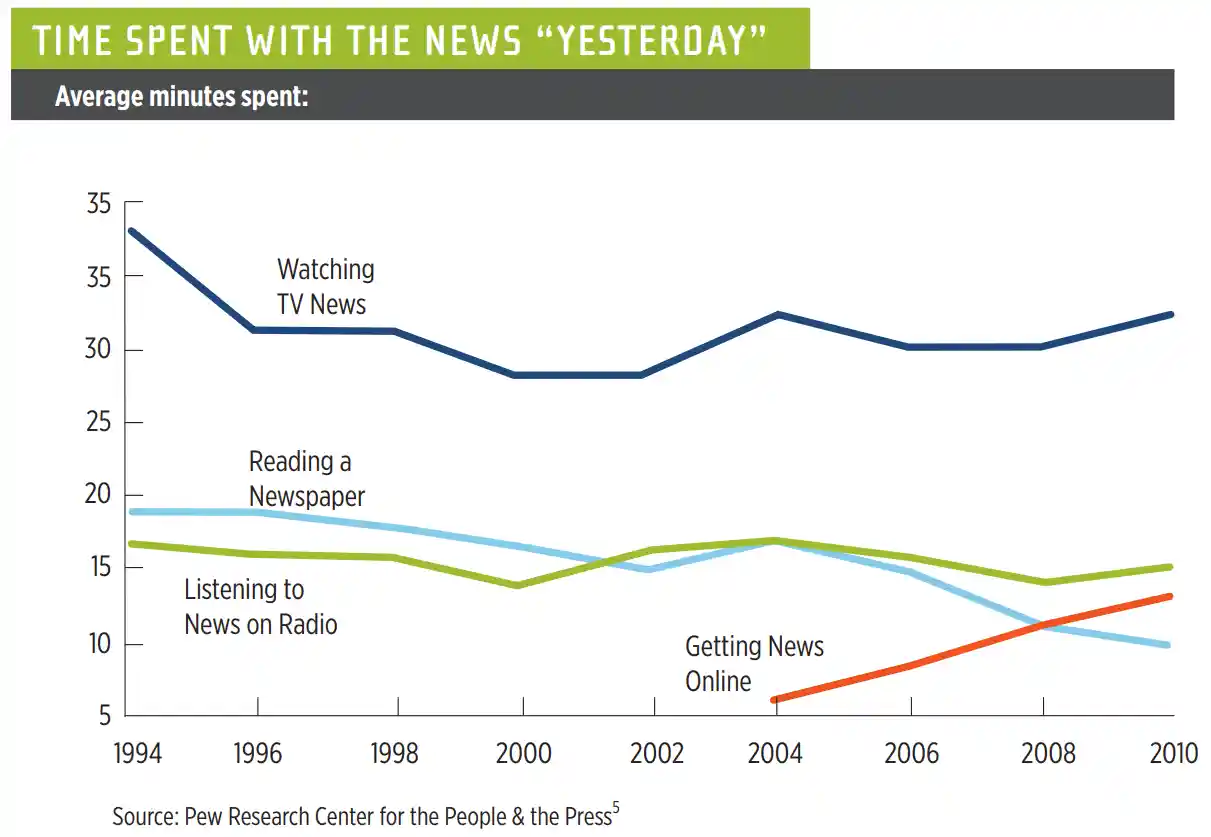
Newspapers ain’t hip enough.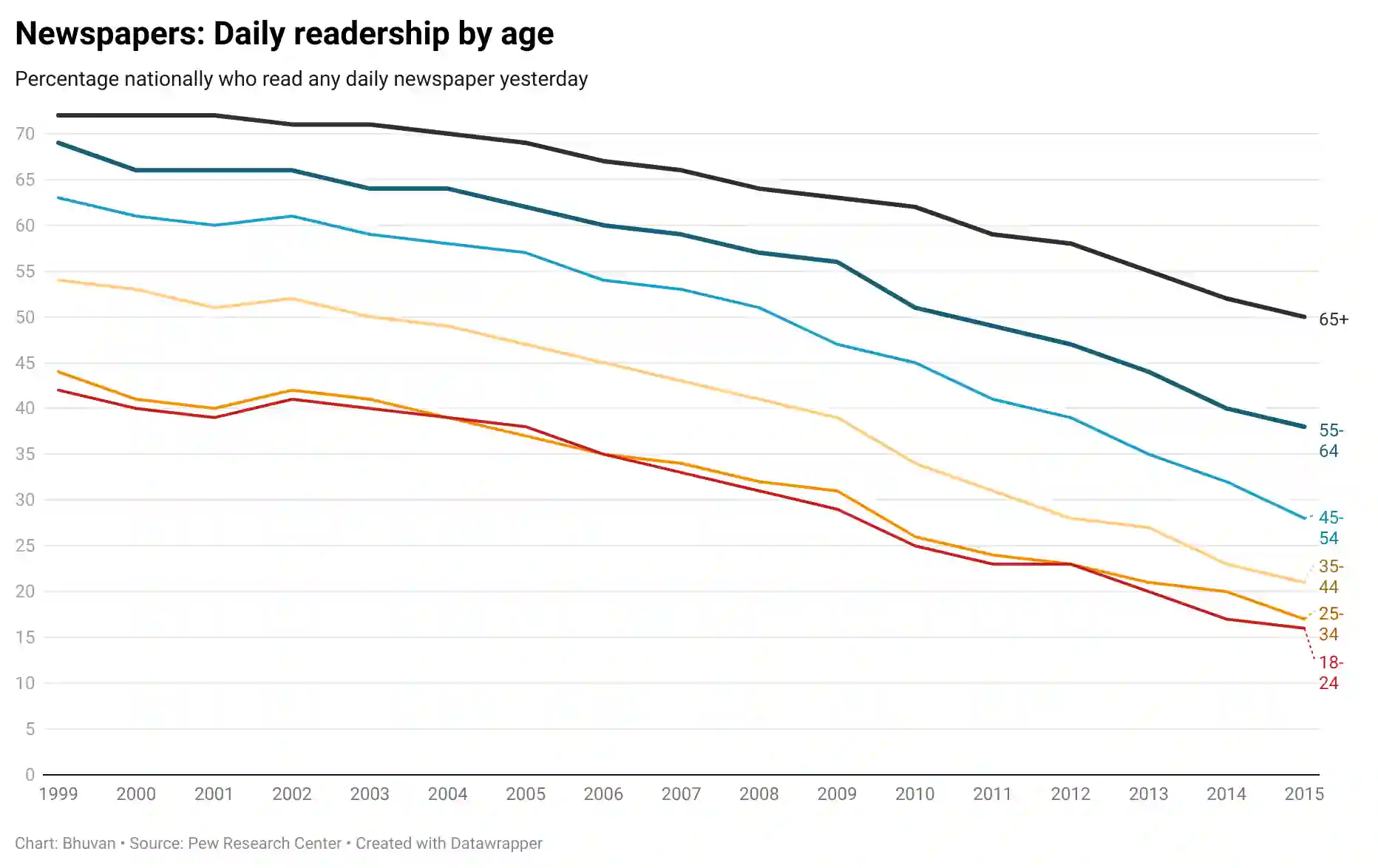
News deserts
The internet affected local newspapers the most, leading to the closure of over 2,000 newspapers. At one point, newspapers were shutting down at a rate of two per week. The number of reporters per 100,000 people dropped by 62%, and the ratio of reporters per $100 million spent by state and local governments declined by 67%. The total revenue lost by newspapers amounted to over $40 billion.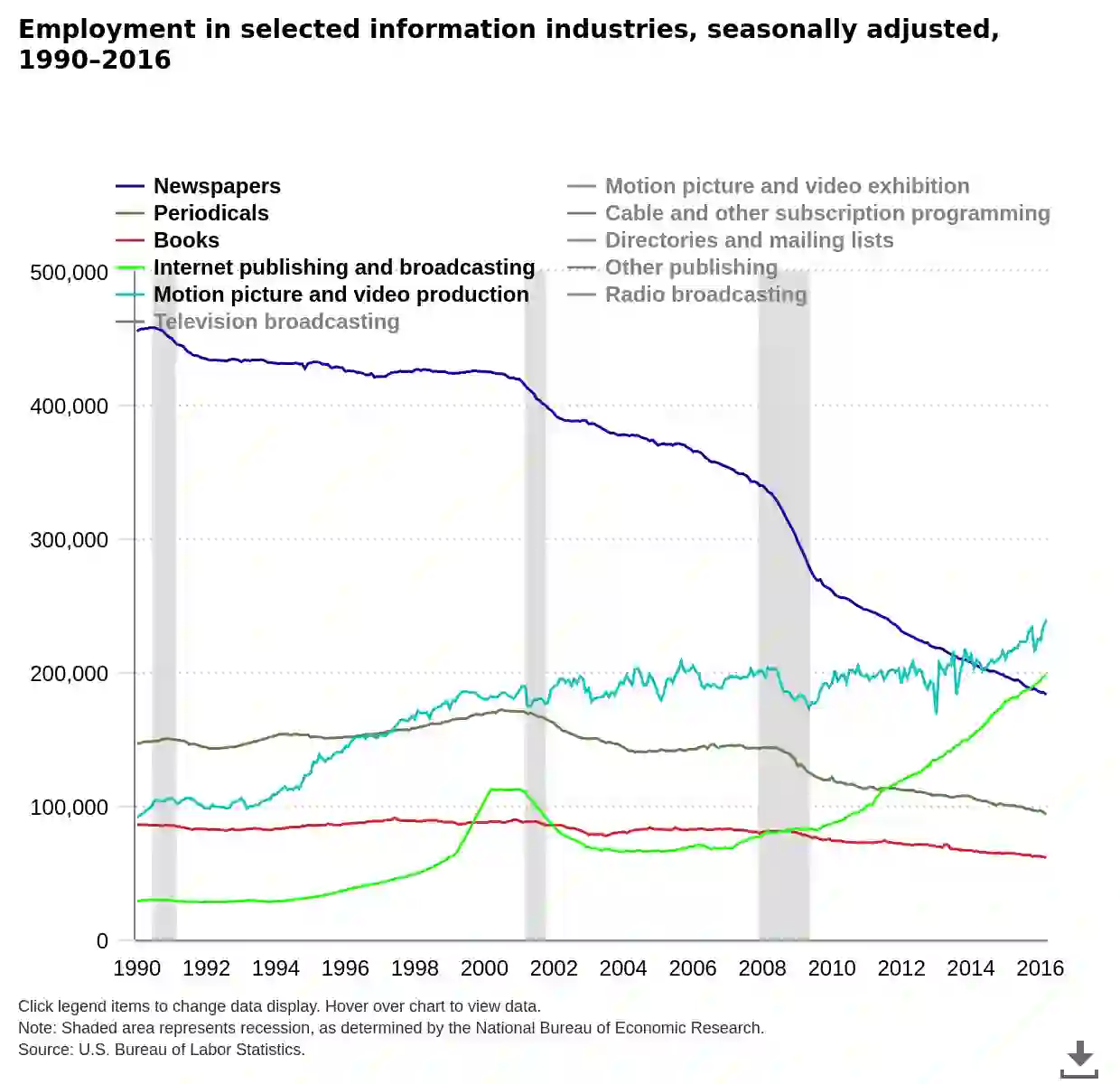
As newspapers closed, small towns and counties transformed into news deserts. Thousands of local communities don’t have any news coverage today. Without vigilant reporters, local governments, notorious for corruption, have been left unsupervised.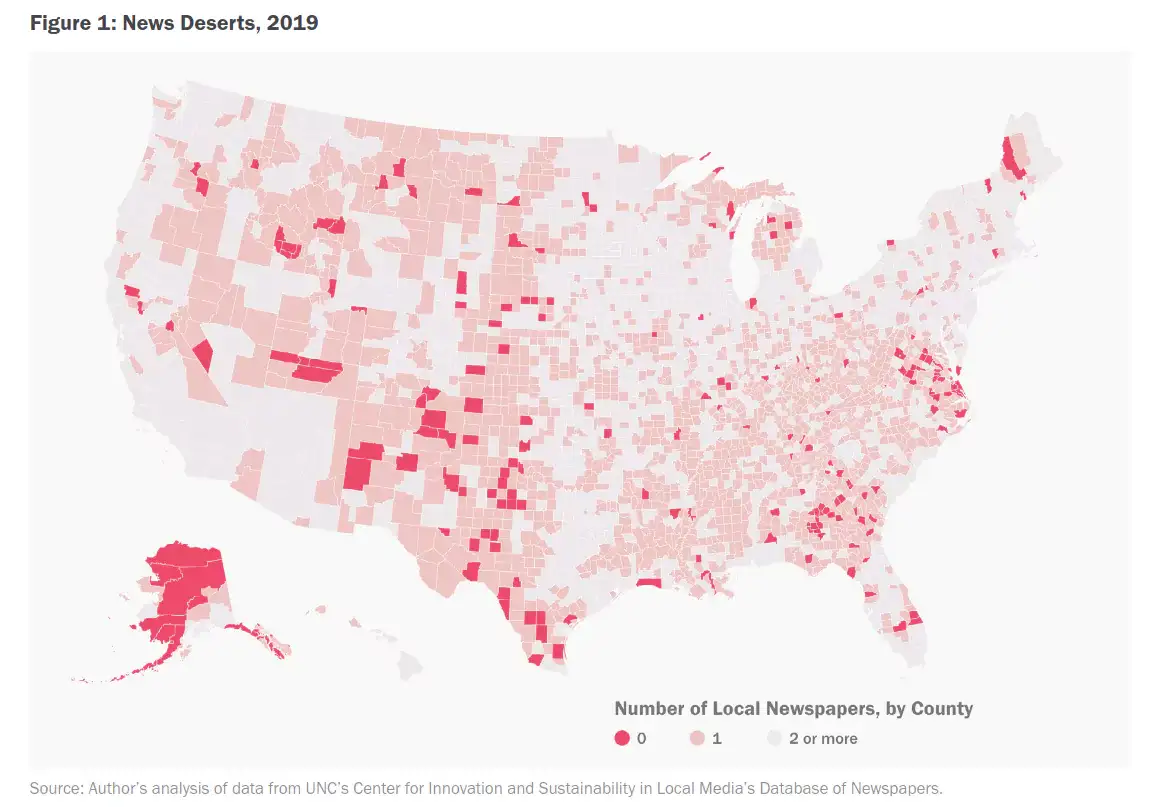
The death of local newspapers is not good for democracy. Numerous studies have shown that the loss of local news leads to increased municipal borrowing costs, reduced civic engagement, lower voter turnout, and a lack of political accountability. Newspapers are like sunlight—they are the best disinfectant, especially at the local level.
How did the newspapers respond to the internet? {#survive.wp-block-heading}
There are two broad narratives about how newspapers responded to the arrival of the internet:
-
They were sitting ducks that didn’t innovate. They were extracting rent even as the internet ravaged their business.
-
The newspaper companies were anything but lame ducks, and they were far more innovative than people gave them credit for. In their fear of getting disrupted, they went overboard on adopting digital and sacrificed print.
Narrative 1
The newspapers were dinosaurs clutching their printing presses with a death grip while staring at the internet like a hound foaming at the mouth with its fangs out, ready to shred it into keema.
The narrative that newspaper companies were useless and incapable of innovation has become a truism. The story is that they were a classic example of disruptive innovation. The cool kids kneecapped the arthritic incumbents with a cricket bat. But the reality is that the story of newspapers getting disrupted is a little more complex. History shows the newspapers were anything but dinosaurs waiting to be hit by an asteroid. They were more innovative than they get credit for. Before the internet hit the mainstream, there was existential paranoia about being disrupted among the major papers.
In the early 1990s, Roger Fiddler conceptualized a tablet for reading news at the newspaper giant Knight Ridder. The same Knight Ridder spent $50 million to develop a video-text service called Viewtron in the 1980s. It was a dedicated terminal on which you could read news, check airline schedules and bank balances, and order a meal. During the same period, most major newspapers offered audio-text services. Subscribers called a phone line to get news, horoscopes, race listings, and sports scores, among other things. They also offered news over fax and were early adopters of private internet networks like AOL and Compuserve, but the internet was too small at that point.
This excerpt from a phenomenal study by Iris Chyi, a media scholar, further illustrates how nimble newspapers were:
> Contrary to general impressions, most U.S. newspapers were not slow in adopting Internet technologies for news delivery. The Web did not become publicly accessible until 1991. Soon after Mosaic (one of the earliest Web browsers) was released in 1993, the Palo Alto Weekly went online in January 1994 as the first Web-based newspaper. By May 1995, as many as 150 U.S. dailies offered online services—when less than 1% of the U.S. population had Web access (Carlson, 2003). The New York Times went online in January 1996, and numerous newspapers followed suit. By 1999, more than 2,600 U.S. newspapers were providing online services (Editor & Publisher Interactive, 1999). However, by 2003, the industry consensus was that no business model had been found (Carlson, 2003).
Iris Chyi
Meanwhile, Rusbridger was thinking about the Guardian’s digital future. In 1994, a year before he became editor, he visited Silicon Valley. “I came back and wrote a memo to Peter saying the Internet was the future,” Rusbridger recalls. “I told Peter this would change everything and we had to explore it.” Emily Bell, the Observer’s business editor at the time, remembers having dinner with Rusbridger and others during the Edinburgh TV festival in August, 1999, and telling him that changes he’d made to the paper’s Web site were inadequate. She prodded him to move more aggressively into the online world, with more breaking news and analysis; in 2001, he placed her in charge of turning the Web site into a vibrant online paper.
Ken Auletta | The New Yorker
The question then is, How dedicated were the newspapers toward going digital? Even a cursory reading of history shows that most newspapers knew what was coming. They were experimenting with digital technologies on the eve of the internet. Were the experiments half-hearted attempts with the shiny objects of that era or attempts to appease people agitating for change? Whatever the case, you can’t fault the newspapers for being complacent.
Narrative 2
The newspaper publishers, driven by lust, fell for the siren song of the internet. They ignored their faithful print editions and cheated on the print editions. Online editions earned pennies compared to print dollars. Newspapers ended up in limbo where print was fast dying, and digital was disappointing. The newspaper industry made a mistake by going all in on digital. Despite the sharp declines, print was still generating all the revenues. This is the provocative view of some media studies scholars like Iris Chyi and industry observers.
> As newspaper firms were amazed by (and obsessed with) each and every digital technology, the recession hit and put many companies in serious financial difficulty. Driven primarily by fear and uncertainties at this stage, newspaper firms acted upon the unchecked assumption about the all-digital future and responded to their financial woes by slashing resources for their print product to continue their incomplete transition online. But the truth is, most newspapers are stuck between an unsuccessful experiment (for their digital product) and a shrinking market (for their print product). Even more embarrassing is the fact that the (supposedly dying) print edition still outperforms the (supposedly hopeful) digital product by almost every standard, be it readership, engagement, advertising revenue, or paying intent.
It might seem like betting on digital was a mistake if you look at the online subscriber numbers of major news publishers.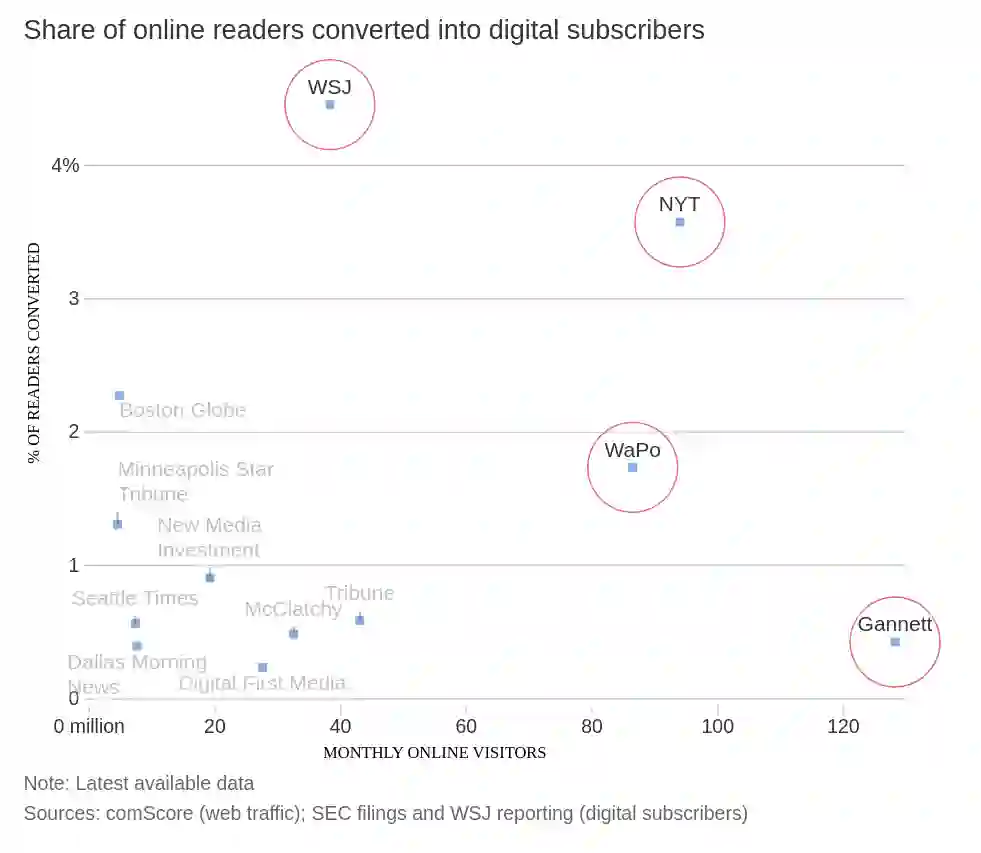
But continuing to invest in print when the bottom of the print advertising market fell off wouldn’t have helped. Even god couldn’t have made print advertisements competitive compared to digital ads.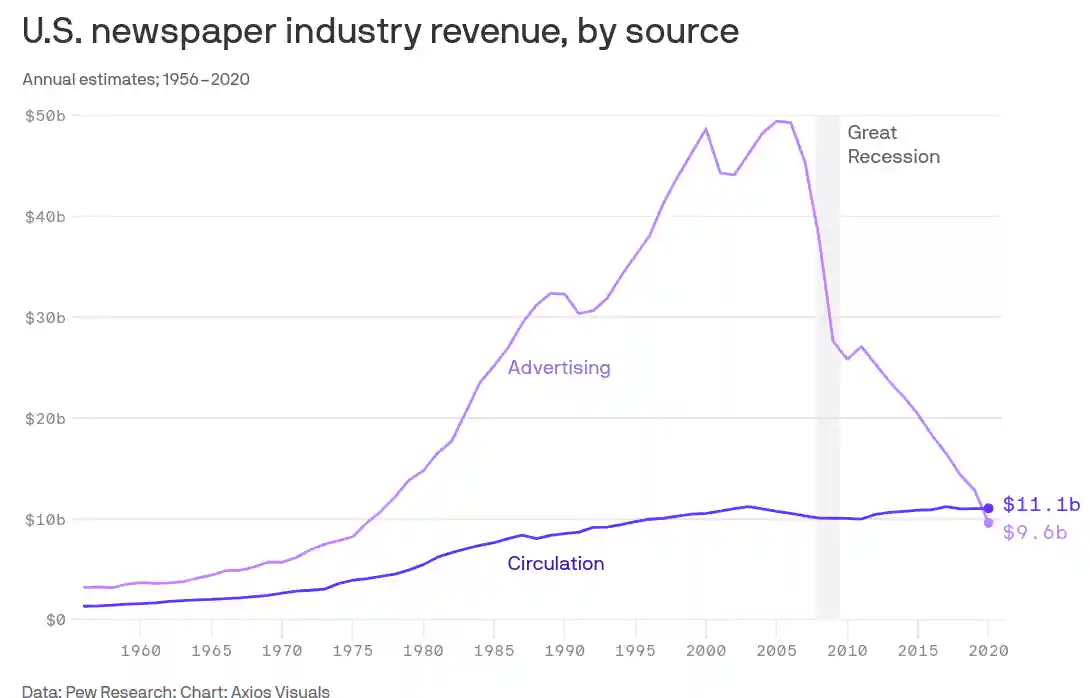
This view led to a fascinating back and forth between Iris and Joshua Benton, founder of the Nieman Journalism Lab. Josh believes newspapers couldn’t have done much, and the more I look at the numbers, the more I agree with him. I don’t think newspapers could’ve done anything that would’ve allowed them to transition to the digital age unscathed. The internet changed how people consumed information, and disruption was inevitable.
As Alan Mutter, a veteran media executive, wrote in response to Iris Chyi’s the paper:
It’s hard to imagine how newspaper companies can survive over the long term if they put their primary focus on print.
Which narrative is right?
The one that makes the most sense to you.
Did the newspapers do everything they could to prepare for the internet?
No.
In 2019, historian Jill Lepore wrote a phenomenal article titled “Does Journalism Have a Future?” In the post, she recounts two incidents involving The Washington Post and The New York Times that now, in hindsight, seem insane. The Washington Post let go of an opportunity to invest in Facebook. It also refused to back the founders of Politico, one of the greatest online publishing success stories. The New York Times, on the other hand, refused to invest in Google. It’s easy to extrapolate from these anecdotes and paint the newspapers as dinosaurs, but that’s not the point. At the very least, they knew about internet upstarts threatening their existence. If nothing, this shows their myopia. They could’ve tried harder to adapt to the new era. I’m conscious that it’s easy to exaggerate these things in hindsight.
Why didn’t the newspapers ever put up a decent fight against search giants like AOL, Yahoo, and Google? This question has bothered me for a long time. Newspapers had some idea of the threat that internet companies posed. Yet, the industry let the internet upstarts punch them in the face and walk away.
Some newspapers did try. In 2011, the Tribune, Gannett, Hearst, and The New York Times tried to pool their advertising inventory to compete against Google. The partnership shut down two years later. The Guardian, CNN, Reuters, T_he Economist_, Financial Times, and others formed a similar advertising alliance that ended in 2021. In 2016, USA Today, The Houston Chronicle, The Miami Herald, and The Los Angeles Times formed a similar partnership. There were several other advertising partnerships between competing publishers with varying degrees of success, but they were late by a decade. By the time of the first advertising partnership between news publishers in 2011, Google had generated $38 billion in revenue.
As the internet arrived, newspapers were flush with cash. They had a chance to build advertising offerings that could’ve, at the very least, been distant alternatives to Google and Yahoo.
> The disastrous error that newspapers made early in our digital lives was treating online advertising as a throw-in or upsell for their print advertisers. Helping businesses connect with customers was always our business. We were facing new technology and new opportunities and we did next to nothing to explore how we might use this new technology to help businesses connect with customers.
Steve Burttry, director of Student Media at the Manship School of Mass Communication at Louisiana State University.
Not all experiments were in earnest. In response to the internet, newspapers just started to upload articles online in a haphazard way. They were too scared that digital would cannibalize print. In 2017, Melissa Bell, the co-founder of Vox Media, gave the Reuters Memorial Lecture on how we broke news and how to fix it. During the discussion, the legendary Marty Baron, the former editor of The Washington Post and The Boston Globe, made some interesting comments:
> I'm not sure that if we had done any one thing, things would have turned out all that differently, to be honest with you. There were a lot of efforts to deal with the internet.
> So there were a lot of efforts, I mean not all that we should do, certainly with regard to classified advertising, people were aware of what Craig Newmark was doing. There were a lot of people saying, why aren't we doing this? And obviously in classic fashion, the industry was worried about doing that, going full bore because they were worried about undermining their pre-existing business model, which is the classic story of disruption, right? So, so, I think it's, we made a lot of mistakes.
> I think I always say that what we're talking about here is a new medium. It's not the same medium, all right? So we had print, then we had radio. It's different. The way you communicate on radio is different from the way you communicate in print. Then we had television. The way you communicate on television is different from the way that you communicate on radio and the way you communicate in print. And along came the web, and what did we do? We just put up print stories. And then that didn't work. And then we said, well, okay, let's put them up faster. And we put them up faster and that didn't really work. And what we're talking about now is just a different way of communicating.
Marty Baron
There was a certain collective delusion about the effectiveness of a newspaper bundle before the internet. Newspapers almost made it seem like readers looked at all advertisements in a paper. Advertisers had to go along with the crazy notion because they had very few local advertising alternatives. This enabled local papers to become monopolies.
Print publishers used to tout the “pass-along audience”—people who didn’t buy a magazine or newspaper but picked it up in, say, a dentist’s office, and could therefore be counted as readers. Advertisers were often skeptical of the numbers, which depended on surveys of readers trying to remember if they read a publication they didn’t pay for.
Newspapers enjoyed tremendous pricing power throughout the 20th century. Owning a printing press was a license to print money. The period from the 1950s was the golden age for newspapers, as they took in boatloads of cash. Newspapers thought this would go on forever and forgot the fact that this golden era was an aberration.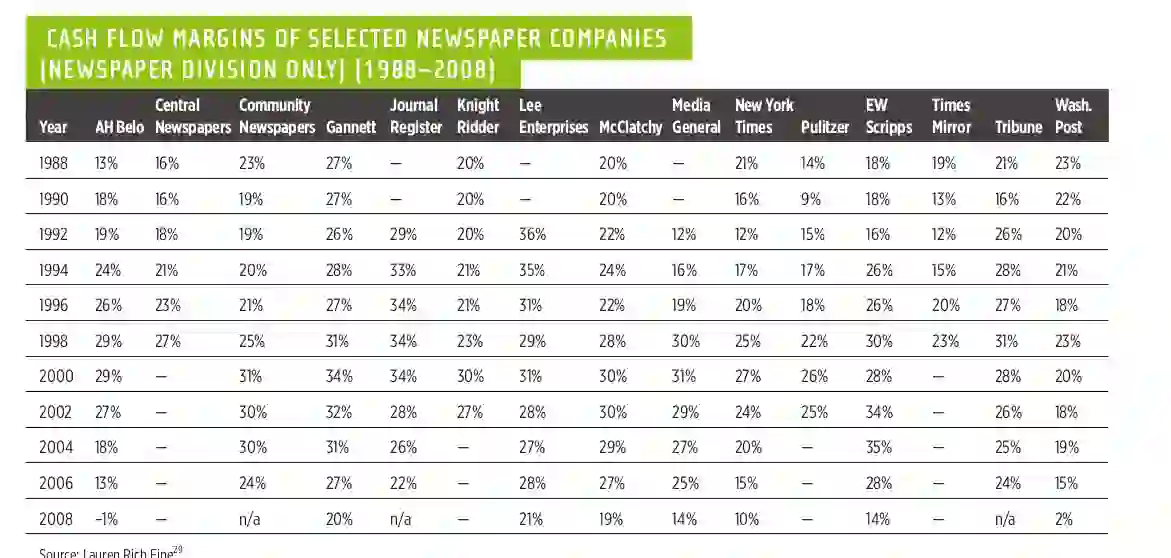
Speaking in a panel titled “Will there be journalists in 2030?” at the International Journalism Festival in 2017, here’s what George Brock, a former journalist and professor of journalism, said:
> In the late twentieth century, we had a period in journalism in which income from print and terrestrial television was very solid and relatively assured. It convinced an entire generation of journalists, my generation, roughly speaking, that all this would continue roll forward on wheels indefinitely. That is historically complete nonsense. Every other area of journalism has been improvisational, volatile, risky and littered with the wrecks of projects that don't work. So we have to be weird to get used to threats coming at us might be artificial intelligence. It might be virtual reality. It might be ad blockers. It might be anything. They will come at us in a regular stream. Get over it.
Do people care about the news? {#care.wp-block-heading}
The internet exposed the inconvenient truth that most people don’t care enough about news to pay for it. There isn’t a lot of good data on news consumption habits, but the available data gives you a directional idea. The Reuters Institute published a study tracking online news consumption during the 2019 UK General Election. They found that the average user read 16 minutes of news in a week, which made up only 3% of the total internet time, even during the election.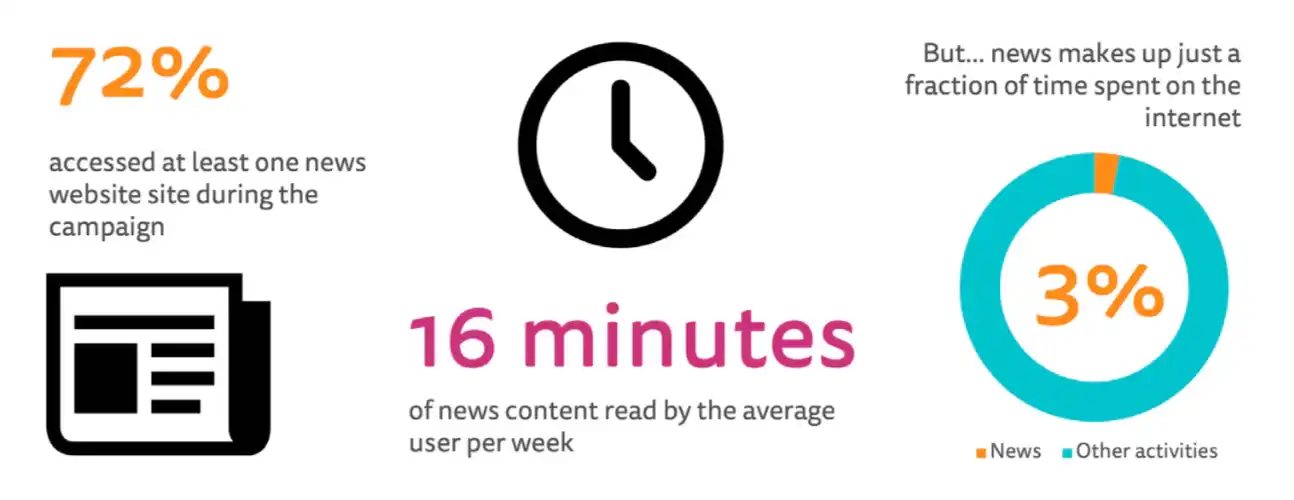
Rasmus Kleis Nielsen, the director of the Reuters Institute for the Study of Journalism, published another estimate. The time spent on online news ranges from 6 to 23 minutes a day.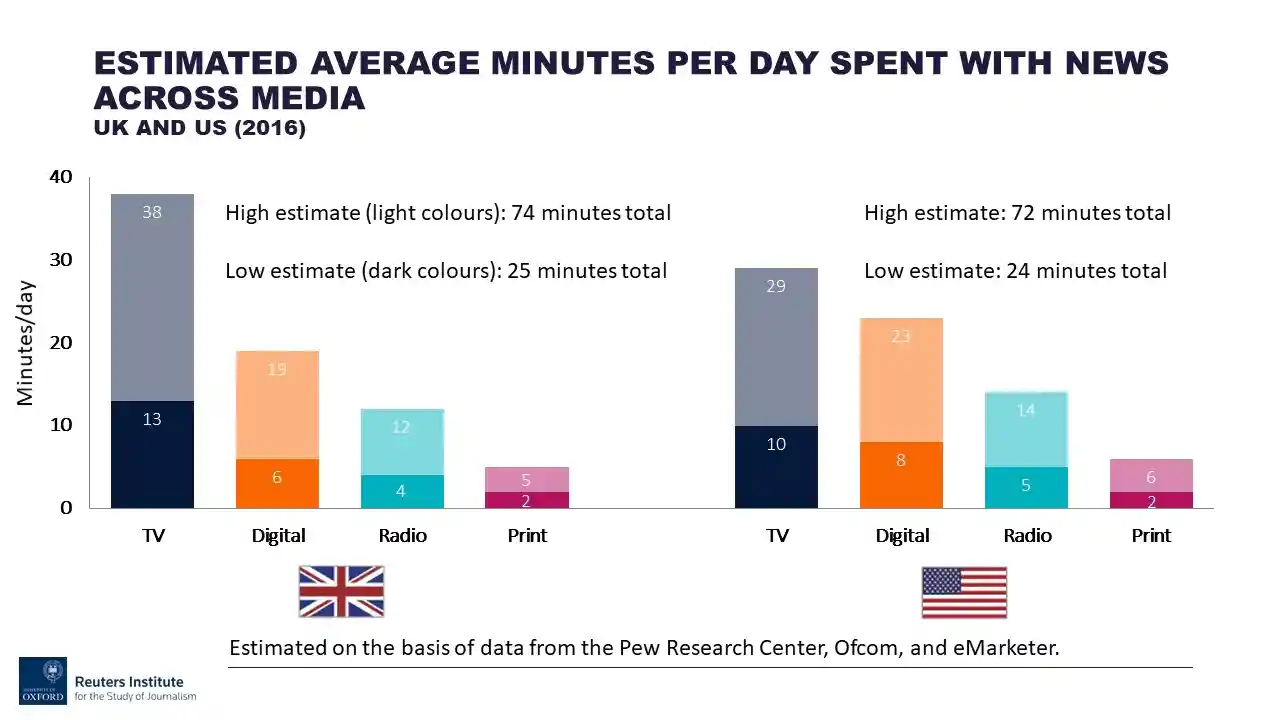
Another report from Rasmus Nielsen and Meera Selva found similar numbers. Only 17% of users access news more than five times a day. 48% read news once a day.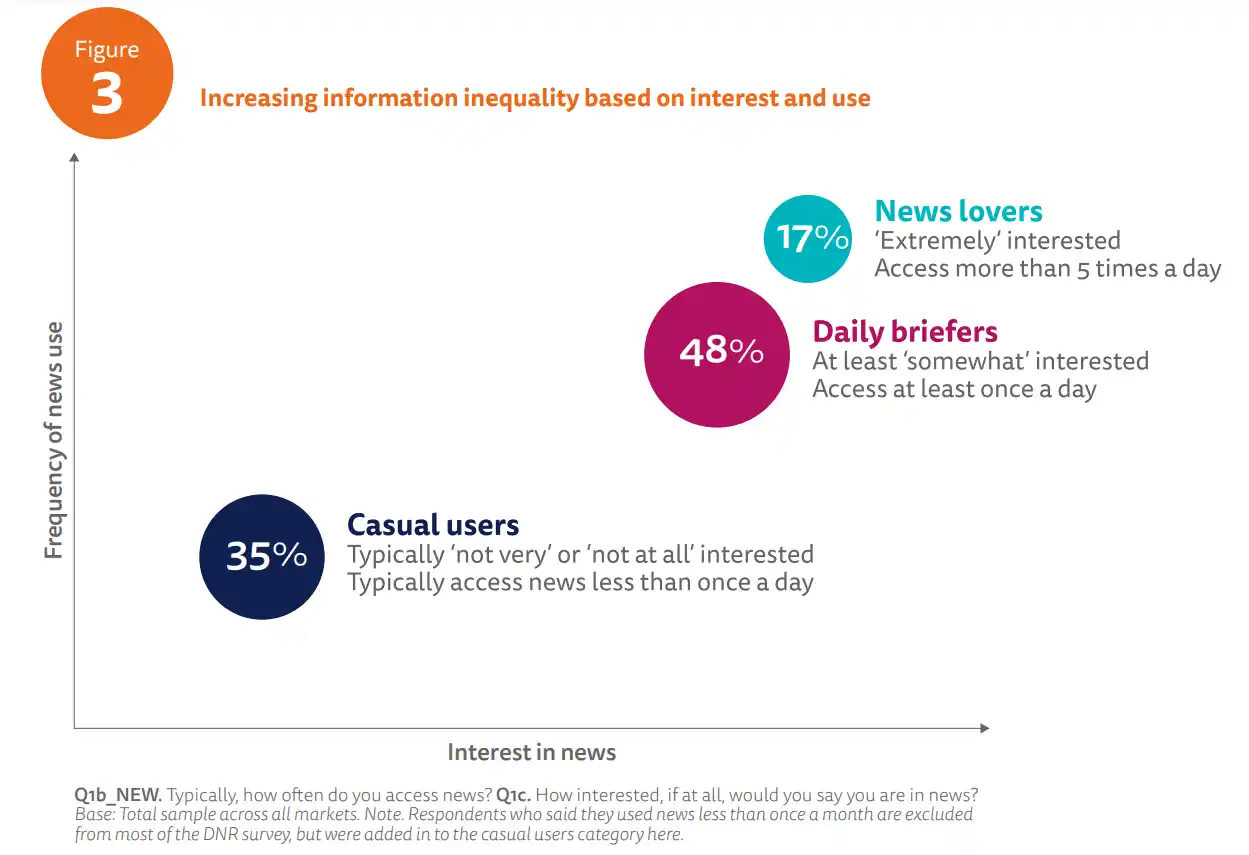
The fact that most people don’t care about news was an open secret. In the early 2000s, even as newspapers were touting page views that numbered in the millions, they were making peanut from them. Notice I use “peanut” and not “peanuts.”
> For a long time, longer than anyone in the newspaper business has been alive in fact, print journalism has been intertwined with these economics. The expense of printing created an environment where Wal- Mart was willing to subsidize the Baghdad bureau. This wasn’t because of any deep link between advertising and reporting, nor was it about any real desire on the part of Wal-Mart to have their marketing budget go to international correspondents. It was just an accident.
> Advertisers had little choice other than to have their money used that way, since they didn’t really have any other vehicle for display ads. The competition-deflecting effects of printing cost got destroyed by the internet, where everyone pays for the infrastructure, and then everyone gets to use it. And when Wal-Mart, and the local Maytag dealer, and the law firm hiring a secretary, and that kid down the block selling his bike, were all able to use that infrastructure to get out of their old relationship with the publisher, they did. They’d never really signed up to fund the Baghdad bureau anyway.
Readers were flirters, not lovers 💔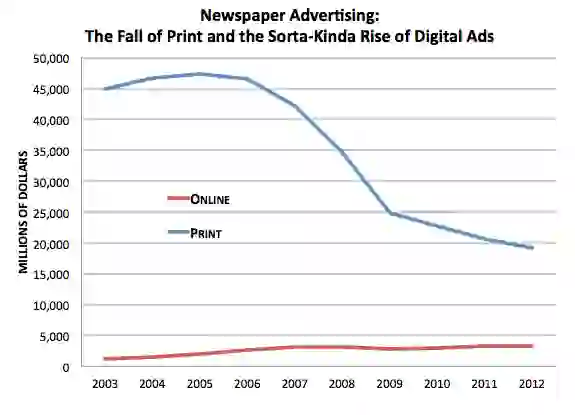
News was always a tough business, and the advertising bonanza in the second half of the twentieth century blinded newspapers to this fact. The present-day sorrows of news publishers are no different from those of other historical periods.
A false dawn {#dot-com.wp-block-heading}
News publishers entered the 21st century with shrinking print advertising revenues, declining circulation, negligible online advertising revenues, massive debt burdens, and no salvation in sight. There was cautious optimism that newspapers could crack digital. A new breed of online publications like Slate, Salon, Wired, Fast Company, and Inside started with a promise to pillage readers and put traditional newspapers out to pasture. Salon Media was a poster child of this new breed of publishers, and it raised $25 million at a valuation of $107 million through an IPO.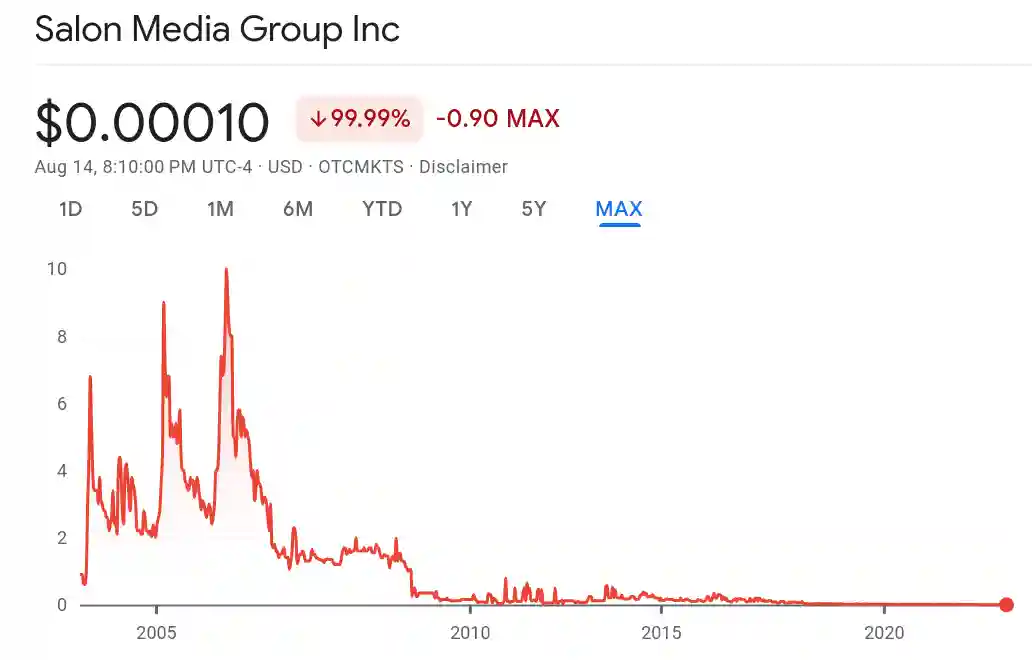
The economic logic of digital-first publishers was simple. Over 50% of the cost of publishing a newspaper was printing and distribution, and by being online first, they could cut this cost.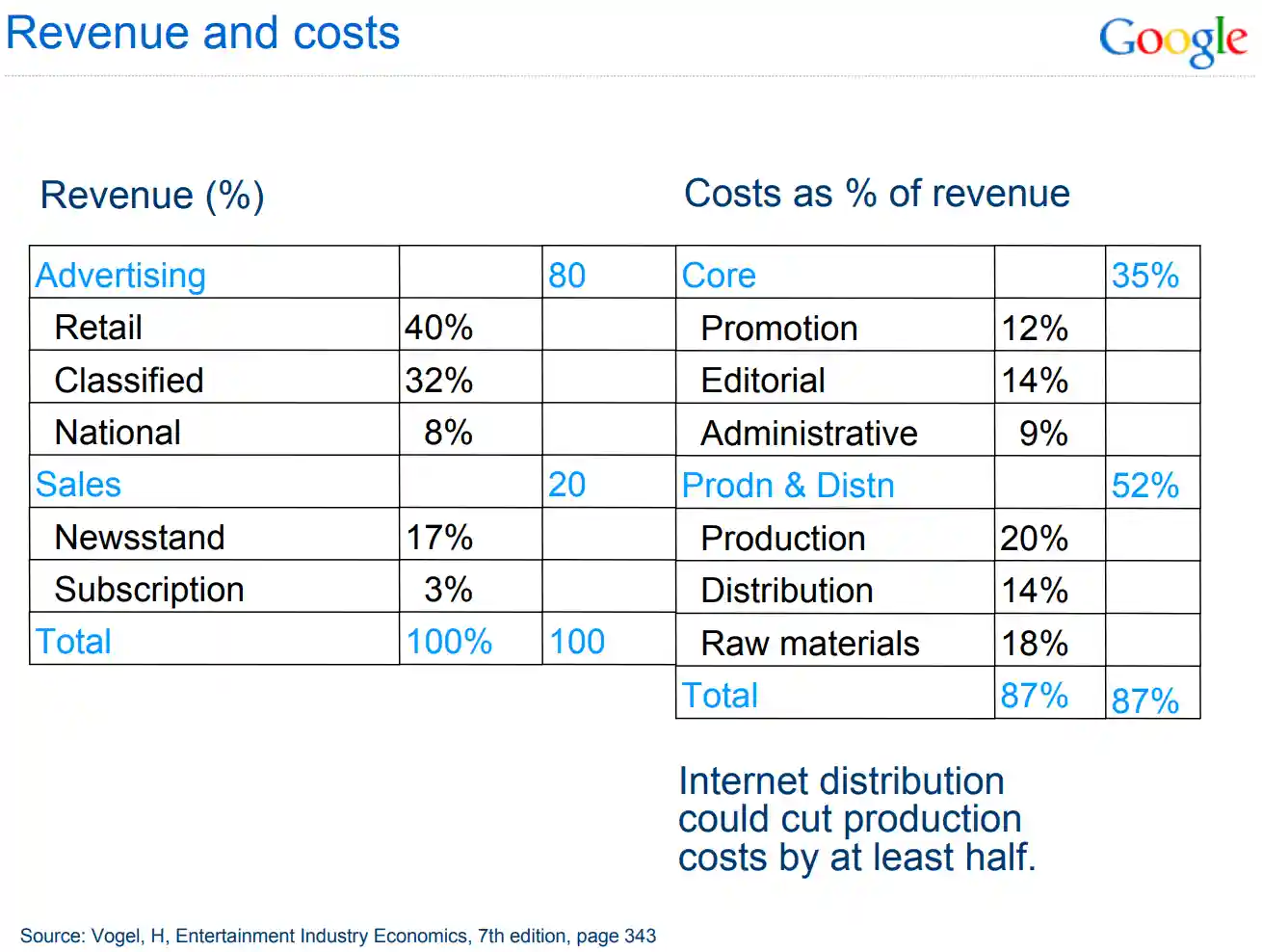
The first era of digital publishing was accompanied by all the buzzwords of innovation, disruption, and wishful projections of millions of readers and billions in digital revenues. Then the dot-com bubble shattered the delusional, and reality punched these new-age publishers in the face. Several online publications shut down, and Slate even launched a print publication to survive. Print publishers had the last wheezing laugh.
A new dawn part 2
Matt Drudge started the Drudge Report in 1994 as a conservative news aggregation site. The site became popular during the Clinton-Lewinsky scandal as it broke stories before news outlets. By 2010–11, the site was driving more traffic to major news websites than Facebook and Google. The site foreshadowed the power of aggregators long before Google, Yahoo, and Facebook.
In 2005, Arianna Huffington, Ken Lerer, and Jonah Peretti launched the Huffington Post as a liberal counterweight to the Drudge Report. The site started aggregating news and publishing views from an army of unpaid writers like the Drudge Report. By 2010, its traffic was higher than that of The LA Times, The Wall Street Journal, and The Washington Post.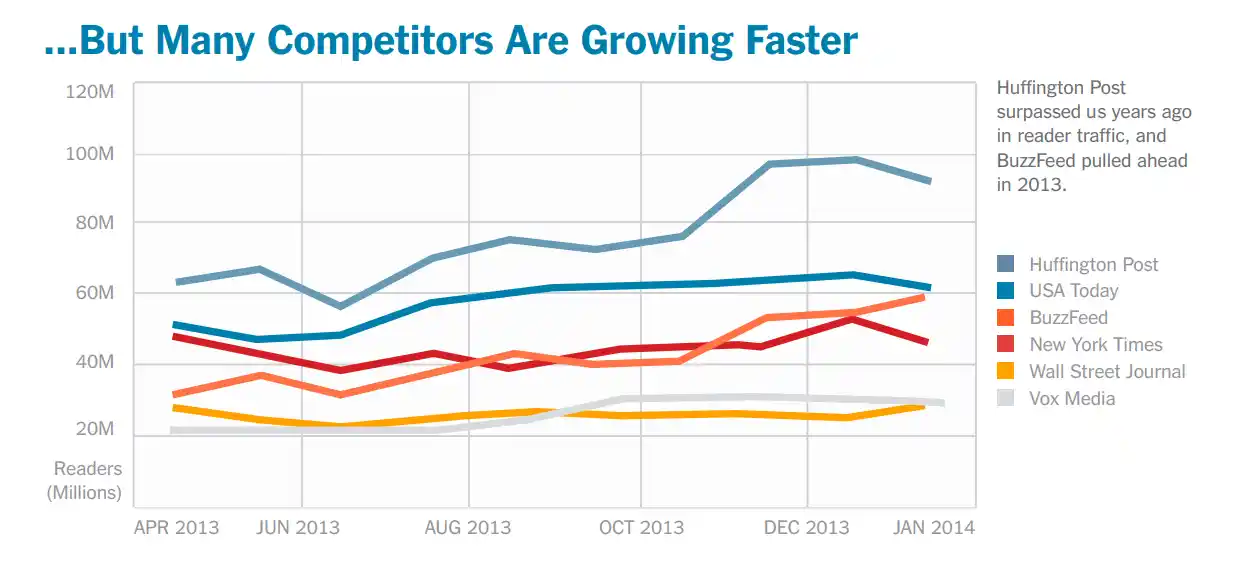
Blogs had become popular by 2005, but mainstream media publications and traditional journalists looked down on them as amateur rabble-rousers. Joshua Benton of the Nieman Journalism Lab summed up attitudes about blogging in an amazing 2010 talk:
> They don't know what they're talking about, these bloggers. They are a bunch of idiots. As if many of the people who were writing blogs were not the same people that reporters would call to get expert testimony on a given question in many cases. “They're they're not burning up the shoe leather”, “they're not going to the scene”, “there they don't have smoke in their hair after a fire” as if of course all newspaper stories were Watergate and as if many were not or maybe even most we're not based on press releases and press conferences any number of arrangements that are handed to journalists in which they perform a bit of journalistic magic on, but for the most part is hardly the stuff that Pulitzer Prizes are given for.
> I found these attitudes, I mean some of these attitudes have weakened, but they've certainly not gone away. I find them strange because I saw bloggers and news reporters as kindred spirits as people who had similar a similar set of instincts about wanting to find out information and share it with others and be heard. I also found it interesting because aggregation and reuse are utterly intertwined into the DNA of modern American journalism, aggregation is at the very center of what every journalist does. Even the ones who shiver in disdain at the mention of The Huffington Post.
Journalists had forgotten that American journalism was deeply partisan until the early 20th century. To put it another way, it was all opinion-based. But publishers and journalists sneered at the mere mention of blogs. They ignored the fact that opinion columns had been a major part of their own publications for over half a century. They could’ve built new sections and hired good bloggers like Huffpost did, but they were too snobby and uppity for their own good and lost the plot. The opinion columns of newspapers were Substack before Substack.
Newspapers continued their half-baked and uncertain digital transitions throughout the 2000s. On the one hand, they were unable to let go of the addiction to high margins and bountiful profits of the late 20th century. On the other hand, no matter what they tried, print advertising revenues continued to fall off a cliff and were replaced by the peanuts from digital ads. Facebook launched the News Feed in 2006. Publishers didn’t know it yet, but this consequential feature would upend their world.
The 2008 financial crisis hit newspapers like a category-five hurricane. Newspaper advertising fell by 30% between 2007 and 2009. Publishers cut over 21,000 jobs. Eight major newspaper chains filed for bankruptcy between 2008 and 2010 and re-emerged from the reorganization process.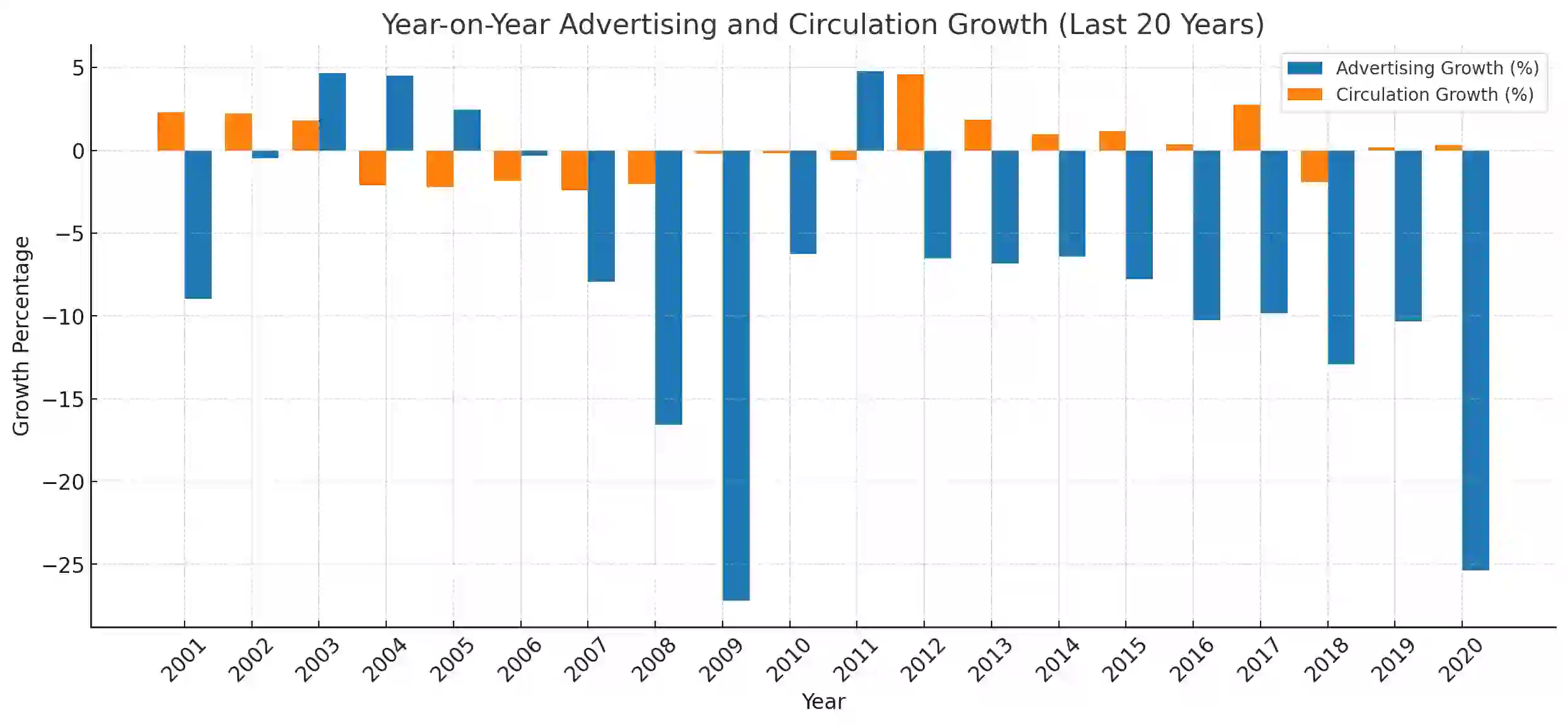
This is how profitable newspapers were despite the grim times:
> Despite the tough economic times, the average profit level of U.S. daily newspapers in 2008 and 2009 was still almost 16 percent, according to industry data. That was more than three times the historical average 4.7 percent profitability of a Fortune 500 company.25 It was modest, however, compared to newspaper profit margins in previous years, which had exceeded 20 percent on average every year from 1993 until 2007, peaking at more than 28 percent in 1999 and 2000. Even in the depths of a recession in 2002, U.S. newspaper profits averaged 27.7 percent.
Marc Edge, a Canadian journalist, academic, and media observer.
Newspapers were in far worse shape than ever by 2012–2013. As they recovered from the 2008 crisis, they once again found themselves in a world they didn’t recognize or understand.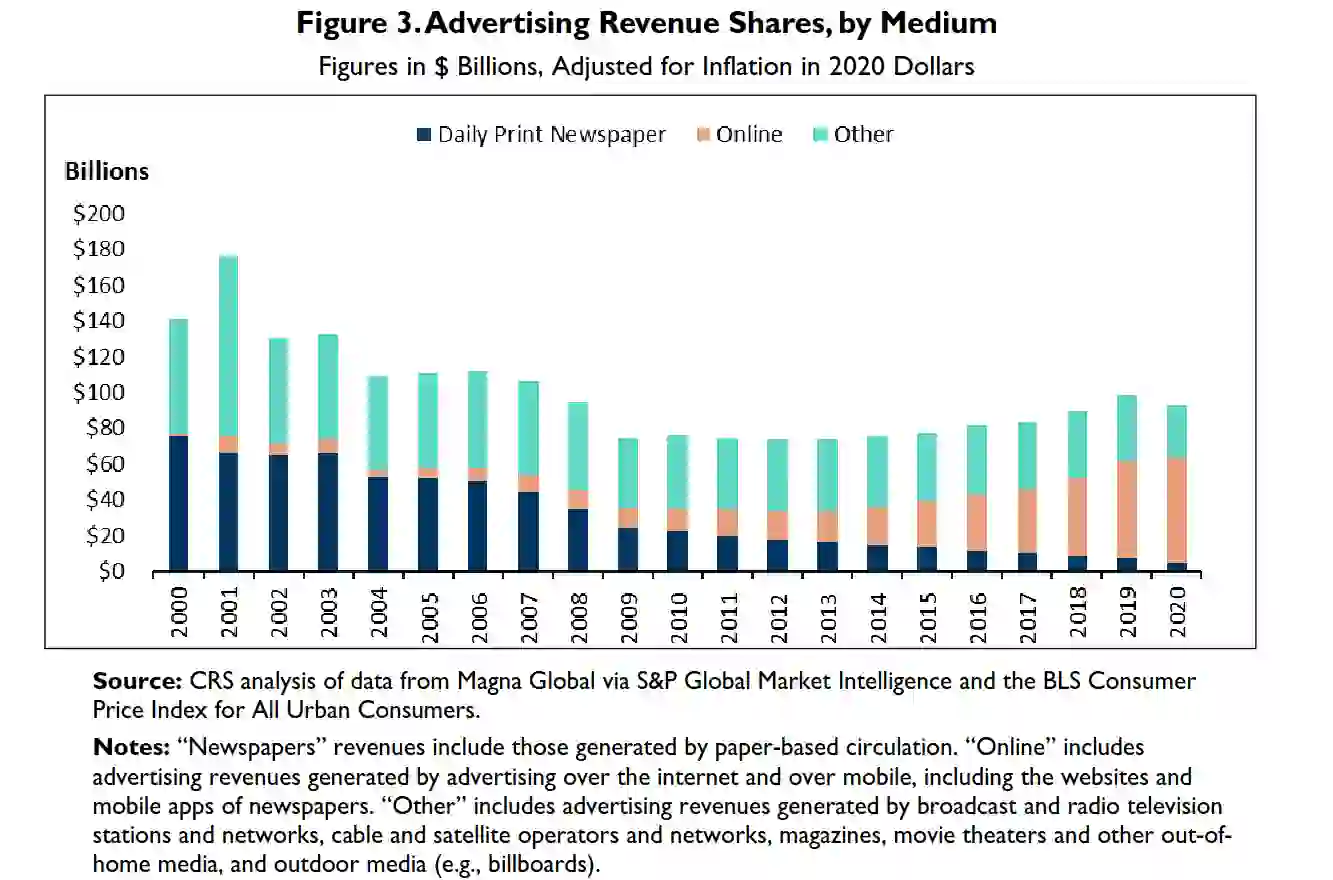
Snorting social {#social-era.wp-block-heading}
As newspapers struggled during the 2008 crisis, another profound shift was underway—the social era was starting. Facebook, YouTube, and Twitter started seeing dramatic growth starting around 2009. 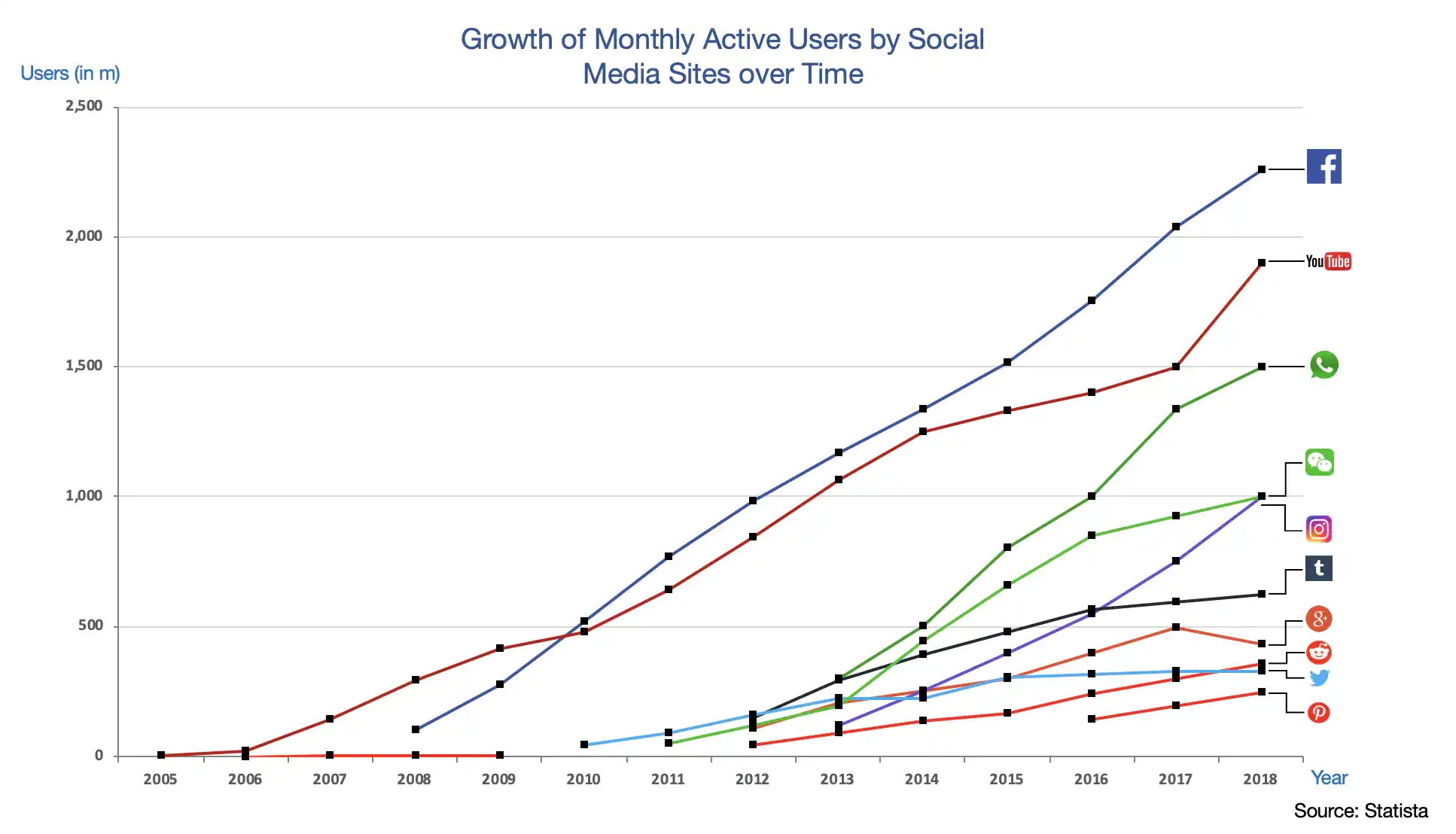
Social media became the dominant news source in a short time. Younger users preferred social media for news compared to older users, who preferred print and television.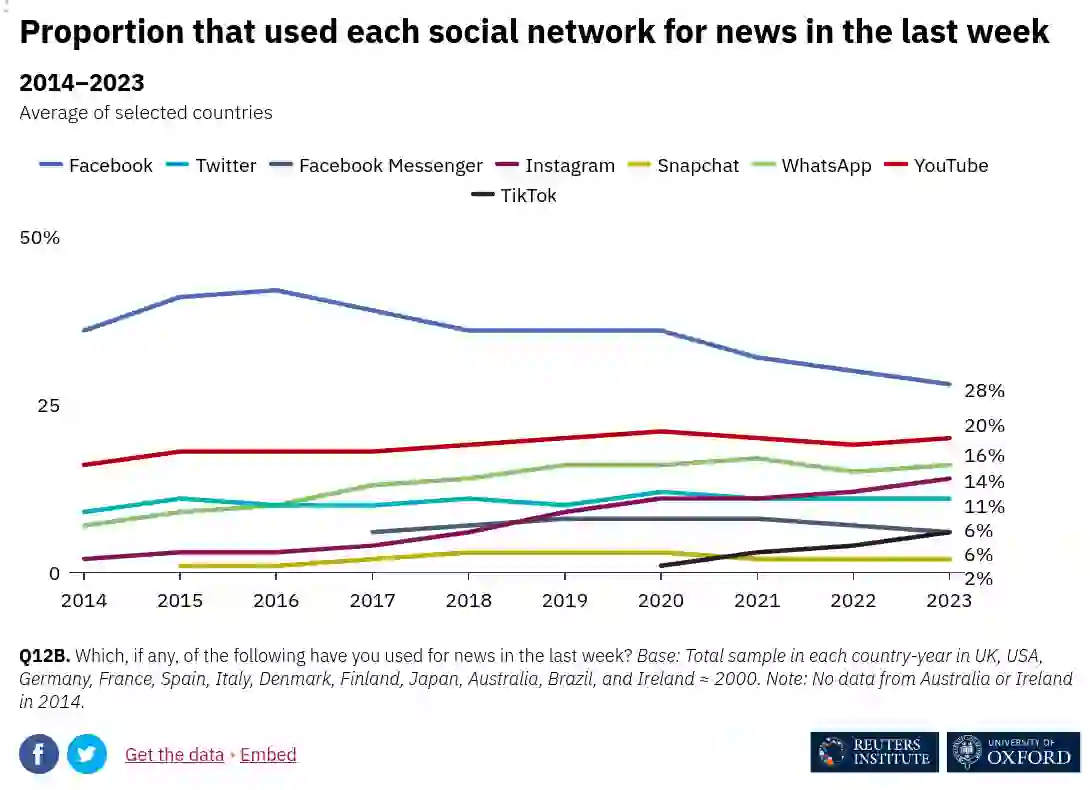
Newspapers jumped on the social media bandwagon with trepidation, even as the same platforms sucked away advertising dollars.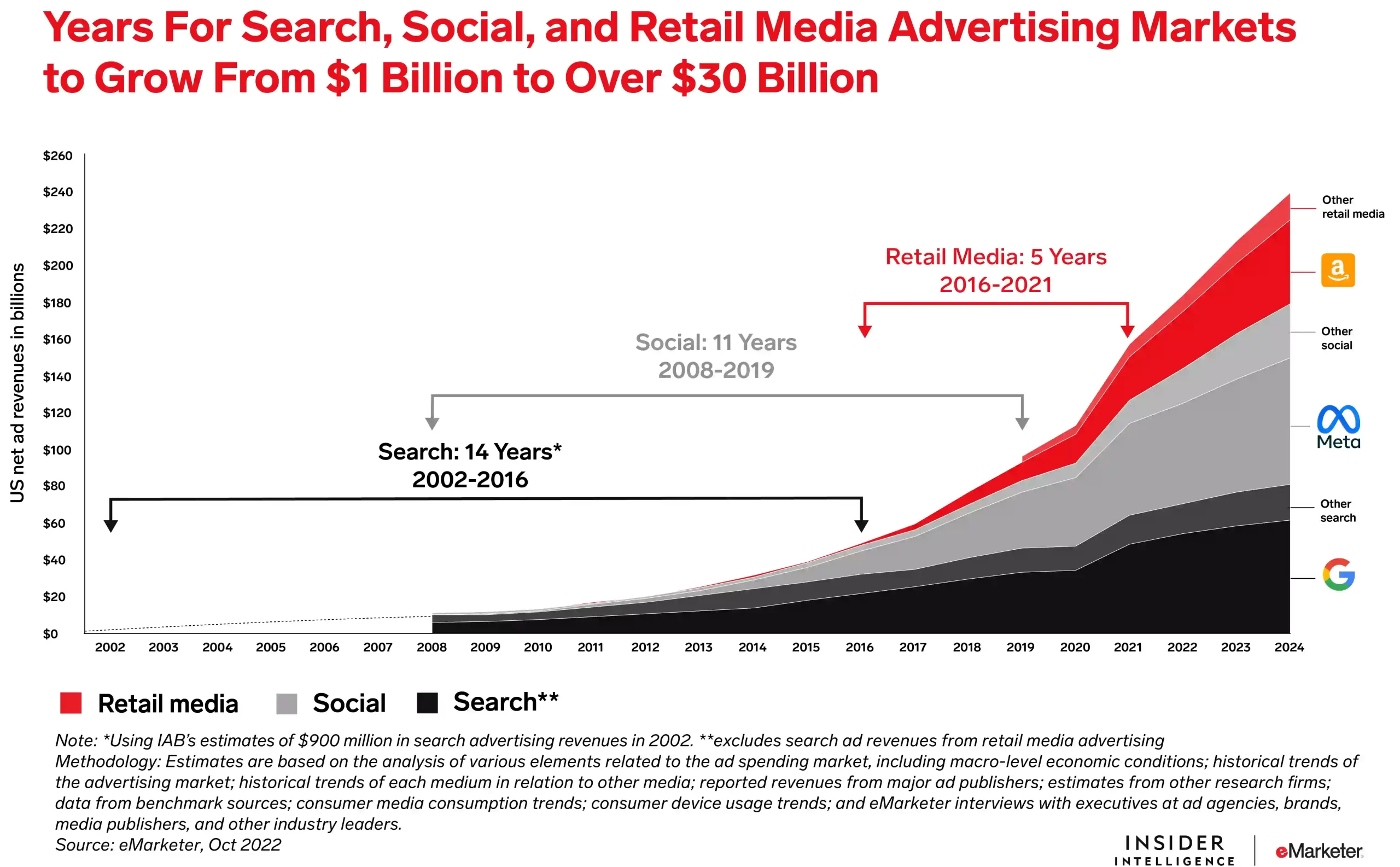
The news publishing scene in the early 2010s.
> At places where editors and publishers gather, the mood these days is funereal. Editors ask one another, "How are you?" in that sober tone one employs with friends who have just emerged from rehab or a messy divorce.
Bill Keller, executive editor, New York Times
The New York Times was representative of the challenges faced by all “legacy” news publishers. As it prepared to enter the social era, The Times was having an existential crisis and was in the midst of profound soul-searching.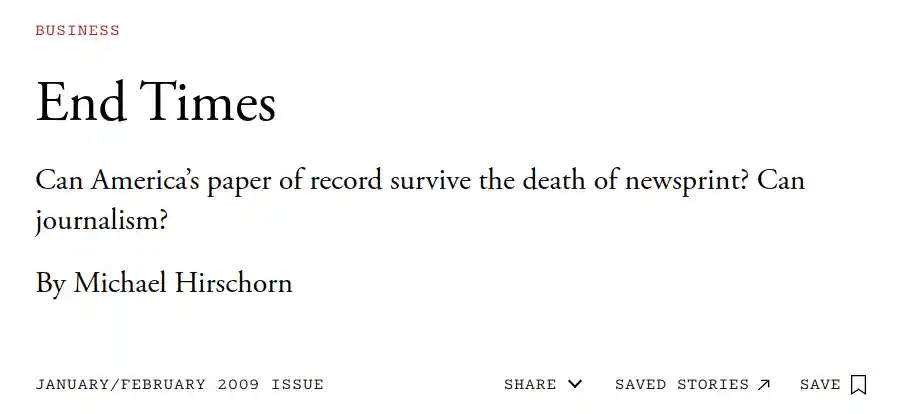
It entered the 2010s with falling print advertising revenues, declining circulation, mounting losses, and a massive debt load. The situation was so bad that The Times had to borrow $250 million from Mexican billionaire Carlos Slim at an interest rate of 14%. The Washington Post was in a similar boat and was bleeding money.
Neither company could stop the bleeding. The Times lost $543 million in 2006, $58 million in 2008, and $40 million in 2011. The Post lost $165 million in 2009. Petrified of falling into corporate hands, the two instituted multiple rounds of layoffs to stay solvent. Fears of bankruptcy loomed. — Jill Abramson, The Los Angeles Times
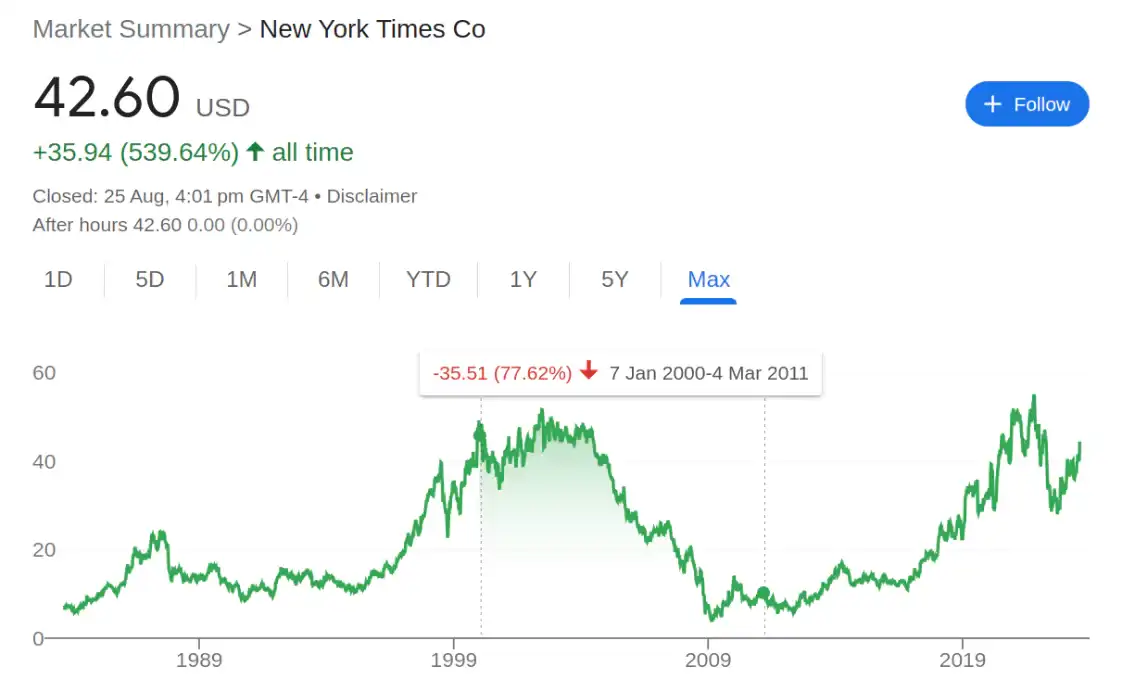In 2013, the media world was shocked to learn that Jeff Bezos, the founder of Amazon, had acquired the venerable Washington Post for $250 million. It probably wasn’t the end that Katherine Graham, who oversaw the paper through the Watergate scandal, would’ve liked. The acquisition came days after another billionaire, John Henry, the owner of the Red Sox and Liverpool FC, acquired the storied Boston Globe for $70 million.
For a long time, media observers argued that giving away news for free online was the “original sin” of news publishers.
It wasn’t.
Many papers tried to charge online, and all the experiments failed miserably. In 2011, The New York Times decided to erect a paywall, a move that was met with skepticism. In the ensuing years, a team of 8 led by Arthur Sulzberger (The Sulzbergers owned The Times) prepared a 96-page internal report that laid bare the dramatic challenges The Times was facing in adapting to the digital age. The report name-checked all the leading digital publishers like BuzzFeed, Huffington Post, and Vox. BuzzFeed, in particular, was mentioned 23 times, and in a profound twist of irony, BuzzFeed News leaked the report. Things couldn’t have gotten any worse for the embattled Times.
Arthur Greg Sulzberger had just written “The Innovation Report,” and my sense was that it dripped with a fair amount of envy for both BuzzFeed and Vice, especially because of ... They were ahead of the Times in an area called audience development. — Jill Abramson, former managig editor of The New York Times.
In stark contrast to the Times, BuzzFeed was the hottest media company of the era. Jonah Peretti started it as a side project in 2006 when he was at the Huffington Post. AOL acquired HuffPost for $315 million in 2001, and Jonah Peretti decided to focus on BuzzFeed full-time.
BuzzFeed was the poster child of this era. It built a massive brand by figuring out the secret to harnessing social traffic. People scoffed at BuzzFeed, saying that it was a site for cat pictures and listicles, but it was generating billions of views and impressions. Rather than post links or worry about the homepage, BuzzFeed tailor-made content for each social platform, and it was working.
Jonah Peretti was also a sharp operator who understood the media better than most seasoned players. Early on, he saw the writing on the wall that he had to build credibility for BuzzFeed. Borrowing a page from the well-worn playbook, Jonah Peretti hired Ben Smith from Politico to start BuzzFeed News in 2012. On the one side, BuzzFeed was posting silly pictures and goofy memes, and on the other, BuzzFeed News was breaking serious news stories.
People dismissed BuzzFeed as a gimmick and a relic of the social era, but they understood the power of social media and were the masters of virality. Their success inspired copycats across the globe, from India to Nigeria. In the US, a new generation of online publishers like Upworthy, Business Insider, Vox, NowThis News, Ozy, Mic, and Recode popped up on the scene. Other publishers like Vice Media, Engadget, and Refinery29 had their origins before the social era and were part of the scene as well.
The success of BuzzFeed caught the attention of venture capitalists (VCs).
Why?
This slide comparing the time spent on a medium vs. the advertising dollars from “Queen of the Internet.” Mary Meeker, a former VC at Kleiner Perkins, got VCs horny for media more than anything else. As journalist and author Alex Madrigal put it, “this is the chart that launched a thousand digital-media PowerPoints.” The message of the slide was simple: time spent on a form of media and the advertising dollar more or less converge over time.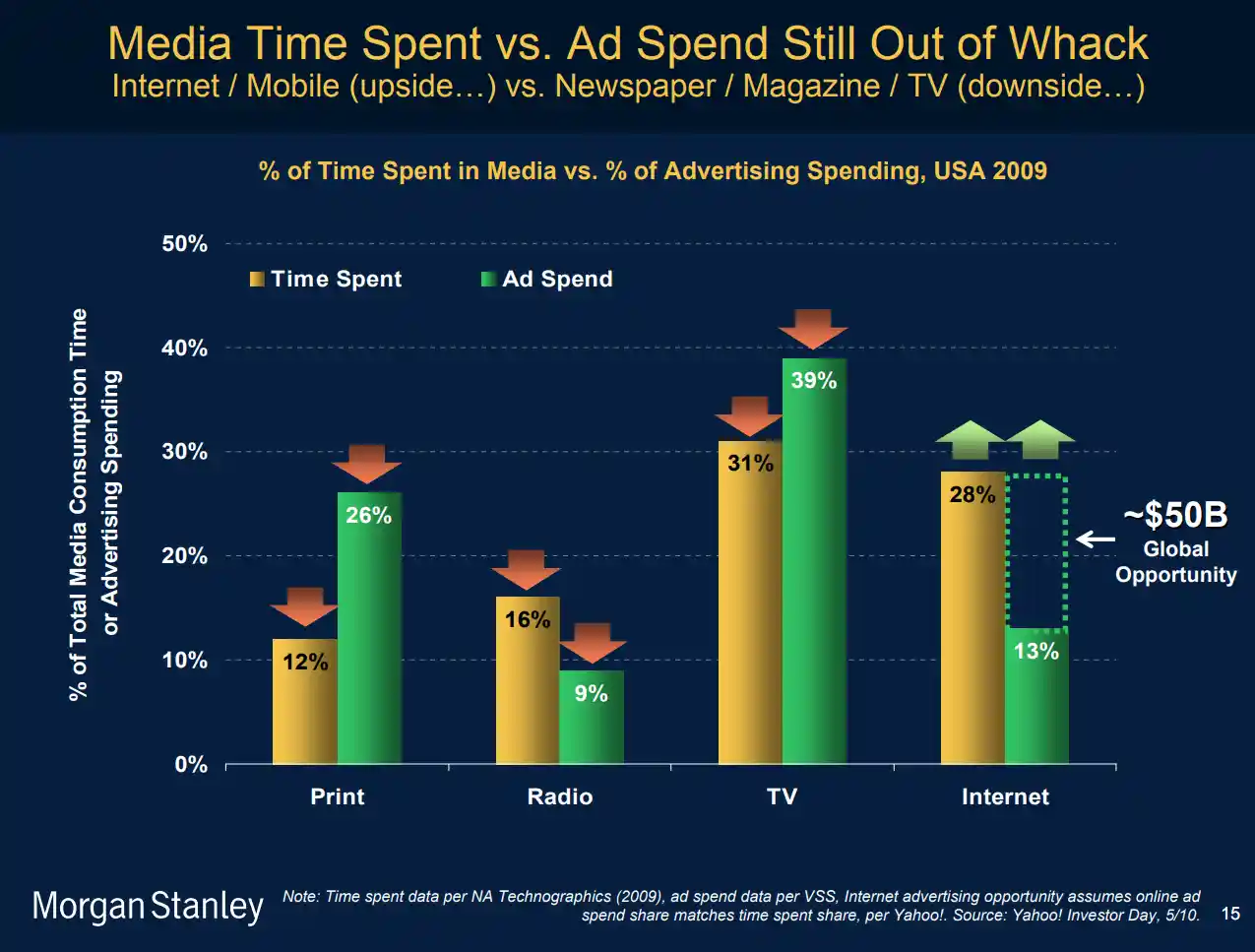

The popularity of the internet, social media, increasing smartphone penetration, and the assumption that new-age digital publishing startups could break the advertising dominance of Google and Facebook attracted a lot of VC money into digital media.
The newer, digital-first publishers raised stupid amounts of money. Threatened by the upstarts, legacy media companies from the Times, Fox, and Disney to NBC invested hundreds of millions in these startups. Legacy media companies invested more money than traditional venture capitalists (VCs).
Notable deals.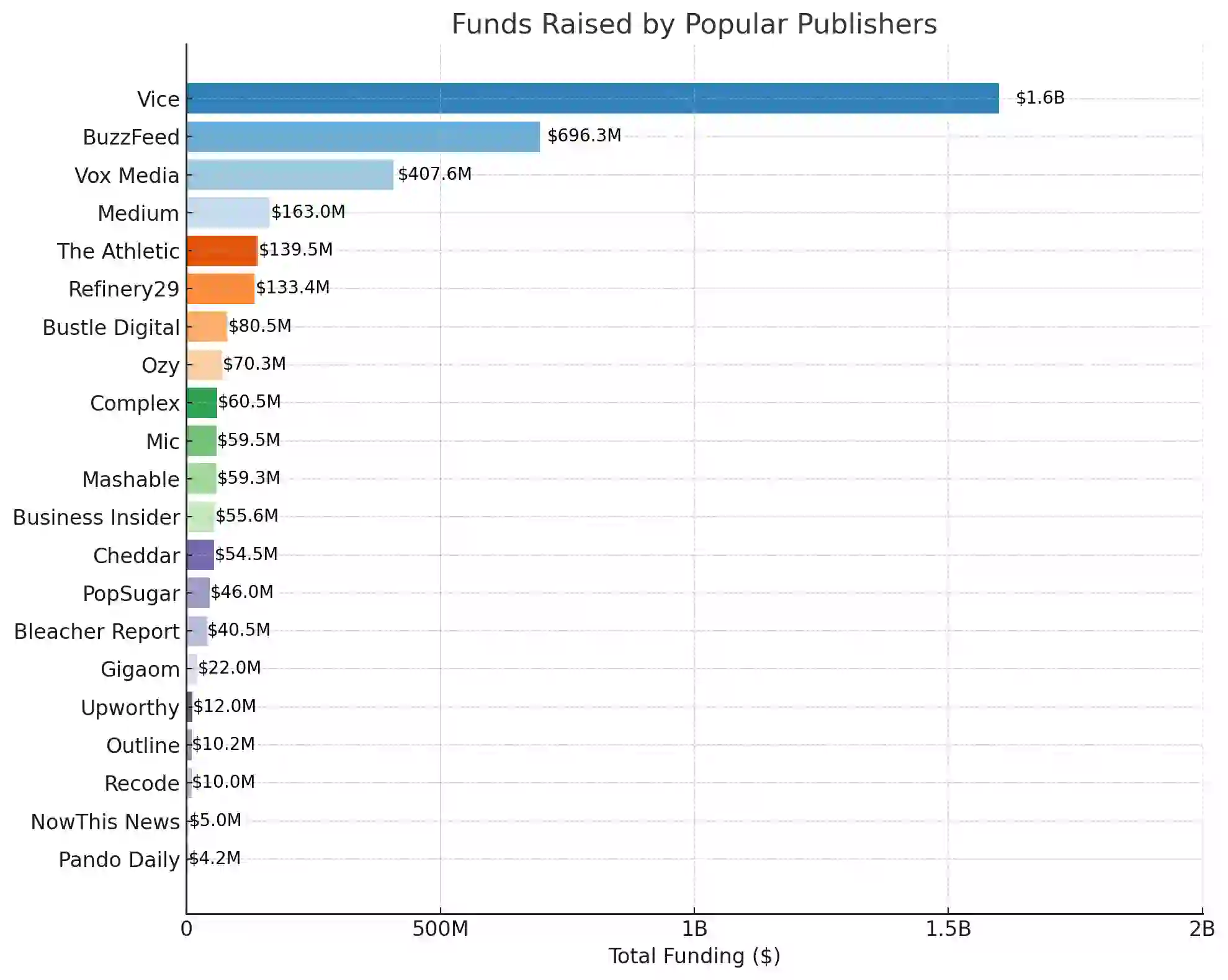
By 2010, social traffic referral traffic to digital publishers from Facebook was already in the single digits. In 2013, Facebook had Twitter envy and tweaked its algorithm, and social traffic to publishers shot up like a rocket. By 2015, Facebook had overtaken Google as the biggest source of referral traffic. Social traffic didn’t replace search but rather expanded the traffic pie. For the first time in a long time, the media seemed a little less funereal.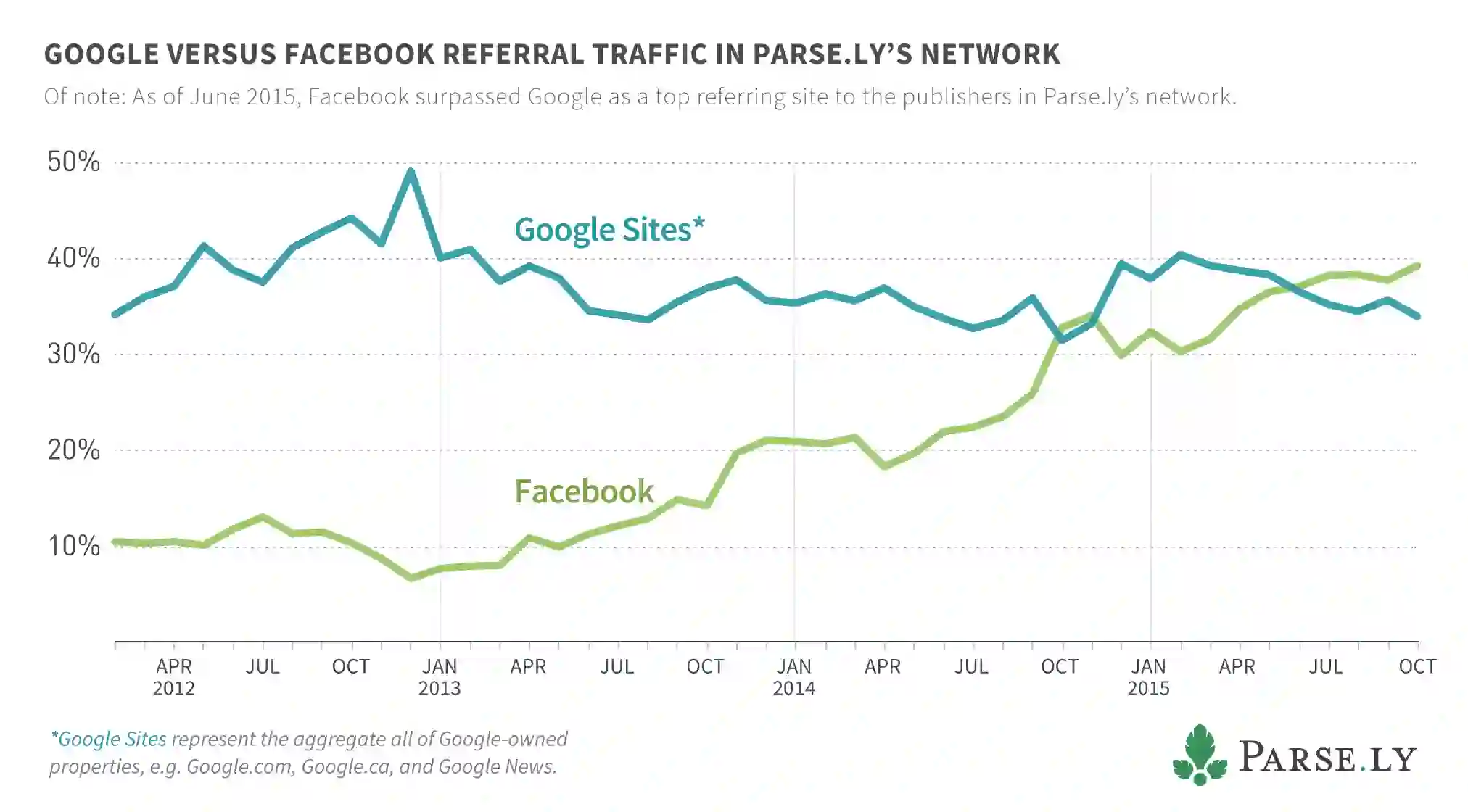
I didn’t know who coined the term “BuzzFeed Envy,” but it best captured the vibe of the era. Every publisher was envious of BuzzFeed because everything was working for them. Even storied legacy publishers like The New York Times and The Washington Post started aping BuzzFeed. It wouldn’t be a stretch to say BuzzFeed remade the digital publishing industry in its image for a while.
In 2015, an anonymous person in the media wrote a letter to the advice column at The Awl saying, “I hate myself because I can’t work for BuzzFeed.”
BuzzFeed is the most successful media company of our time. BuzzFeed is the future of the media business. BuzzFeed is the most widely recognized media brand among young people and will inevitably eclipse the major media organizations and one day become a super-hegemonic media power the likes of which we’ve never seen. They’re past being just a website/media organization. They’re a cultural institution. BuzzFeed is so powerful they can make the president use a selfie stick
In 2015, Ben Thompson, founder of Stratechery, called BuzzFeed “the most important news organization in the world.”
> In short, by not making money from display ads, and by extension deprioritizing page views, BuzzFeed incentivizes its writers to fully embrace Internet assumptions, and just as importantly disincentivizes pure sensationalism. There is no self-editing or consideration of whether or not a particular post will make money, or if it will play well on the home page, or dishonestly writing a headline just to drive clicks. The only goal is to create – or find – something that resonates.
The world was BuzzFeed’s oyster.
In contrast to BuzzFeed, there was Gawker—a loud and boisterous publication with a take-no-prisoners approach that took pride in defiling journalistic traditions. Gawker had a vehement disdain for those in power and prided itself on dragging them through the gutter. It wasn’t just a lurid gossip site; it had built a successful network of sites covering sports, technology, women, gaming, and productivity.
In the twenty-first century, the laws of traffic make demands, and we just follow. — Nathan Heller, The New Yorker.
Everybody was worshiping at the altar of traffic.
In 2012, A. J. Daulerio, the editor-in-chief of Gawker, announced a new experiment. Each day of the week, a Gawker writer would be on “traffic-whoring duty”—the goal was to publish things that would get the most eyeballs:
This week, the writers of this site have all agreed to participate in an obnoxious, but worthwhile exercise. Each day, a different staff writer will be forced to break their usual routine and offer up posts they feel would garner the most traffic. While that writer struggles to find dancing cat videos and Burger King bathroom fights or any other post they feel will add those precious, precious new eyeballs, the rest of the staff will spend time on more substantive stories they may have neglected due to the rigors of scouring the internet each day to hit some imaginary quota. The writers not relegated to traffic-whoring duty will still post, just less frequently than many of them are probably used to.
The stunt might have been a parody of what other publishers were doing at the time, but it captured the motif of the era—moar views. Post views were all that mattered. View count was a better indicator of quality than the opinion of a cantankerous curmudgeon sitting in the corner office yelling at the clouds.
Future media historians will remember 2015 because that was the year The New York Times invited Jonah Peretti for advice:
Jonah Peretti, the BuzzFeed CEO, was asked to address the New York Times board and give them advice. And then Cliff Levy, who's one of the senior editors, interviewed him and asked him, "If we hired you tomorrow to be CEO of The New York Times, what would you do?" And Jonah says to them, with a straight face, "Well first I would ask you for a raise. And then I would go into my office, lock my door, and cry." Just to give you a sense of sort of the arrogance and sense that we had the wind at our back and these guys were screwed. — Ben Smith speaking to Nick Gillespie, editor at large at Reason
The times were good for digital publishers.
The massive traffic from Facebook and other social media platforms gave publishers a false sense of comfort. Publishers believed that the good times would last forever.
They didn’t.
Facebook Giveth, Facebook Taketh Away {#facebook-dance.wp-block-heading}
In 2015, Facebook announced that it would prioritize posts from friends, and posts from publishers and brands would rank lower. The honeymoon for publishers was over. There was a sharp decline in referral traffic to publishers. The story of Upworthy is illustrative of the power that Facebook wielded. In 2012, Upworthy had about 3 million unique users, and by 2013, it had over 70 million uniques. By the end of 2014, the number had crashed to 20 million. The fate of other viral outlets like 9Gag, Viral Nova, Little Things, Distractify, etc., was similar.
The algorithm change caught publishers off guard, but it wasn’t a surprise if publishers had paid attention to the history of Facebook. There were signs as far back as 2013. Facebook had always tweaked its algorithm at regular intervals, and chaos ensued. Publishers were ignorant because they were hooked on Facebook traffic, and it wasn’t easy to wean themselves off. They had hitched themselves to Facebook, and there was no easy way off.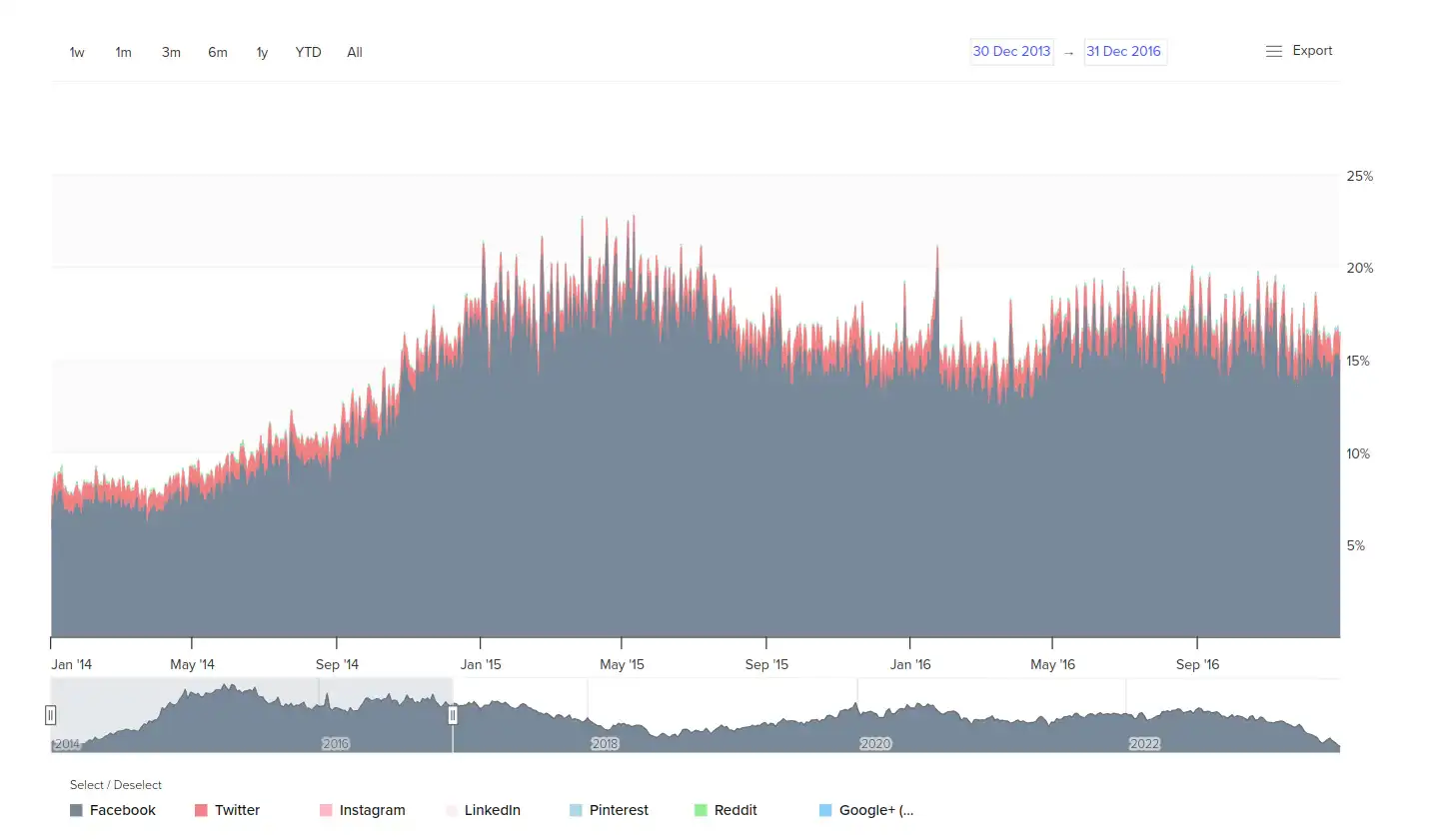
Trump saves journalism
Ok, no, I’m kidding. That was a BuzzFeed-style headline.
Depending on who you ask, 2015 was one of the best years in the history of the United States of America. It was the year Donald Trump, aka Mango Mussolini, announced that he was running for president. Trump’s unexpected victory, the incredible polarization, and the unprecedented attacks on the press were bad for democracy but good for publishers. Starting in 2015, several publishers like The New York Times, The Washington Post, Slate, and ProPublica saw a decent bump in subscriptions and traffic. While it was a small bonus for the bigger publishers, it didn’t help the smaller publishers much.
As Trump was making America great again, things were taking a turn for the worse for the digital media outlets. Facebook was throttling the traffic, and the good times of bountiful social traffic were over.
Pivot {#pivot-to-video.wp-block-heading}
Video had become big, and YouTube, Instagram, and Snapchat were ascendant by 2015. The advertising dollars were also moving to video, and Facebook wanted a piece of the action. Months after deprioritizing news articles in the feed, Facebook announced the launch of Facebook Live. In 2016, Mark Zuckerberg made an announcement that would change the fortunes of digital publishers forever. In an interview with BuzzFeed, he said:
> We’re entering this new golden age of video. I wouldn’t be surprised if you fast-forward five years and most of the content that people see on Facebook and are sharing on a day-to-day basis is video.
By 2016, the dreams of a digital publishing revolution had collided head-first with reality. The new generation of startups realized during the 2000 dot-com bubble that making money from news was hard. The new crop of publishers were learning the same lessons in 2016. These companies had taken sizable investments from VCs and were under pressure to generate revenues. Major publishers like BuzzFeed, Mashable, and Vice went all in on video in a desperate bid to eke out some ad dollars. Many publishers even fired editorial staff to pivot to video.
The shift to video was based on the same vague assumptions as the VC investments in digital media based on the Mary Meeker slide: that a lot of people watching TV will shift to online video.
The pivot to video was a disaster.
With months of Zuckerberg and other top Facebook executives touting the glorious future of video, The Wall Street Journal published a damning article that Facebook had overstated video metrics by 60–80%. It was sued by a group of advertisers in 2017 and settled the suit in 2019.
Facebook changed the algorithm again in 2018. It prioritized content from friends and family and deprioritized video and brand content. It was déjà vu for publishers all over again. Referral traffic from Facebook to publishers dropped once again.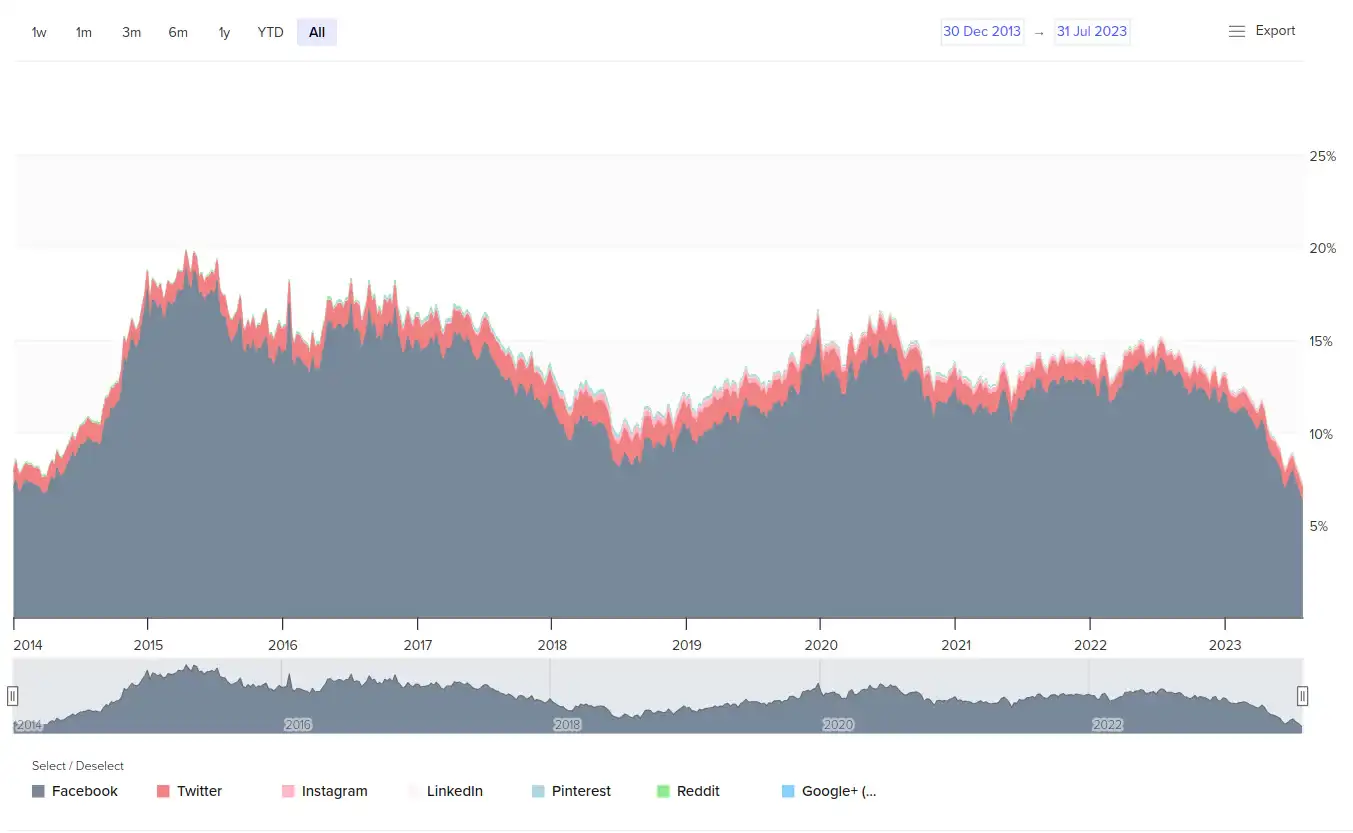
This wasn’t the only time Facebook screwed over publishers.
By 2015, mobile traffic was set to overtake desktop traffic. At the same time, more Americans were consuming news on mobile.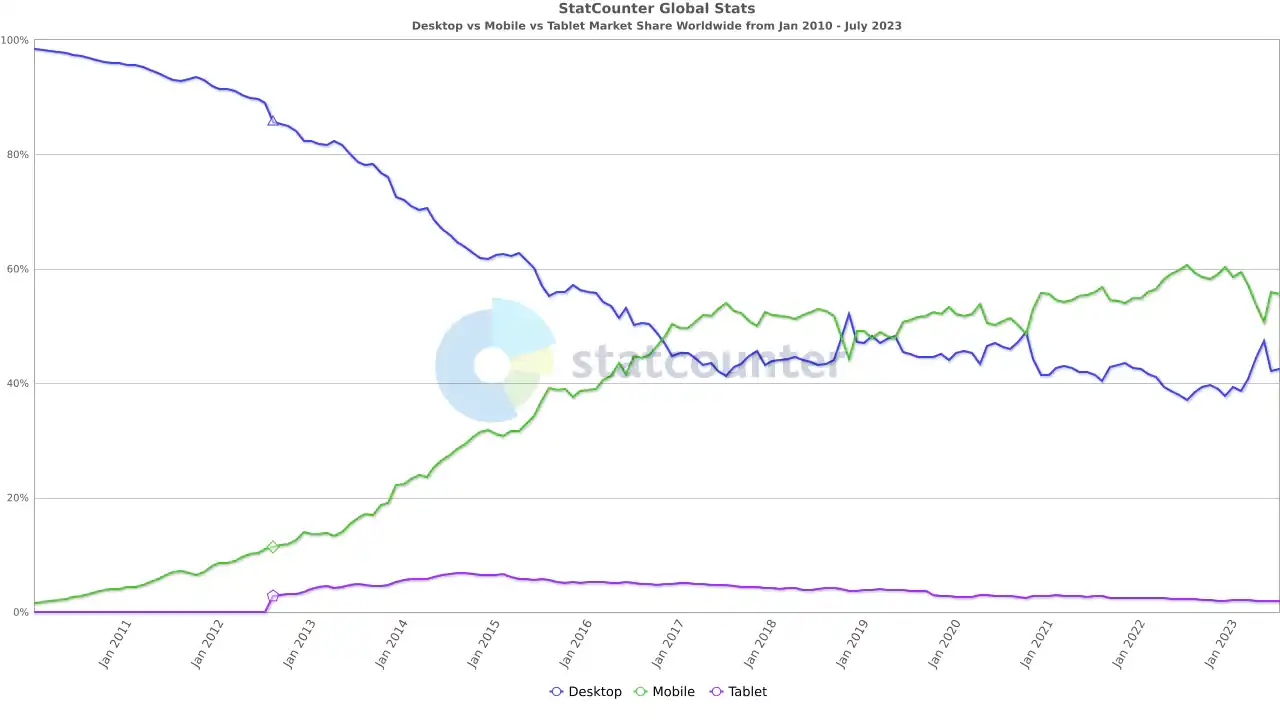
Facebook saw the writing on the wall that it had to capitalize on mobile to continue growing advertising revenues. In 2015, it launched a new publishing format called Instant Articles. It was a mobile content format in which Facebook would host the articles in partnership with publishers. The pitch was simple: mobile websites sucked, and Facebook would take care of the experience. It could load articles faster, retain readers better, and increase ad revenues for publishers.
It didn’t.
By 2017, major publishers had stopped publishing on the platform after making peanut in ad revenues from instant articles. Note again that I used “peanut” and not “peanuts.”
In an effort to compete with Facebook, Google introduced Google Accelerated Mobile Pages (Google AMP). Much like Instant Articles, AMP rendered mobile sites faster by stripping them to the bare essentials and hosting them on Google’s servers. But as David Pierce, Editor-at-Large at The Verge, wrote in a brilliant piece, Google AMP was driven more by desperation to not lose out on mobile advertising than “an altruistic move.”
“If Google said, ‘you must have your homepage colored bright pink on Tuesdays to be the result in Google,’ everybody would do it, because that’s what they need to do to survive,” says Terence Eden, a web standards expert and a former member of the Google AMP Advisory Committee. One media executive who worked on AMP projects but who, like other sources in this story, requested anonymity to speak about Google, framed the tradeoff even more simply: “you want access to this audience, you need to play by these rules.” — The Verge
Google also made it impossible for publishers not to use AMP because it said that AMP news stories would rank higher in its news carousel. Much like how Facebook made publishers dance to its tunes, so did Google. Many publishers saw a traffic bump because of AMP, but there was disillusionment by 2017. While traffic rose, publishers made far less money from AMP pages than on their mobile websites. The AMP technology was too restrictive. Publishers soon ditched AMP, just like Instant Articles. These were the two big examples of the power platforms wielded over news publishers, but there were countless others.
My favorite example of how platforms can destroy livelihoods is the endless pivots of Medium, started by Evan Williams of Blogger and Twitter fame. It began as a cool blogging platform with a clean, no-nonsense design.
-
Early on, it commissioned freelancers but ditched them in a year.
-
It then launched advertising and attracted a bunch of publications to move to Medium’s CMS. It again ditched ads and fired a third of the staff, leaving the publishers depending on the ad money in the lurch. These small publications with limited resources were forced to move elsewhere.
-
In 2018, it executed a perfect rug pull by canceling its membership program for publishers that had moved to the platform without notice.
-
In 2019, it again got into editorials and launched a series of publications with fantastic talent. True to its nature, it executed another rug pull like a blue-chip shitcoin by firing 75 editorial people.
Fool me once; shame on you. Fool me 37 times, shame on, well, weather! It’s the weather!
Journalists and writers became the precariat.
> The precariat, a mass class defined by unstable labor arrangements, lack of identity, and erosion of rights, is emerging as today’s “dangerous class.” As its demands cannot be met within the current system, the precariat carries transformative potential. To realize that potential, however, the precariat must awaken to its status as a class and fight for a radically changed income distribution that reclaims the commons and guarantees a livable income for all. Without transformative action, a dark political era looms.
Beginning of the end… {#turning-point.wp-block-heading}
2017 was a turning point for the digital darlings. Most of them were still in the midst of the great pivot to video, but the cracks were starting to show.
-
The year started with Medium laying off 50 employees and pivoting away from advertising.
-
Then Oath, the abominable offspring of Yahoo and AOL, laid off 500 people.
-
Traffic to Mic was down 70% as it continued its pivot to video.
-
BuzzFeed, which wanted to IPO more than Hillary Clinton wanted to be president, missed its revenue targets and laid off 100 people.
-
Mashable had raised ~$60 million and was once valued at $250 million. Ziff Davis acquired it for $50 million.
-
Univision was looking to sell a stake in Gawker (Fusion Media) after a year of acquiring it.
This was just 2017. 2018 wasn’t any better for digital media outlets as the drumbeat of bad news got louder.
-
In 2018, Vice missed its revenue target.
-
Disney, which had invested $400 million in Vice, wrote down its stake by $157 million.
-
Mic was the supposed go-to news destination (not) that had raised almost $60 million. Bustle Digital acquired it for $5 million after letting the majority of the staff go.
-
Atlantic Media sold Quartz to Uzabase for $86 million.
The story of Quartz is also instructive of the social era of publishing. Atlantic Media launched Quartz in 2012 as a publication aimed at the “global business elite,” with former WSJ editor Kevin Delaney at the helm. It was targeting a niche dominated by the Financial Times, The Wall Street Journal, The Economist, Reuters, and Bloomberg. Quartz was free and relied on bespoke native advertising and beautiful banner ads. Within a year, its traffic had overtaken The Economist.
Quartz had a culture of innovation and experimentation. Its advertising was top-notch, and so was its storytelling, which melded facts with beautiful visuals. It created amazing newsletters long before others jumped on the bandwagon. In 2016, it launched its widely praised news app that looked like a messaging app instead of an old, boring collection of headlines. It was even profitable for a brief moment. But like the other publications of the era, Quartz became a casualty of Facebook’s fickleness. It then pivoted to quantity, video, then subscriptions, and was sold in 2018 only to be acquired back by co-founder Zack Seward in a weird deal. After failing to raise money, it was sold to G/O Media in 2022.
As an outside observer, there were two moments in 2018 that signaled the end of the scale and the social era. The first was when Disney wrote off its entire $400 million investment in Vice Media. The second moment was when Jonah Peretti pitched consolidation with other digital media publishers as a way to wring some dollars from Google and Facebook:
The better solution, he said, would require a much more audacious effort: a series of mergers with five or six top internet publishers. “You have Vice and Vox Media and Group Nine and Refinery,” Mr. Peretti said. “There’s tons of them that are doing interesting work.”
> Mr. Peretti extolled the logic of combining forces: A larger entity could lobby for better business terms from Facebook and Google, and in turn supply them with videos and articles safe for users and friendlier for advertisers.
Vice was the other darling of the social era like BuzzFeed. In contrast to BuzzFeed’s fun and quirky image, Vice had built an edgy brand with its irreverent and gonzo approach to covering news and culture. It started in 1994 as a counterculture magazine and survived the dot-com crash but had built a following among young millennials. It parlayed its claim to millennial attention to raise $1.6 billion. It was evident that there was a gaping chasm between the numbers Vice claimed and the actual numbers early on. The dodgy tactics they used to goose their numbers were an open secret. But legacy media publishers were so threatened by digital upstarts that James Murdoch, Rupert Murdoch, and Disney threw millions at it.
The ambitions of Vice were never compatible with reality. But that doesn’t mean they were all fluff and had no substance. With BuzzFeed, they did more to break the old-school sclerotic notions about how “news” should be reported. Like BuzzFeed, they appealed to underserved millennials who had different tastes and sensibilities. But the fact remains that they were in a low-margin media business, and the VC-imposed expectations were incompatible with reality.
I want us to be the next MTV, ESPN and CNN rolled into one. — Shane Smith
Its bet to redefine television was a disaster, and the company was preoccupied with raising the next round. Add this to the frat boy culture, and allegations of rampant harassment were a constant distraction for the company.
It’s not that Vice didn’t have any substance; they had their moments. Remember the ISIS documentary?
But moments are all they had. Any business that relies on going viral cannot survive for long. On its best day, it was an “interesting” publication. At no point in its existence could it justify the lofty valuations that rose from a billion to five billion.
Throughout the late 2010s, things continued to get worse for publishers. They were stuck between a rock and a hard place while having to watch a truck with its brakes cut off speed towards them. Publishers bet on social was an epic failure; the pivot to video was an act of Hara-kiri; advertising revenues were a peanut; and none of the publishers had built subscription products. The only solution they could come up with was more scale. The consolidation continued, but not in the way Jonah Peretti had hoped.
A final gasp for scale for a desperate IPO
In 2019, Vox Media acquired New York magazine. Soon, Vice Media acquired Refinery29, which catered to women, in a deal valued at over $400 million. In 2020, life came full circle when BuzzFeed acquired Huffington Post. In 2021, BuzzFeed acquired Complex for $300 million. The BuzzFeed acquisitions, in particular, were a desperate attempt to build scale for an IPO. In December 2021, the company went public through a SPAC, raising just $16 million instead of the $250 million it had hoped for. It’s been.
Of the three publishers, only BuzzFeed managed an IPO. But it was a disaster. The stock is trading 95% below its IPO price.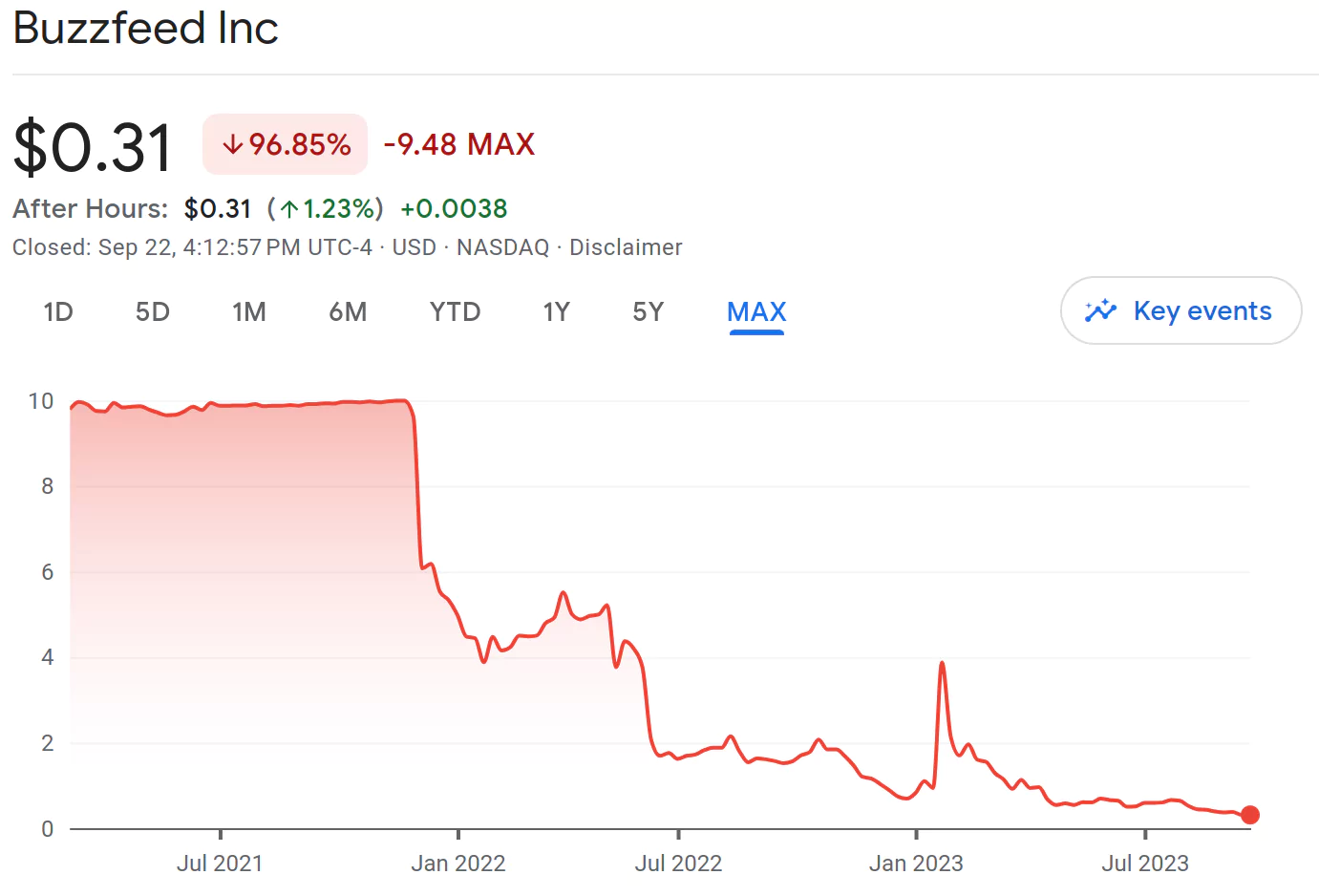
The end of the beginning came in 2023.
In February 2020, Vox Media raised $100 million at a 50% discount to its peak valuation of $1 billion. Vox Media was a shadow of its former self, but it was still standing, unlike the fate that would befall its two other competitors.
In April 2023, BuzzFeed announced that it was firing 150 people and shutting down the award-winning BuzzFeed News. In hindsight, maybe Ben Smith (the former editor of BuzzFeed News) quitting was a sign. It was a sad end to a newsroom that punched above its weight and published some remarkable stories, including the Pulitzer-winning expose of the mass internment camps of Uighur Muslims in China.
> Additionally, I made the decision to overinvest in BuzzFeed News because I love their work and mission so much. This made me slow to accept that the big platforms wouldn't provide the distribution or financial support required to support premium, free journalism purpose-built for social media.
Jonah Peretti
Nick Denton’s comment 11 years later seems prophetic:
> Ben Smith's quick-hit campaign "scoops" are about as viral as cat videos. That fits with Buzzfeed. But I suspect Smith has too much respect for journalistic accuracy to be comfortable with Jonah Peretti's stunts. Remember that Buzzfeed's founder made his name with fake news, like the Nike letter. And Peretti's craving for the quick viral fix will not be satisfied by the nourishing fare put out by prestige hires like Doree Shafrir and Matt Buchanan. Either before or after acquisition, Buzzfeed will collapse under the weight of its own contradictions.
Nick Denton, founder of Gawker Media | The Guardian
Vice Media, which was valued at $5.7 billion in its last round, filed for bankruptcy in May 2023. It was bought out by a consortium for $225 million. Just to be clear, $225 million is wayyy less than even a billion, let alone $5.7. The Vice hustle of somehow always raising another round came to an end. Vice’s fate was sealed in 2017 when it raised $450 million from TPG, which would make moneylenders look like sweethearts.
> TPG’s and Sixth Street’s money came in the form of preferred stock rather than common shares. The preferred stock paid a 12 per cent dividend in the form of additional stock and junior debt rather than cash and had other rights for priority payment which contributed to a “complex and restrictive equity structure”, according to bankruptcy filings. This investment, however, did leave room for higher priority senior loans to be undertaken by Vice in future years.
It was a depressing end for two of the biggest names in digital media. It wasn’t just BuzzFeed and Vice. In 2023, the media industry as a whole will have laid off over 1700 people.
Remember when everybody thought that these digital upstarts would kill legacy media publishers like the Times and the Post? Remember that time when legacy media threw hundreds of millions into these companies to not be killed by them? Remember all the bombastic pronouncements of the digital publishing revolution? It feels like yesterday.
It’s ironic that the disruptors are dead, and the legacy media publishers are alive and, in most cases, thriving. T_he New York Times_ pulled off a successful transition to online subscriptions. Legacy publishers became BuzzFeed and Vice faster than they could become the new legacy publishers.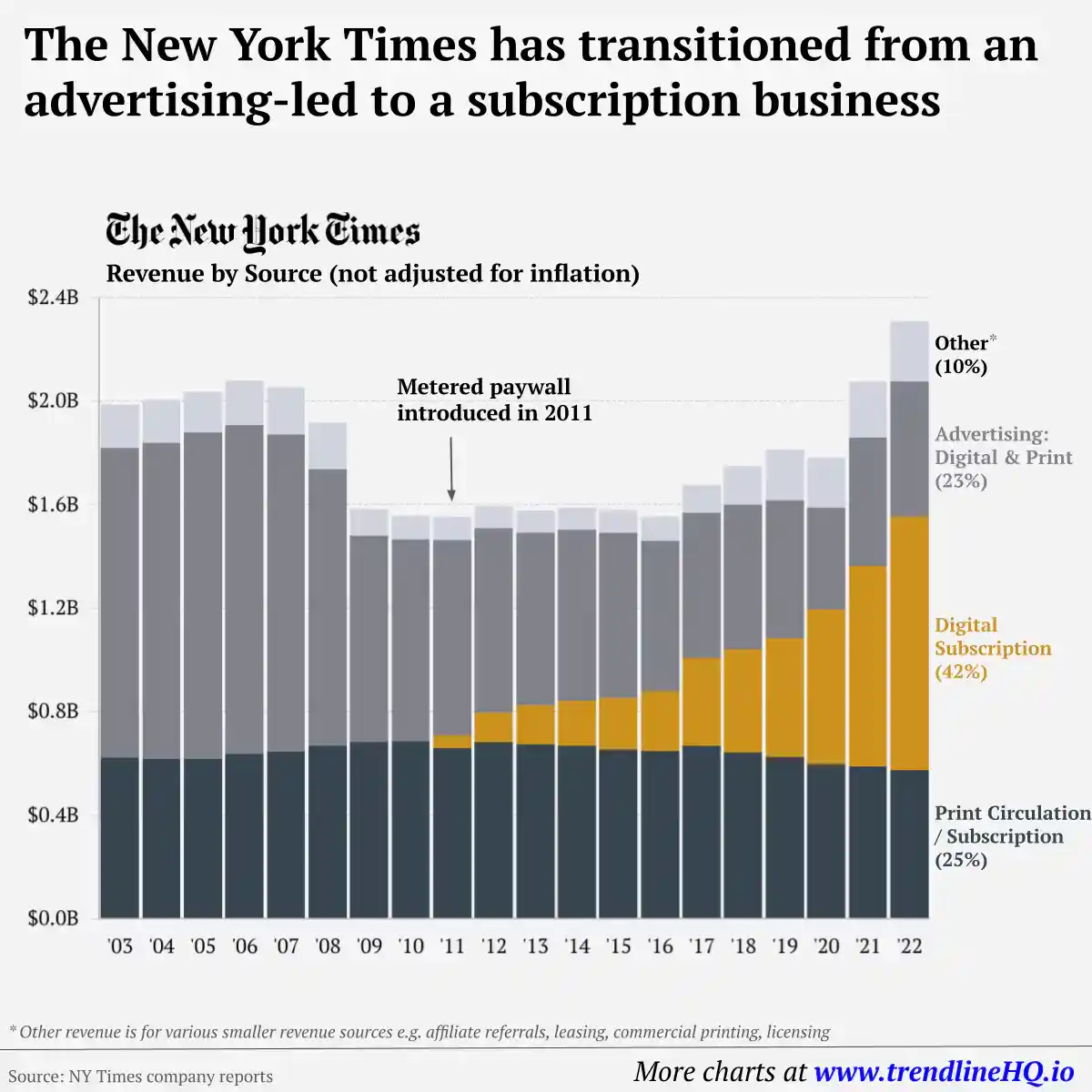
The Washington Post is struggling but still standing. The Atlantic, in which another billionaire, Laurene Powell Jobs, owns a majority stake, is also doing well.
I believe The Guardian had the most stunning transition from print to digital. The Guardian has a unique structure. It’s owned by a trust whose sole duty is to ensure the independence of the publisher. The storied publisher, known for its legendary investigative exposes such as the news of the world hacking scandal, Snowden revelations, Paradise Papers, Panama Papers, and Wikileaks documents, had never made a profit since 1998. It first made a profit in 2019 after launching a membership program based on voluntary reader contributions. Today, it has over 1 million online paying users, a mix of digital subscriptions, and recurring voluntary contributions, all without a paywall.
The Financial Times and The Economist are thriving and going from strength to strength. Legacy giants Condé Nast and Hearst were supposed to be put down with mercy but are doing better than ever.
On the other end of the spectrum, as long-time media observer Brian Morrissey notes, the boring old-school publishing business did well:
> The “winners” of the last decade were not BuzzFeed, Vice, Vox et al, but more “boring” SEO businesses like Dotdash, Future, Red Ventures and Ziff Davis.
What went wrong? {#what-happened.wp-block-heading}
Writing a postmortem is easy with the enormous privilege of hindsight, but many of the sad fates of digital media publishers were predictable. It was as predictable as the outcome of what would happen if you tickled a horse’s buttocks.
What was the original sin of newspapers?
Not charging for news?
Failing to innovate?
Not building digital businesses separate from print?
Or was it relying on an advertising-funded model?
This is one of those “Is there a god?” questions. But here’s how I think about the question: Of course, newspapers were overly reliant on advertising, and of course, a lot of newspapers failed to innovate. That being said, could American newspapers have transitioned from print to digital without disruption?
Impossible.
A monopoly advertising bounty underwrote the success of newspapers in the 20th century. That bounty vanished with the internet, and so did the business model. That model was incompatible with the internet era.
Change is always messy, especially when dealing with a radical paradigm shift like the internet, which has destroyed many old ways of producing and distributing news. Could the newspapers have done more to prepare for digital? Of course, yes, but that’s like telling someone they should’ve taken an umbrella after it rains.
What was the original sin of digital-first publishers?
The usual suspects are:
-
Relying too much on social media platforms for distribution
-
Publishing useless and undifferentiated content.
-
Focussing too much on hacks and optimization instead of quality.
-
Focussing on quantity vs. quality.
-
Taking venture capital money (VC)
All these are true.
The way I see it, digital publishers’ biggest mistake was taking money from venture capital.
Let me be clear.
I’m saying taking money to start a business is bad. Of course not. Few can afford to start a digital media business on their own dime. But the problem was that digital media outlets took the wrong kind of money from the wrong people. This quote sums up the issues with venture money:
“Big problems have occurred when you have founders who have unwillingly or unknowingly signed on for an outcome they didn’t know they were signing on for,” said Josh Kopelman, a venture investor at First Round Capital, an early backer of Uber, Warby Parker and Ring. He said he was happy that companies were embracing alternatives to venture capital. “I sell jet fuel,” he said, “and some people don’t want to build a jet.”
Media was never a jet fuel business. News was profitable for a brief period in the 20th century because newspapers were monopolies until the internet. That was an aberration.
As long as a newspaper was the only one in its community, its profits were certain to be extraordinary; whether it was managed well or poorly made little difference. (As one Southern publisher famously confessed, “I owe my exalted position in life to two great American institutions – nepotism and monopoly.”)
Original sin number one: hot money
The original sin of digital media publishers was being convinced by VCs that news could be profitable. News has never been profitable. It would’ve been obvious if digital media entrepreneurs bothered to read history. News publishing has always been a blood sport, with the best days being when papers had a runway of years instead of months. Newspapers have always barely survived and died but rarely thrived. Just getting rid of the fixed costs of starting a newspaper and publishing online doesn’t change the economics of the news business.
For a brief moment, VCs and publishers bought into the delusion that digital publishing was a tech business—it wasn’t. Changing the form and medium of publishing words doesn’t change the economics of the news business. It still boggles my mind that BuzzFeed and Vice could raise hundreds of millions on the fantasy that news publishing could be a tech business. The other wrinkle, as I alluded to earlier, is that few people care about news. This is why news has never been profitable on its own and has always been subsidized.
> Building a profitable serious news channel suffers from the somewhat intractable fact that serious news has never been profitable, moderator James Fallows said. Instead, it's always attached itself to a "host body," like the Travel Section of the Los Angeles Times, or the car and real estate sections of other big papers. Perhaps the problem with TV news isn't that the networks aren't giving audiences what they want. It's that TV news is giving audiences exactly what they want, and some people don't like the outcome. The most profitable networks aren't "serious," and the most "serious" networks aren't profitable.
Derek Thompson
Media is often a terrible standalone business but is good support for other businesses. The TV business is now dominated by tech companies, a trend likely to continue. That isn’t particularly new. “Media has historically been owned by non-media businesses,” Joe notes, going back to early radio and then cable systems owning TV networks. “The business of media has outsized influence but undersized monetization.” The result: “I don’t know the media business works at scale without alternative models.”
Joe Marchese
Venture capital funds have a 10-year lifecycle, but it takes time to deploy capital and exit investments. Once you consider that, the average holding period of VC funds drops to about five years. Is this enough to build a profitable media business, even if you ignore the economics of digital media? Hell no. It’s not enough to build a good media business, let alone a profitable one.
The result of this delusion was that news and digital publishing became a game of scale. In the 2010s, digital media outlets believed that if they could achieve scale, they could sell that to advertisers. The problem was that they never owned the attention; they were renting it from Google, Facebook, Twitter, and other platforms. They were forced to jump from one burning building to the next in the race for scale.
Remember the time when the Kindle was supposed to save newspapers? That was the beginning.
-
The Apple iPad was going to save journalism.
-
Social media was going to save news and journalism.
-
Listicles, clickbait, and pandering to “millennial sensibilities” were going to save news and journalism.
-
User-generated content was going to save news and journalism.
-
Distributed publishing was going to save news and journalism.
-
Micropayments were going to save news and journalism.
-
Crowdsourcing was going to save news and journalism.
-
Slideshows and autoplay videos were going to save news and journalism.
-
Pivoting to video was going to save news and journalism.
-
Stories, reels, and shorts were going to save news and journalism.
-
In 2023, artificial intelligence (AI) is going to save journalism.
Nope.
It’s a cliché to blame the woes of digital publishers on all these things, but that’s not what I mean. Experimenting is not a bad thing. I understand that it’s easy to write such things with the privilege of never having been a journalist or run a news business. If I were a publisher, I would’ve done the same. Two quotes come to mind. The first by Clay Shirky:
> People committed to saving newspapers demanding to know "If the old model is broken, what will work in its place?" To which the answer is: Nothing. Nothing will work. There is no general model for newspapers to replace the one the internet just broke.
And this from Troy Young, the former president of Hearst Magazines:
> Publishing, sadly, is bit of a perpetual hackathon. You are always looking for the next vein in this pockmark drug addict arm to find like a new source of revenue.
The issue was that trying new things often became an all-or-nothing bet for publishers. Then there’s the case of digital publishers hitching their wagons to social media platforms. The fact that you shouldn’t rely on one thing should have been common sense, but it wasn’t.
The 2010s were an example of why knowing history is important. I started following digital media around 2013. Algorithmic changes by Facebook would always lead to a lot of hue and cry about how the “evil platforms” are “killing news.” If these publishers knew even a little about internet history, then they would’ve realized this was always the case. Google and Facebook have changed their algorithms at regular intervals. Whenever these two companies changed something, businesses and websites always suffered.
Before Facebook, there was Google, which updated its algorithm at regular intervals. There was a term called “Google dance” to describe the changes in page ranks after an update. Every Google search algorithm update would kill hacky models that relied on gaming the algorithm.
You have to hand it to the original bloggers; they knew this from the start of the social era:
> I guess my point is, if you’re one of these people considering giving up on blogging in exchange for paying more attention to Facebook, Twitter, YouTube and MySpace, or whatever they throw at us mere mortals, bear in mind you are giving up on something rather unique and wonderful.
Hugh McLeod
Publishers had to be on social media platforms, but they often became their major source of traffic. Times were good, and publishers went for the ride and didn’t bother diversifying their reader base.
News has always been a small part of the content shared on Facebook but has generated a disproportionate amount of noise. As the Trump era dawned, Facebook realized that the bad PR it was getting over how news showed in its feeds wasn’t worth the grief and de-emphasized it. All the flimsy media business models based on suckling on the social teat evaporated overnight.
Josh Marshall, the founder of Talking Points Memo, a publication that has survived and thrived since the dot-com bubble, summed it up best:
> All of this is to say that news publishing is a tough business. It requires finding an unserved niche, providing some unique service, and building a durable relationship with a specific customer base. But that’s really no different from most forms of commerce: doable, but hard; potentially profitable, but usually not wildly so. In digital publishing, scale was the god that failed. And thousands of journalists went along for the roller-coaster ride, without anyone warning them how it was bound to end.
If VC money is bad, then what alternatives do media companies have?
This is where my argument that VC money in media is a bad idea starts to look shaky. The short investment cycle of venture capital is incompatible with the media business, where it takes decades to build trust. It’s easy to say VC money in media is a bad idea, but there aren’t a lot of alternatives for wannabe journalists and publishers. There are foundations, trusts, and billionaires, but they are a drop in the bucket. Media requires long-term patient capital.
Is raising money a sin?
Not everybody can fund a business themselves when other VCs and startups drive salaries up. Journalists also have wives and kids, and this is what makes the media business so hard. Unless a media startup can deliver quality and have a unique voice and perspective that’s worth paying for, raising outside money is a mistake. Quality alone doesn’t guarantee success, but it does reduce the odds of failure.
Like with other startups, even media needs a whole ecosystem of patient funders that aren’t in it for pump and dumps and quick exits. It needs funders who are patient and also understand the value of good journalism. You need funders with a social motive rather than a profit motive. This ain’t gonna happen in my lifetime.
Original sin number two: divorce from readers
It’s unintuitive, but news is also a relationship business. If I like a publication, I will support it for a long time. The internet destroyed old news business models, and survival became a priority for publishers. They stopped caring about readers. The language publishers used to describe readers was telling. Readers became “views,” “clicks,” “eyeballs,” and “impressions.” The moment this dehumanizing and abstract language became the norm, publishers reached a point of no return.
How many of the publishers had a brand that would be missed?
Did BuzzFeed and Vice have the same strong brand as The New York Times and The Washington Post?
Nope.
Sure, they had some affinity with millennials, but not one worth paying for. The digital native publishers of the 2010s had their moments but never had a large, loyal audience. They lived and died based on social traffic.
People who consume news on social media are different from those who search for or visit a homepage. Social media audiences are like mercenaries and aren’t loyal to anything.
I love publishers like The Guardian, The New York Times, The Washington Post, The Atlantic, Newslaundry, Scroll, The Indian Express, Aeon, The Ken, The Economist, Financial Times, and individual writers on Substack. I subscribe to some of them and pay even though I don’t read them all because they make the world a better place. Can the same be said for the majority of these digital-first publishers? No.
The moment they chose to debase themselves by focusing on quantity over quality, their eventual demise was assured. The debasement was a result of the burden of expectations imposed on them by the VC overlords.
Take the example of The Guardian. I love its mission, and I root for its success. Most digital publishers never bothered to build a relationship with their readers and treat them with respect. Instead, it became a transactional relationship, where they saw readers as bundles of attention to be aggregated and sold.
It turns out that success in the age of disruptive digital media may actually be a pretty traditional thing: It’s about getting hitched. No one, of course, has the secret to successful lasting relationships. But we’ll be working on it.
Renée Kaplan, the head of audience engagement at the Financial Times
A relationship doesn’t mean long, intimate calls with journalists. It means knowing your audience and writing things that inform them and add value to their lives. It means building a publication that readers consider essential to their lives and root for to succeed. It means publishing inclusive things that give voice to the marginalized and the afflicted. It also means not being afraid to publish things readers disagree with, afraid they will cancel subscriptions. In short, it is the opposite of a wham, bam, thank you, ma’am model of publishing.
Did these publishers offer something worth paying for?
Few did. BuzzFeed News was worth paying for, and so were some of the things Vice published, but they had flawed business models. BuzzFeed subsidized BuzzFeed News when it didn’t have a sustainable model to start with. Add this to the VC expectation—they were buggered very early on.
The return expectations of VCs and the return potential of news were never compatible. This excerpt from a postmortem of BuzzFeed News captures the sad reality of the news business well:
“There was always the sword of Damocles hanging over BuzzFeed News,” says a newsroom employee, one of about 60 who will be affected (120 jobs across other divisions are also being cut). “Everyone in news knew it wasn’t profitable, the board hates it, Jonah kind of keeps it around ’cause he likes it, and eventually the day would come where it’s a terrible line item in red. And, you know, I guess the day came.”
A telling excerpt from Traffic, by Ben Smith, the former editor-in-chief of BuzzFeed News:
“I’ve come to regret encouraging Jonah to see our news division as a worthy enterprise that shouldn’t solely be evaluated as a business” Mr. Smith writes. “Jonah resented what seemed like ingratitude from people whose work he so valued that he was approaching $100 million in losses.”
The fundamental flaw among all these publishers was their ridiculous expectations. They all started with good intentions, but when the reality of the news business didn’t meet their expectations, they sacrificed quality for quantity. They became content factories, republishing the same thing I could find on a hundred other websites. They started cramming their web pages with all the ads and autoplay videos they could.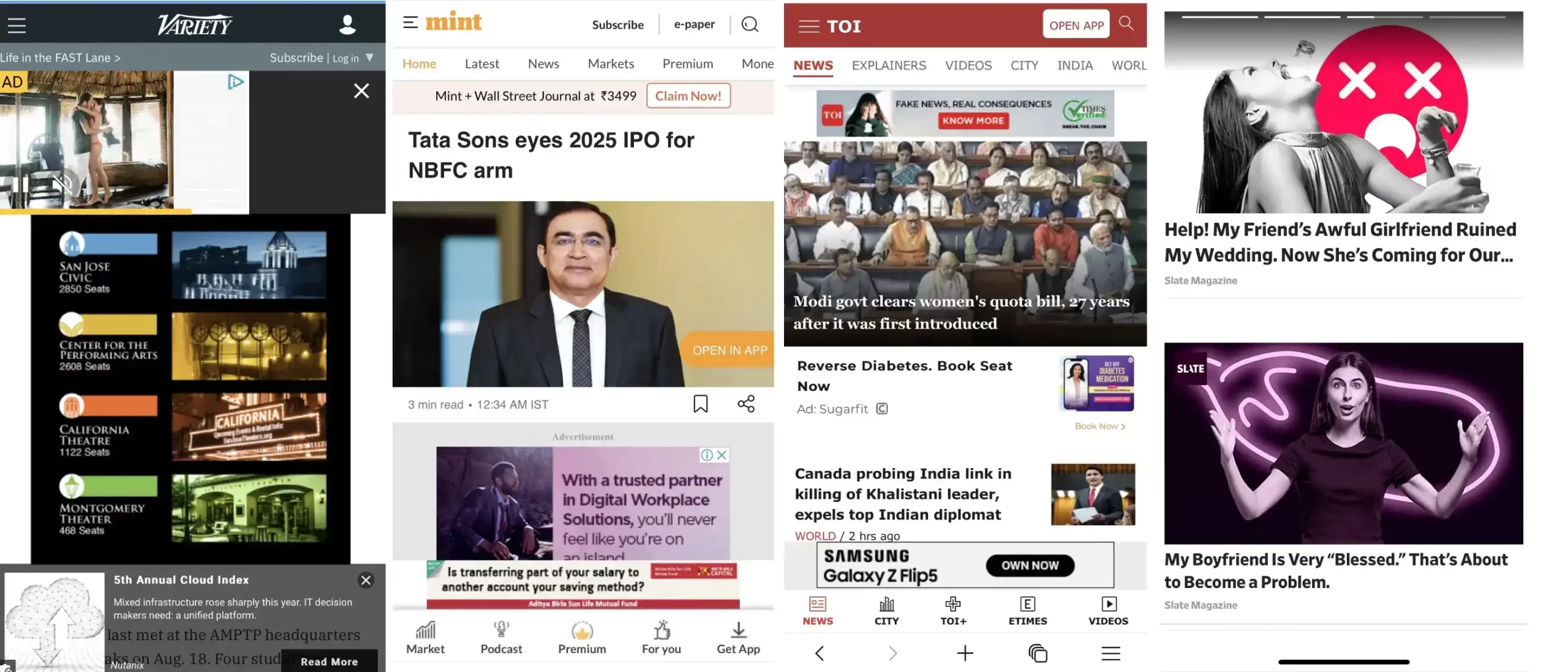
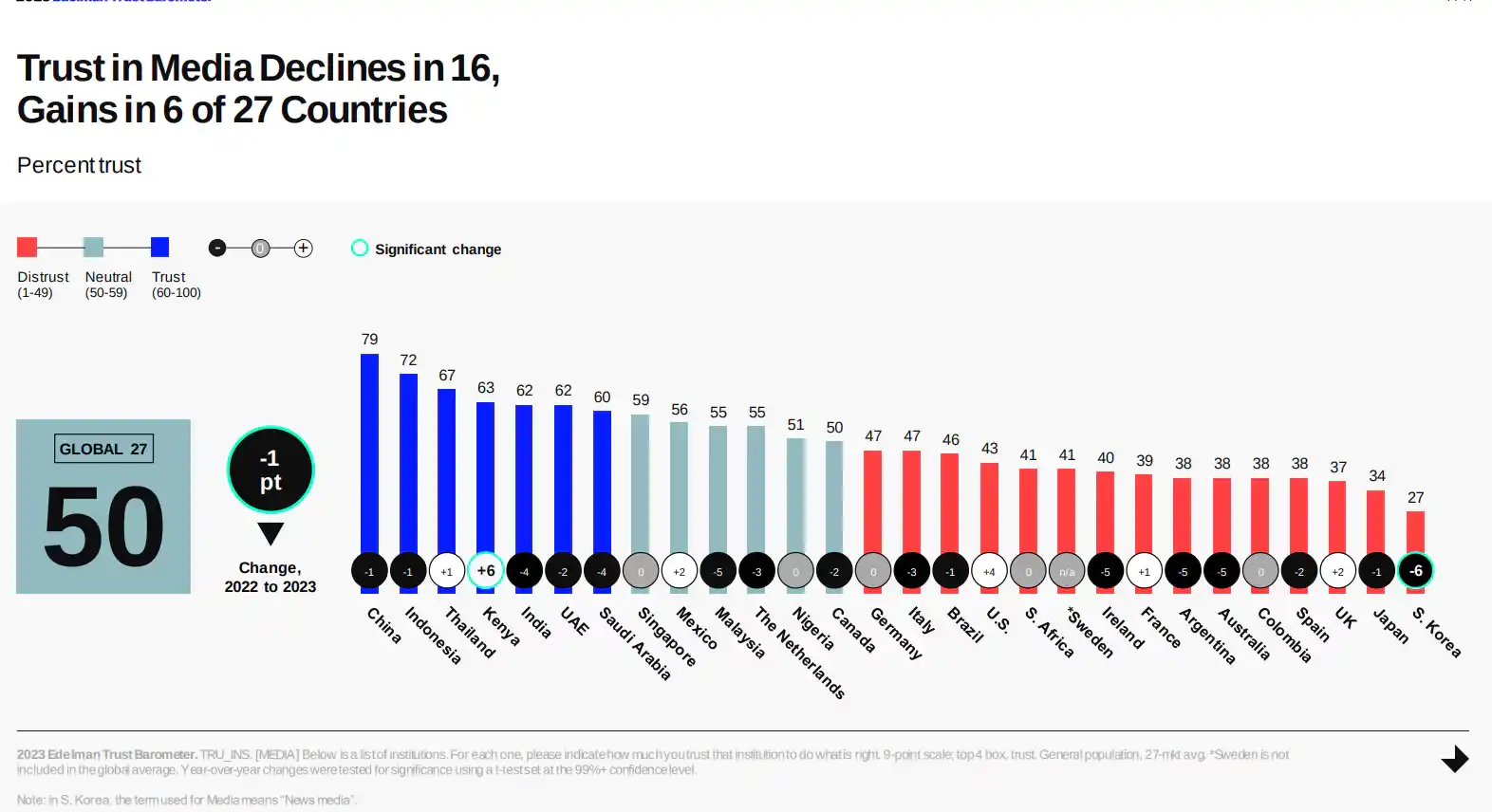
Publications in general cultivate a kind of intimacy. Readers identify with them, see their perspectives reflected in them. That’s why there’s a sense of grief when they disappear. I’ve been thinking about the loyalty we have to one particular publication or another. Social media made us disloyal consumers since we read whatever floated up in our feeds. The general-interest media companies that survived, though, had a lot of built-up loyalty, in both brand and editorial perspective: NYT, New York Magazine, The New Yorker, The Atlantic. They translated that loyalty into paywalls and digital subscriptions. Readers paid because they couldn’t not read the publications. Turns out that’s a good business model. Kyle Chayka, writer and author
Kyle Chayka, writer and author
Building a good news business is like trying to ride a horse blindfolded at midnight while drunk and naked. It’s hard. Publishers are competing against everything from Netflix to Kim Kardashian. It takes something special to even have a chance of survival, let alone success.
> Media continues to compete with every single app on your phone. 2021 will require you to go deeper in building a direct relationship — with not just your users or audiences, but with your true believers. Unless you’re able to capture attention and build a relationship, you can’t monetize, and therefore, you don’t have a business.
We really mean believer, because these people are often buying into a mission they believe in, not just a subscription to a media product.
Rishad Patel, co-founder of Splice Media
“There was this era at the beginning when it was considered smart and prescient to be mobile-first. Then there was the Facebook era where we and a whole lot of other digital publishers were able to really dramatically expand our audience and introduce our brands to the world on the backs of this distribution of social media. That era is clearly over. The way I would describe the new era we’ve entered is one where publishers are going to live or die based on their relationship with readers.”
Zach Seward, co-founder of Quartz | Nieman Lab
Where are we? {#where-are-we.wp-block-heading}
Twilight of social media 1.0?
The phrase “end of an era” is overused, but the current moment does feel like the end of something. Social networks were fun when they started, but now they suck. Facebook had a messy divorce with news, and after the stupid detour into the metaverse, it’s figuring out what its purpose is, like someone having a midlife crisis. Elon Musk asked himself, What’s the best way to blow $44 billion? His answer was to buy Twitter and destroy it in public, like an untalented performance artist. LinkedIn is probably the last weird but sane…ish platform. Instagram and TikTok continue to grow in dominance and are the go-to social platforms for young people.
Social traffic continues to decline, and Google is now once again the largest source of referral traffic to publishers.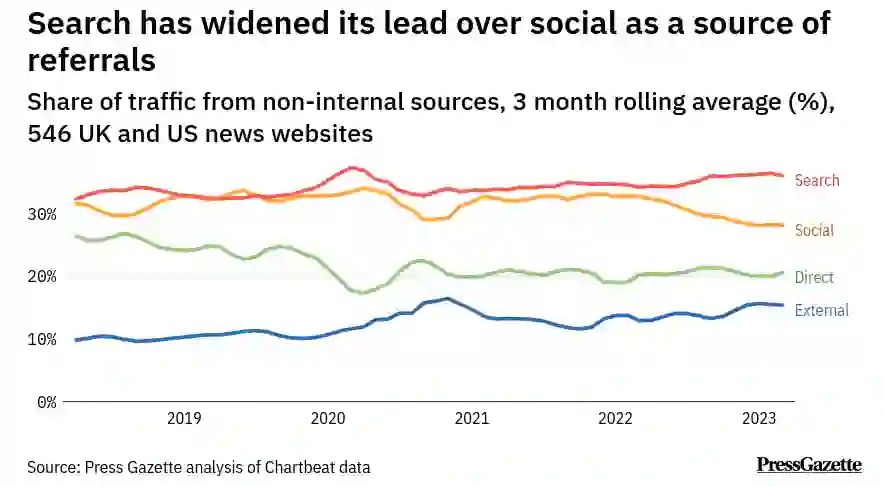
The Reuters Institute for the Study of Journalism publishes an annual study that gives a bird’s-eye view of news consumption around the world. Here are some interesting charts:
The evil social media platforms might be destroying democracy, but more people get their news on social media than anywhere else. “Anywhere else” includes aggregators like Google News, which are becoming a dominant source of traffic.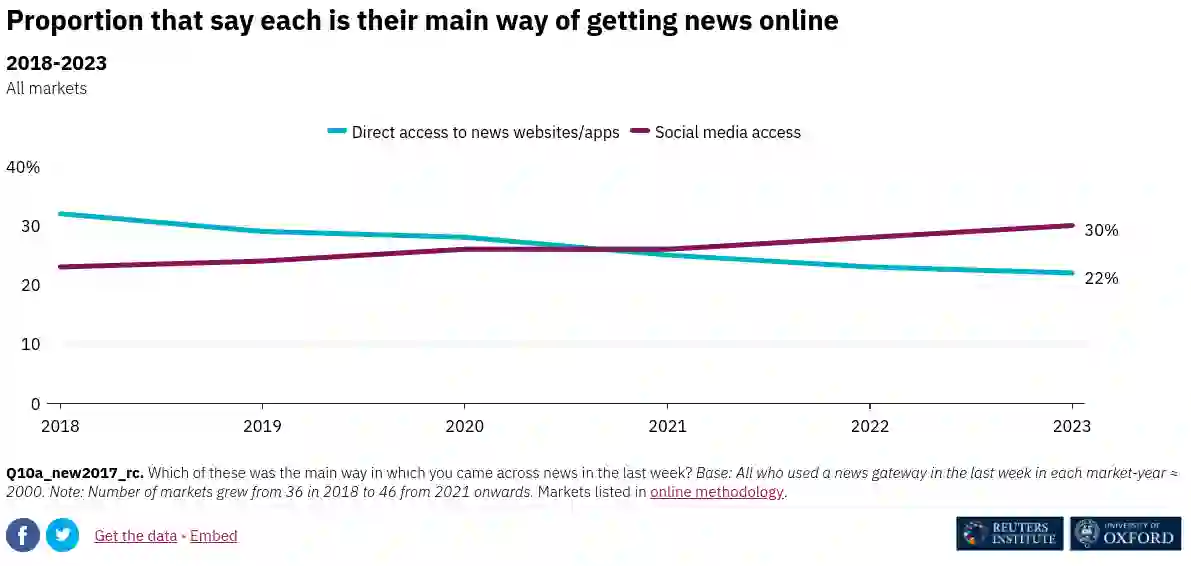
Younger people prefer Instagram and TikTok over Facebook. More people are getting news on YouTube, WhatsApp, TikTok, and Instagram than on other social platforms. The growth of TikTok is stunning, and it’s no wonder publishers are making a beeline to produce short videos.
Monetization on TikTok is still limited. I hope publishers have learned from the infamous pivot to video and don’t go overboard. If not, TikTok will giveth until it taketh. Publishers will learn the same old lessons about not relying on other platforms.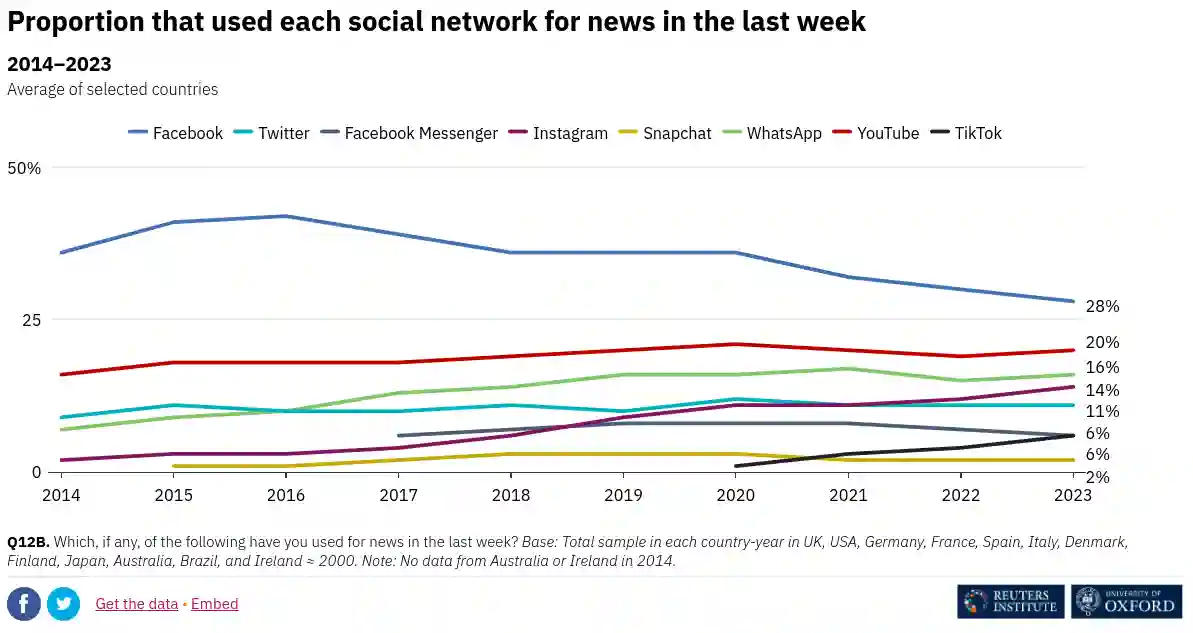
An interesting trend is that people no longer share news on open social platforms. I’d wager that this trend will continue to grow. Social media platforms have become performative hellscapes filled with bots, grifters, and people shilling useless things. Being on social media is no longer fun, and people will continue to move away from open social platforms to private spaces.
> Online participation has shifted to some extent into closed networks such as WhatsApp, Signal, Telegram, and Discord, where people can have private or semi-private conversations with trusted friends in a less toxic atmosphere.
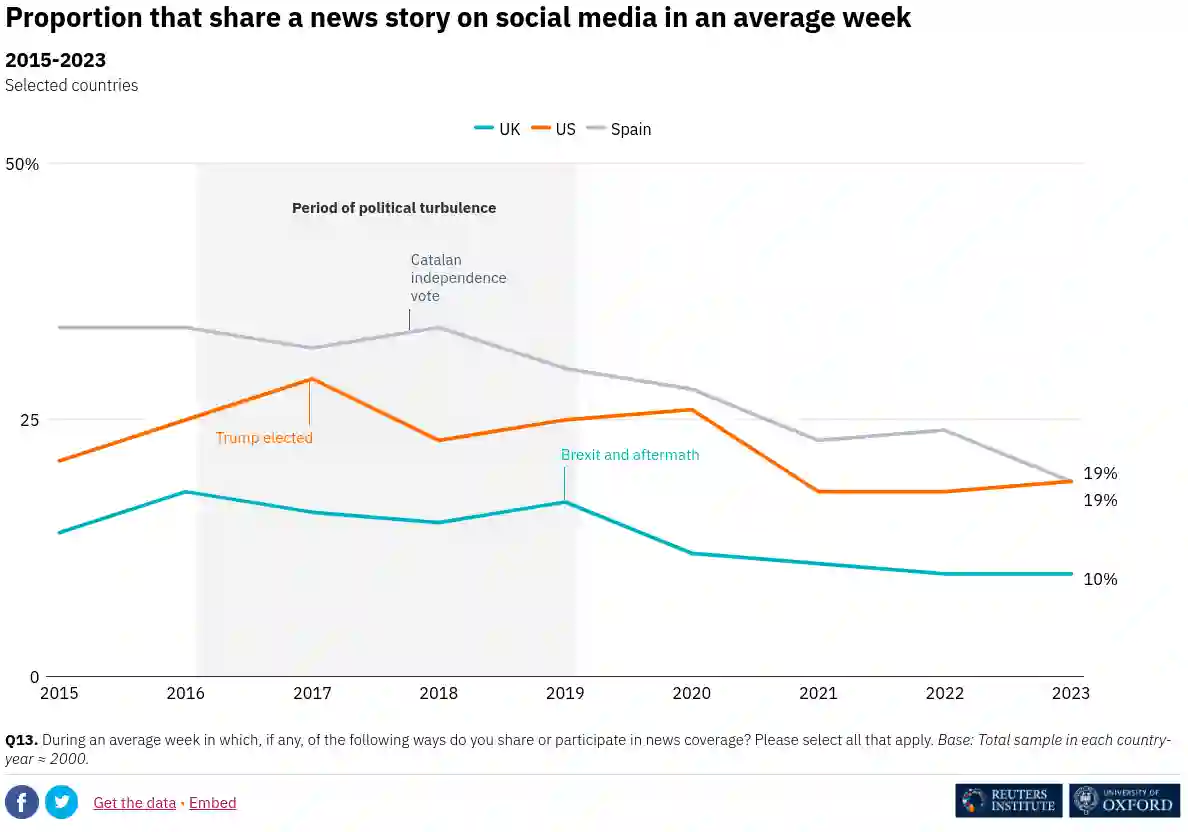Only 17% of users paid for news in 2022, the same as in 2022 across 20 rich countries. The cost of living crisis and the lack of perceived value seem to be the major reasons. I don’t know if it’s too soon to conclude that we’ve hit peak subscriptions, but subscription fatigue is real. People have limited budgets, and there are only so many things worth paying for. There’s also the fact that many people don’t care about the news. Where does that leave us?
The reality is that there’s a hard ceiling on the number of people who can pay. As everything becomes a subscription, people will have to choose between important things. There aren’t enough people who care enough about news to pay. There’s also a power law distribution at play with news subscriptions. Most publications won’t make enough to have a pizza once a week. We’re seeing this with the creator economy. So, things will only continue to get worse for publishers and creators.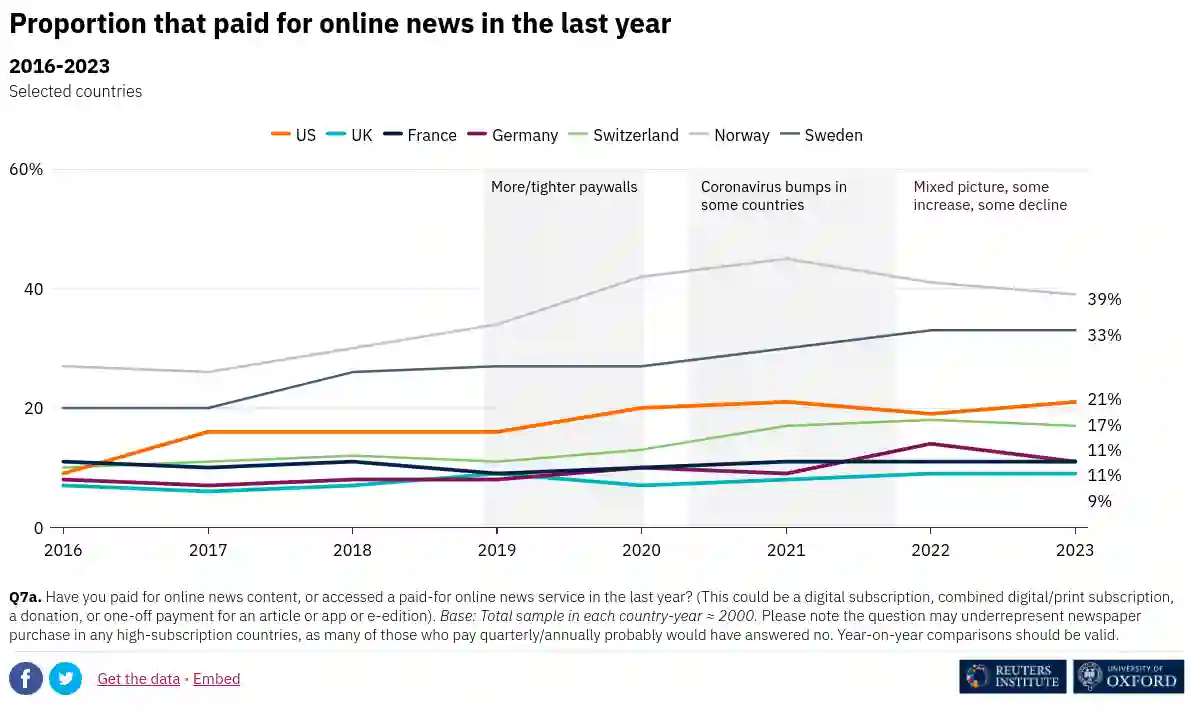
With household budgets under pressure and a significant part of the public satisfied with the news they can access for free, there are signs that the growth in online news payment may be levelling off. Across a basket of 20 richer countries, 17% paid for any online news – the same figure as last year. Norway (39%) has the highest proportion of those paying, with Japan (9%) and the United Kingdom (9%) amongst the lowest. Amongst those cancelling their subscription in the last year, the cost of living or the high price was cited most often as a reason. In the United States, Germany, and the United Kingdom, about half of non-subscribers say that nothing could persuade them to pay for online news, with lack of interest or perceived value remaining fundamental obstacles.
What will get people to pay for news? Cheaper and more flexible pricing and valuable content. Most news publishers ignore younger users because they tend not to have a lot of money, but this is a missed opportunity. Publishers should remember that building a brand takes time. Creating affordable products for younger users can prime them to pay more as they grow older. Even large legacy publishers like The New York Times have realized this.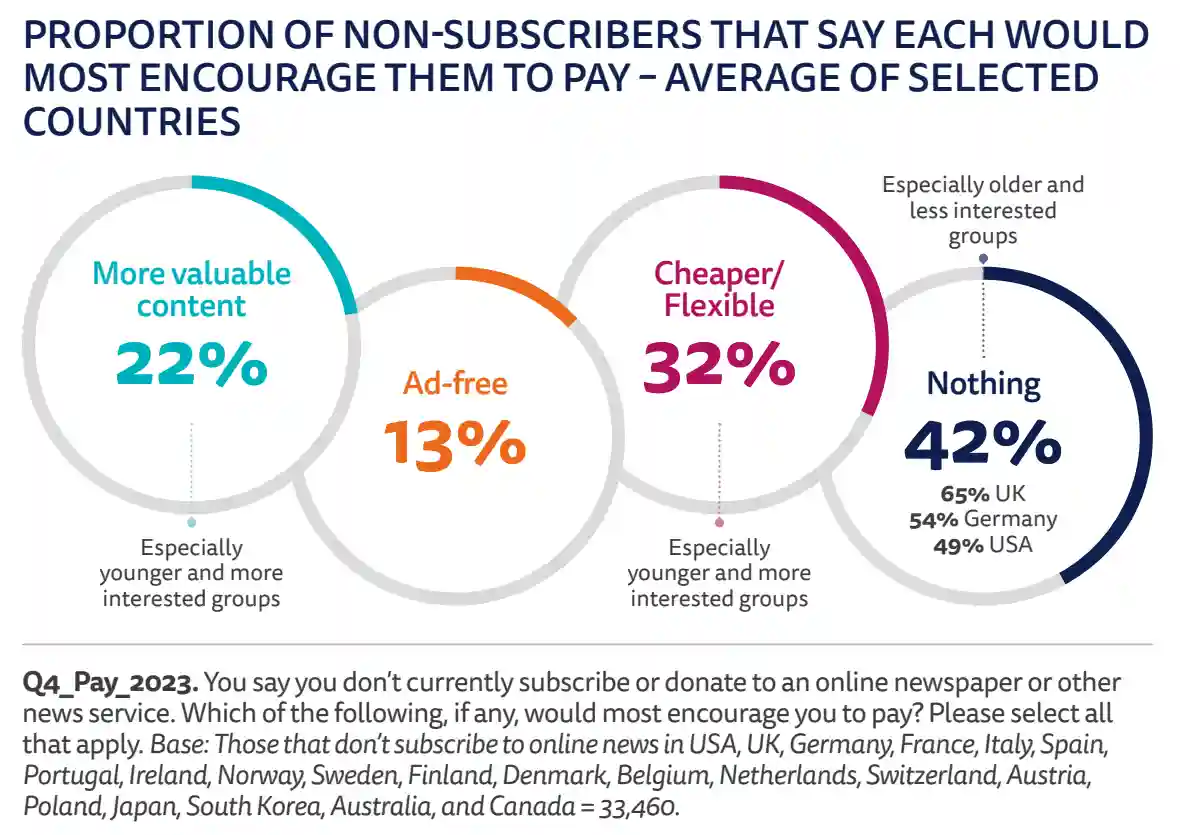
Younger people seem to trust individuals more than brands. The rise of individual creators and influencers has been a megatrend over the last five years. This has massive implications for legacy publishers if they ever hope to capture the attention of youngsters. Today, the vast majority of the audience of legacy publications is much older.
Few users are paying for individuals yet, but 8% is nothing to scoff at. I’d bet that this number will continue growing at a steady clip. The media bundle of the future will be people assembling individual voices and publications on platforms like Substack, podcasts, YouTube, etc.
In the United States 8% of subscribers pay for a newsletter written by an individual journalist or influencer and 5% pay for a podcaster or YouTuber. This trend is still largely confined to the US.
The proportion of people who are not interested in news or are actively avoiding news is increasing, which is cause for concern.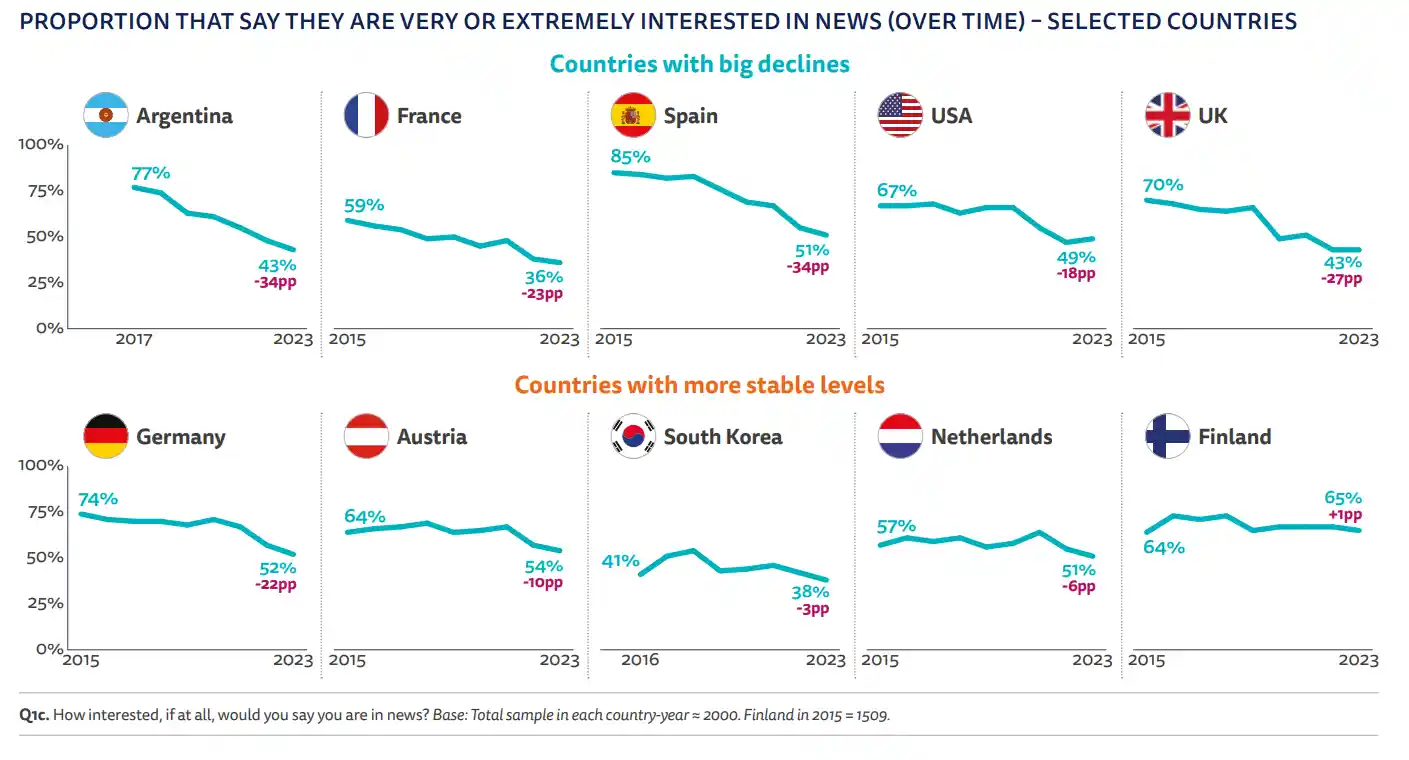
There’s a secular decline in trust in news. Trust is a subjective measure, and factors like the political climate, geopolitical events, and people’s sense of their financial well-being have an impact. I think news organizations will never be able to please everyone. Objectivity feels like a quaint notion to me and leads to bothsidesism. Humans report news, and it’s colored by their views and lived experiences. Unless someone manages to write about something in the most anodyne way, I don’t understand what objectivity is. Publications should aim to be fair, honest, and transparent rather than objective.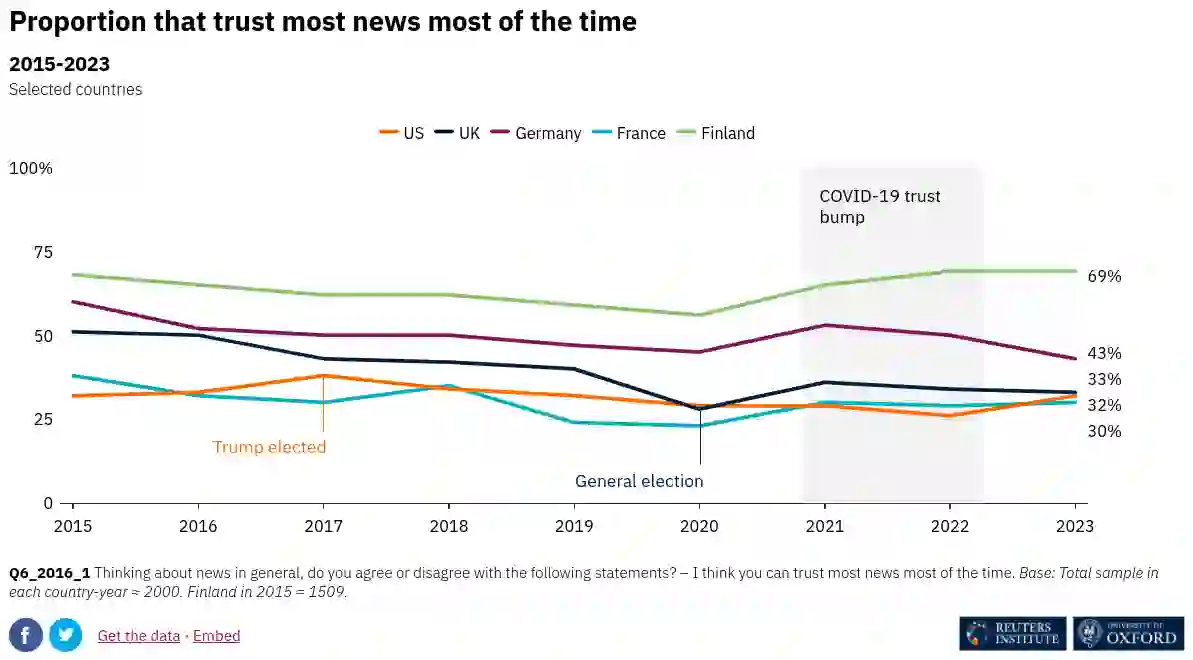
Trust in news is important, but I also think that news organizations shouldn’t concern themselves too much with the issue. If they go down the rabbit hole of trying to please everyone, they will be influenced by the whims and fancies of readers. While respecting the reader is important, it’s also important to understand that they’re not always right. Readers are easily aroused by the passions of the moment are often idiots—me included.
The topic of trust and objectivity reminds me of this interaction between Alan Rusbridger, the former editor-in-chief of The Guardian, and Marty Baron, the former editor of The Washington Post:
Alan Rusbrider: Do you think the Washington Post should be objective?
Marty Baron: I think we should be, I don't like, that's not the word that I would use. What word do you use? We should be independent, we should be fair, we should be honest, we should be honorable, and then we should do our work, do our research, and whatever we find, if we've done it all properly we should tell people what we've found, in a straightforward, direct, unvarnished, unflinching manner, and that that's what we ought to do. And whatever the facts tell us, the story is, I mean, the obligation is for us to do the work properly and thoroughly, and then to tell people what we found and not hesitate to do that.
What Mr. Baron says is what news organizations should aspire to be.
State of local news
Print newspapers are still stuck in an uncertain transition from print to digital, even after two decades of the internet. Except for the large publications like NYT and WaPo, none of the regional and local papers have been able to convince readers to pay. It’s a case of death by a thousand cuts.
Private equity, hedge funds, and other investment vehicles own over 50% of all local and regional newspapers.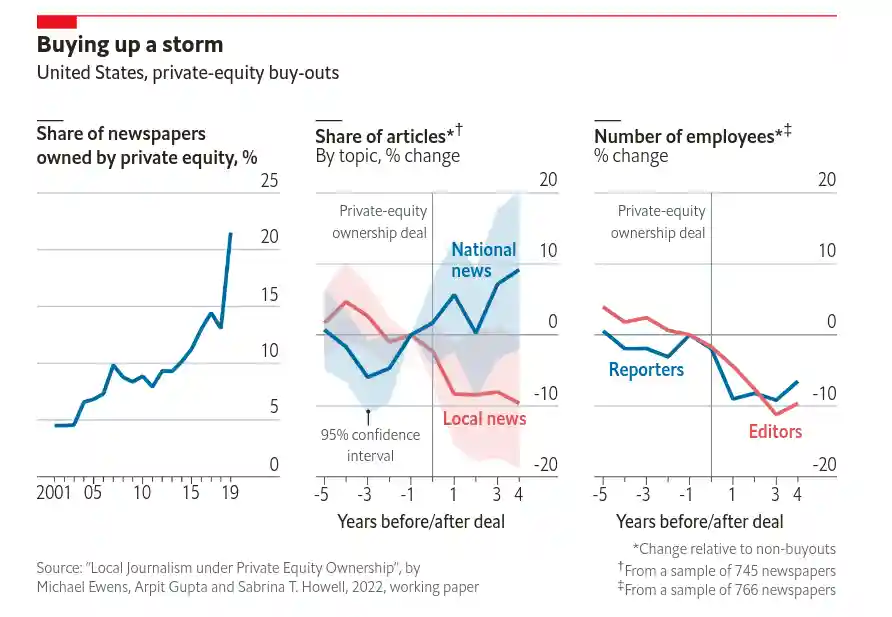
These financial groups buy newspapers, cut staff to the bone, and try to wring out as much cash as possible. The death of local newspapers had a devastating impact on the civic life of American towns and cities.
What threatens local newspapers now is not just digital disruption or abstract market forces. They’re being targeted by investors who have figured out how to get rich by strip-mining local-news outfits. The model is simple: Gut the staff, sell the real estate, jack up subscription prices, and wring as much cash as possible out of the enterprise until eventually enough readers cancel their subscriptions that the paper folds, or is reduced to a desiccated husk of its former self. — McKay Coppins/The Atlantic
Extortion rackets {#extortion-rackets.wp-block-heading}
The greatest trick the newspaper industry pulled was to convince the world that Google, Facebook, and the internet caused their demise. As I showed above, they didn’t, but facts are inconvenient opinions. But as newspapers began their terminal decline after the internet, they managed to seed the idea that the internet and tech companies were the cause of their woes—it wasn’t their corporatized shortsightedness, rent-seeking, or inability to innovate. It’s one of the greatest PR moves in history.
The illusory truth effect is the tendency to believe false information to be true after repeated exposure. The Big Lie works through indoctrination. If a lie is repeated enough, people believe it. The repetition becomes the support for the lie. — Wikipedia
By sheer repetition, it has become a truism that Google, Facebook, and other internet companies killed newspapers. They evoke sympathy like an injured puppy, while big tech companies like Google and Facebook are treated as vultures. It’s a remarkable example of revisionist history.
They have managed to obscure their historical anticompetitive behavior since 1920. According to the newspapers, the solution is that Google and Facebook must pay them.
Why?
Because Google shows links to news websites with a text preview and sends them tons of traffic. Facebook allows the sharing of news links by willing people exercising their own agency and sending them traffic, so it should pay.
Huh?
There’s a long history of this link tax.
-
In 2014, Spain implemented a “link tax,” and Google News shut down, causing a drop in traffic to Spanish news websites.
-
Germany implemented a similar law, and Google responded by removing snippets requiring publishers to opt in by waiving payments. Traffic to German publishers fell, forcing them to backtrack.
-
In 2019, France passed a similar regulation forcing Google to pay for news snippets in search results. Google refused to pay and removed the snippets, just showing links instead. After back and forth, Google agreed to pay 121 French publishers $76 million but was instead hit with a $500 million fine by the French competition commission.
The most successful implementation of a link tax was in Australia. The fortunes of the Australian news industry have been a mirror image of their American counterparts.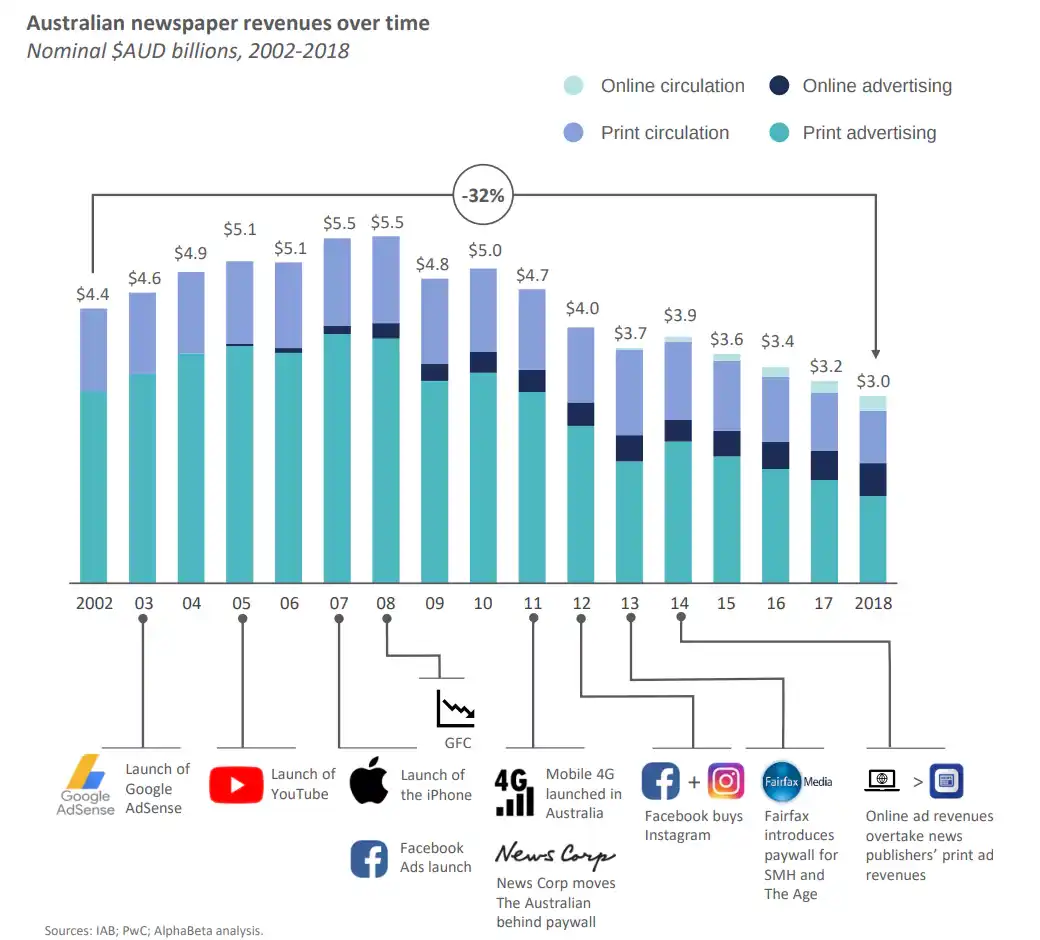
In 2021, Australia passed the News Media Bargaining Code, forcing Google and Facebook to negotiate with Australian publishers. Google threatened to pull out, and Facebook (Meta) banned the sharing of Australian news articles for a brief moment, but both tech giants cut secret deals with publishers with revenues of more than $150,0000. This bill is estimated to have generated A$200 million a year for news organizations. The results seem mixed, with most of the money going to large newspapers owned by the likes of Rupert Murdoch, with many smaller publishers cut out of the bargaining process.
This year, Canada passed a similar bill modeled on the Australian law. Facebook blocked the sharing of Canadian news links in response, while Google has threatened to do the same. Last year, a bipartisan group of legislators in the United States introduced a similar bill, but it’s yet to pass. Countries around the world have either passed or are considering similar legislation.
These regulations boggle my mind.
Here’s the reality: news has very little value for Facebook. In fact, considering the amount of grief that news causes Facebook, it’s better off without it on the platform, and the data bears this out. Facebook’s usage has remained unaffected despite the news being blocked. You could argue that Google needs news to show better results, but that still doesn’t change the fact that publishers get far more value from Google’s traffic than Google gets from news content. I hate to say the platforms are in the right, but it’s a fact.
There is no evidence that shows news outlets are worse off because of Google, Facebook and other aggregators. If anything, evidence (and lots of it) shows that, overall, news outlets would be in worse shape without these digital platforms. That’s what I found in a study I undertook with economist Joan Calzada of the “link tax” imposed by Spain (before the EU-wide directive was instituted in 2019).
These are terrible laws. Why should only Google and Facebook pay? Why not TikTok, where most young users get their news? Why not email, Apple News, Telegram, Reddit, Discord, Flipboard, Twitter, and other platforms that are sizable sources of referral traffic? Hell, why not anybody on the internet?
A functioning democracy needs a strong press. Given the dire straits of newspapers, I believe in any and every solution, even the most extreme. Despite that, I can’t bring myself to agree with these extortion rackets.
> Commercial news organisations no longer offer value to advertisers. Instead of searching for ways to make an obsolete business solvent, efforts should focus on alternative ways to fund public-interest journalism.
Amanda Lotz
Google and Facebook won’t save journalism. It’s not like Google and Facebook’s continued success is guaranteed. Remember Yahoo, Myspace, Orkut, and countless other search and social platforms? In a world where Google and Facebook are no longer dominant—it’s not an outlandish notion in the age of AI—who will newspapers extort? The bigger question is: for how long will these companies continue paying? The skeptic in me says not for long.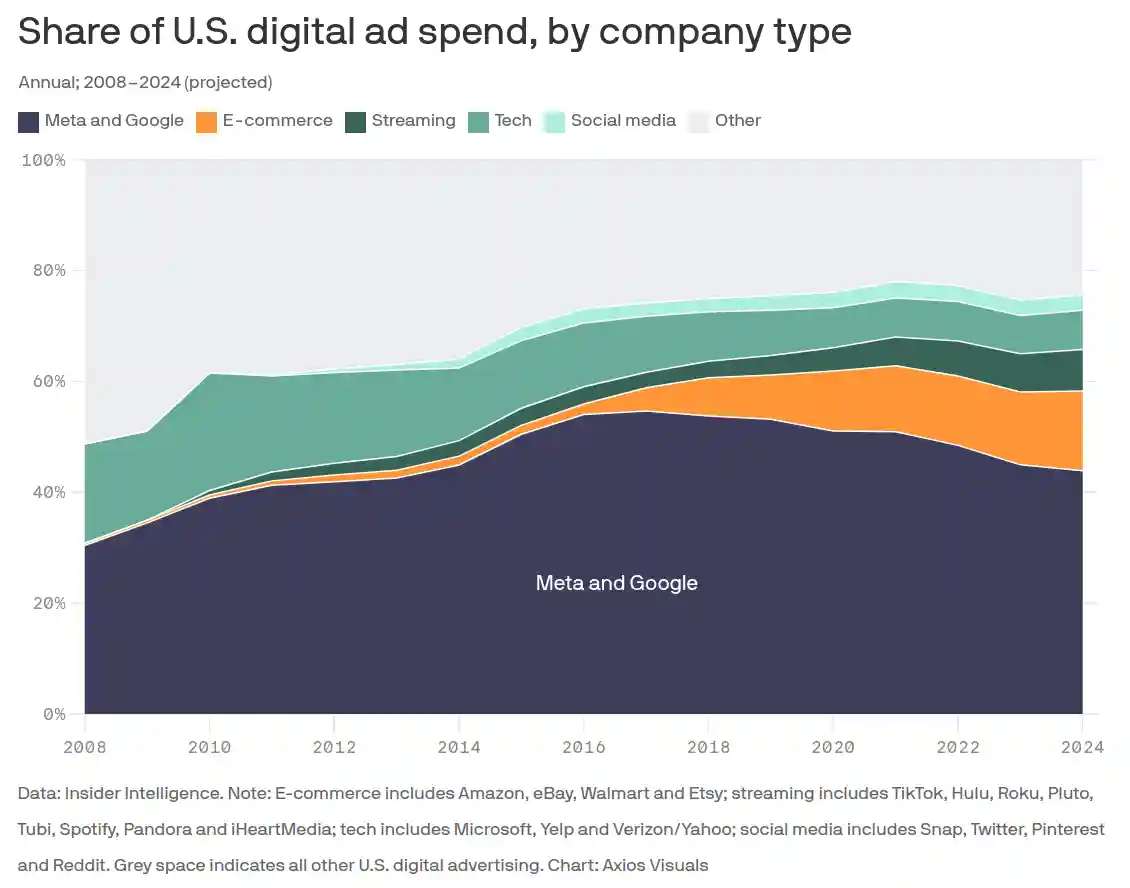
Snap back to reality {#welcome-to-reality.wp-block-heading}
The era of social 1.0 is over.
The era of scale delusion is over.
There’s no more cheap money mad enough to chase digital media.
Publishers addicted to the high of social traffic are past the acceptance stage and are showing withdrawal symptoms. They’ll kick the addiction.
Welcome to the age of shrunken ambitions.
This might sound insensitive, but here’s how I think about digital media in 2023. All the cuts and layoffs have shrunk digital media to its equilibrium—a barbell with few large publishers and lots of niche publishers. The end of the 2010s has shown what publishers should have realized at the beginning of the decade—the future of news is small. Having said that, just because these publishers have shrunk doesn’t mean they are in a good spot. Most of them have cut some of their best and brightest reporters and are a shadow of their former selves. Without good writers and reporters, I don’t know how they’ll be able to build a sustainable business.
The digital media company of the future will be small, focused, and audience-first. Publishers have learned the hard way that building companies that rely only on advertising is impossible. Small doesn’t mean smaller ambitions—not all media brands want to remain small. There’s a sensible middle ground between chasing scale and thoughtful expansion into other niches. The way the likes of The Information, Skift, The New York Times, and The Ken have grown are good examples. A series of niches add up to a decent-sized business.
This is poetry by Rafat Ali, founder of Skift:
> It should be harder than just coming up with some bullshit idea to start a millennial media outlet, whatever that means. It shouldn’t be easy to get two full floors in World Trade Center building as your office, when you’re running on borrowed money and time. It should be hard to call yourself the Condé Nast of the next generation, harder to even build one. It should be harder than starting with clickbait and then pivoting to quality, and then raise up hands when that is hard to do. It should be hard to replicate your success in one vertical to others.
Let a thousand niches bloom.
The media company of the future will have diversified revenue streams such as subscriptions, ads, events, and commerce. The 2010s also showed that building scale-oriented general interest publications is a fool’s errand. It’s not easy to compete against the likes of The New York Times, The Guardian, BBC, Nikkei, Australian, Le Monde, etc. The Reuters Digital News Report found that people across most countries pay for one national publication:
> As in previous years, we find that a large proportion of digital subscriptions go to just a few upmarket national brands – reinforcing the winner takes most dynamics that are often associated with digital media. But in a number of countries, including the United States, we are now seeing the majority of those paying taking out more than one subscription. This reflects the increased supply of discounted offers as well as the introduction of all-access bundles in some markets.
It’s a little ironic that people in media—a terradome—of all places need a reminder that building a good media business is hard. The era of free money is over, and zombie businesses that relied on raising the next round will wither and die—Vice Media is a harbinger of death. Publishers like Vox that are hobbling will continue to face challenges, but none that are insurmountable. Some publishers will overcorrect. They will make false choices between subscriptions, advertising, niches, and scale. The brands that survive this winter will be in a better place heading into this new era of publishing.
Then there’s the question of artificial intelligence (AI)—the 8,000-pound gorilla in the room. I’m not prone to florid ejaculations about futuristic nonsense. I don’t know how, when, or if AI will reshape and upend the world as we know it. But operating under the default assumption that AI will cause chaos is wise. For example, Google expanded the availability of Search Generative Experience (SGE). Unlike the traditional search results with links, you will see summaries of the search results and more prompts to explore. SGE is still in beta, and if it becomes the default search experience, links will become far less important than they were.
What does that mean for media brands if people adopt AI chat interfaces where they ask questions instead of browsing search results? How will generative audio and video shape digital publishing? Predictions are a fool’s errand, but it’s safe to say that an age of disruption is upon us. Having said that, there’s also a risk of overcorrecting in response to AI. Richard Tofel, the former president of ProPublica, captured the tradeoffs succinctly:
Having said that a revolution is soon upon us, that doesn’t mean that everything is changing everywhere all at once. One of the things I most noticed in looking back at the Nineties was that the technologists, and especially those with the arrogance to label themselves “futurists,” were often directionally right about change, but frequently far off in predicting its pace. Indeed, as I wrote,
it was often so long before they were right that they proved poor guides to people in business who needed to make decisions today… [T]o know where your industry is going is never enough in business. You also need to know when it is going to get there.
This dynamic may also apply in our own moment. In the last revolution, Xerox PARC, the early Apple (up through Newton), Knight Ridder’s Viewtron and Boulder Design Lab, Prodigy and AltaVista—brilliant innovators all– proved to be ahead of their time. That may yet repeat itself with AI. The imperative, again, is therefore to become familiar with new tools, to bolster capabilities and to imagine a different future, rather than to bet the farm on someone’s particular speculative prediction.
I also think that AI is a golden opportunity for news publishers to build trust. It’s safe to assume that AI will make the problem of misinformation and disinformation worse. People instinctively turn to trusted sources of information when in doubt. It’s the same reason why legacy publishers are the preferred subscription for national and international news despite the mistrust in the news. The age of AI is an opportunity for news publishers to earn the trust of readers.
Where’s the silver lining? {#silver-lining.wp-block-heading}
In 2023, the legacy news media companies must accept that the “golden age” of news is over. No matter how many goats they sacrifice to the heathen gods, the monopolies and the grotesque margins of the old are not coming back. Digital publishers must accept that bundling eyeballs while relying on the charity of platforms and aggregators is a recipe for disaster.
> In the newspaper industry and television industry 20 years ago success was a a return of 20 or 30% today success might be a return of 8 or 10 percent which is still better than most businesses but for those people that are used to very successful media businesses is not quite the same so what they're having to do today is work harder get money from more places than they did before and this is uncomfortable for many people in media particularly in the news parts of medium.
Legacy and digital publishers today face the same brutal realities that newspapers have always faced throughout history. The silver lining is that news publishers, despite their troubles, aren’t extinct. More publishers—new and old—are experimenting and innovating with new forms, formats, and revenue models.
There’s a massive gap in funding due to the loss of advertising. Philanthropies, foundations, and billionaires have stepped into the breach and pledged hundreds of millions to support local news organizations, but it’s still a drop in the bucket.
It’s also true that readers have never had access to so much quality news and journalism for free at any point in history. That applies to national and international news, but the internet hasn’t provided an alternative to local news. The struggles of local outlets are a common theme across the developed world. Large communities, minorities, the marginalized, and the afflicted have no voice, and that’s a serious issue. Rising media concentration in both developed and developing countries is another serious concern. This has serious implications for media plurality.
Given the woes of news publishers, media scholars like Victor Pickard have been arguing that news is a “public good,” like schools and roads. Victor Pickard, in particular, has been arguing that, left to its whims, a free market system can never provide the news required for a well-functioning democracy. He calls it a “market failure”:
But this coming year, as advertising-dependent journalism continues its slow death, as vulture capitalists continue to pick over the bones, as news rooms continue to hollow-out, we will come to see systemic market failure for what it is. We will acknowledge that no entrepreneurial solution lies just around the bend. We will give up the ghost of discovering a magical technological fix or a market panacea. Instead, we will begin to look more aggressively for non-market-based alternatives.
Any mention of state funding immediately leads to red visions of communism and state-controlled media, especially in a country like America, which celebrates the virtues of free markets and is allergic to big government.
> Another favorite argument Pickard takes on suggests that the problem would be solved if only newsrooms had adapted faster or were more open to innovations that would monetize their content. This idea, Pickard contends, misses the fact that the crisis is systemic: a new business model isn’t out there waiting to be discovered, because it’s all of capitalism that’s the problem. Those who take this technocratic line—as if all news organizations need is a visit from McKinsey consultants—see journalism as just another product and portray its collapse as beyond our control. The effect is to ignore the market fundamentalism that caused the problem in the first place. Pickard contends instead that the problem with the business model for news in this country is that we haven’t fully embraced the fact that news is a public good, and thus, like other public goods—schools, for instance—cannot be adequately provided by the market.
Yet, from its earliest days, the American government has played a major role in the development of the press. It has had postal subsidies since 1792, support for public broadcasts and radio, free licenses, and tax breaks. Many European countries have long had public broadcasters, yet they have thriving democracies and press. In fact, European countries have the highest support for public media on a per capita basis in the world.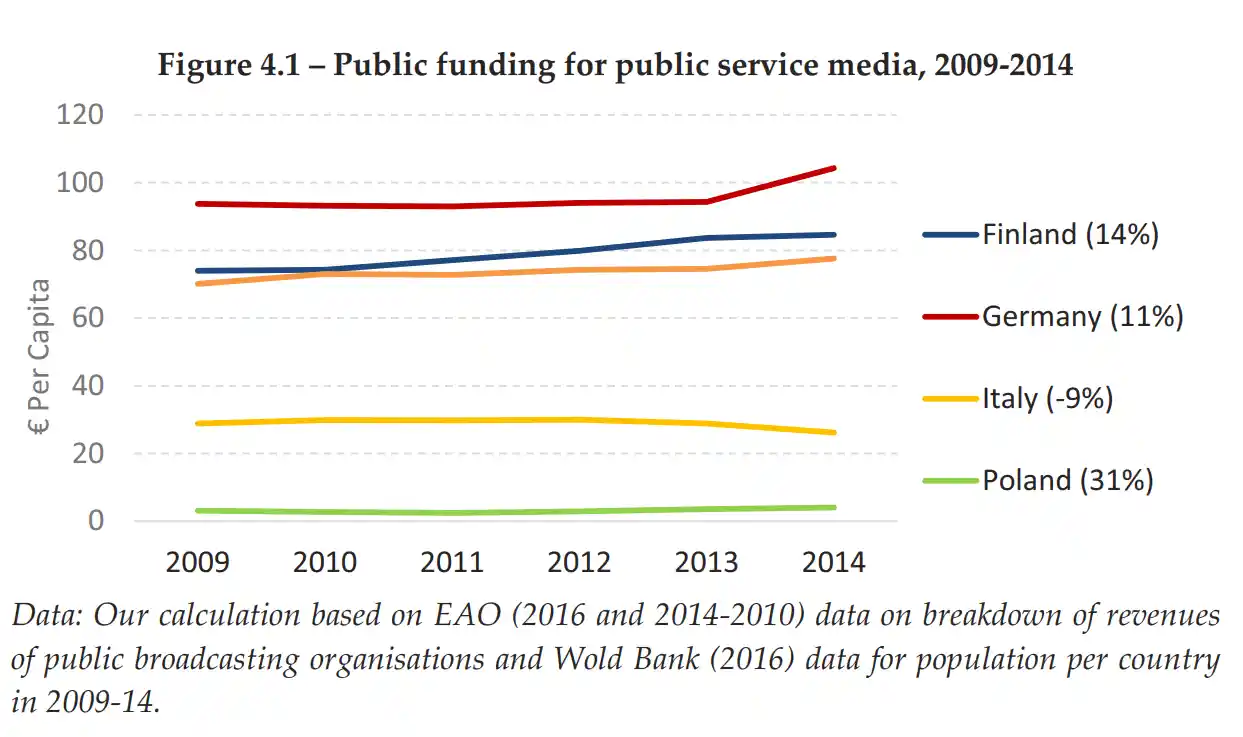

Even emerging economies like India and Brazil have public broadcasters with varying degrees of success. But that doesn’t mean public funding of news is without its challenges, chief among them being how to distribute money. This is one reason why governments around the world have resorted to a link tax on big tech companies. Taxing tech companies is easier and helps politicians avoid distributional issues and recriminations.
While authoritarian assault on institutions is always a worry, public funding is also a design problem. As long as public broadcasters, publishers, and funding organizations do a good job of cultivating trust and demonstrating their value in people’s lives, they have good odds of surviving the wrath of those in power. There are many success stories in Europe, with the BBC being the most popular.
Advocates of public funding have proposed various mechanisms, such as:
-
Tax credits for news subscriptions
-
State or locally-funded news vouchers that can be exchanged for news subscriptions
-
Community-owned and operated news cooperative
-
Direct funding of public news
But there’s little to no appetite for this in America and other emerging markets. That leaves smaller for-profit and nonprofit news organizations with limited options.
Philanthropic funding
While more wealthy individuals, foundations, and nonprofits are funding journalism than ever, it’s still not enough. There are also issues of editorial independence with such funding mechanisms, as was the case with the ad-funded model.
Billions
More billionaires like Jeff Bezos (The Washington Post), Marc Benioff (Time), Laurene Powell Jobs (The Atlantic), John Henry _(The Boston Globe), a_nd Chatchaval Jiaravanon (Fortune) own news outlets than ever. The issue is the interest of billionaires in media is cyclical. They think they can use the business acumen from other industries to save media companies but get punched in the face by the brutal economics of the media business. History is littered with examples of quick flings and messy breakups of media companies by billionaires, from The New Republic to the Gothamist. We may soon have to add names to that list, given that The Washington Post is set to lose about $100 million in 2023. Is there a limit to Jeff Bezos’s patience? The same is the case with The Los Angeles Times, owned by billionaire Patrick Soon-Shiong.
Handouts from big tech
While publishers rail against Facebook and Google, the irony is that they are among the largest funders of news. Google and Facebook have committed well over a billion dollars to support news organizations across the world. In the absence of support from the government, they’ve become key supporters of news organizations. You and I can argue their intent: whether they are doing this from the goodness of their hearts, if it’s PR, lobbying, or moves to head of government interventions.
> Google and Facebook have been very effective in achieving two goals in the United States. One of these goals is that they have been the most generous and consistent funders of local newsrooms over the past five years.
Should we leave it to the platforms, etc.? I have always been an advocate of formalizing these arrangements under legislation, but I also recognize that I am talking about America here, and that there are other parts of the world where, without the support of non-governmental actors, journalism would be in a much more dire position. So, I guess what I would wish from the platforms is better regulation in countries where the regulation will actually help independent press. In countries where it won't help independent press, if the platforms are really earnest in their endeavors, they now need to align their practices on the ground. — Emily Bell
What percentage of the committed amount is spent is unknown. Funding arrangements between Google, Facebook, and news organizations are shrouded in secrecy. The effectiveness of these grants is also up for debate, and the available evidence shows that the results are mixed at best. But the problem with relying on handouts from big tech companies is that they are capricious. This year, Facebook ended news payments in several European countries.
There’s no perfect business model; there are less terrible and more horrible models. A big challenge for publishers is that most people don’t care about news. This graphic is from the Reuters 2021 Digital News Report. When asked how concerned people are with the financial state of news organizations, most people were either oblivious, ill-informed, or didn’t seem to care.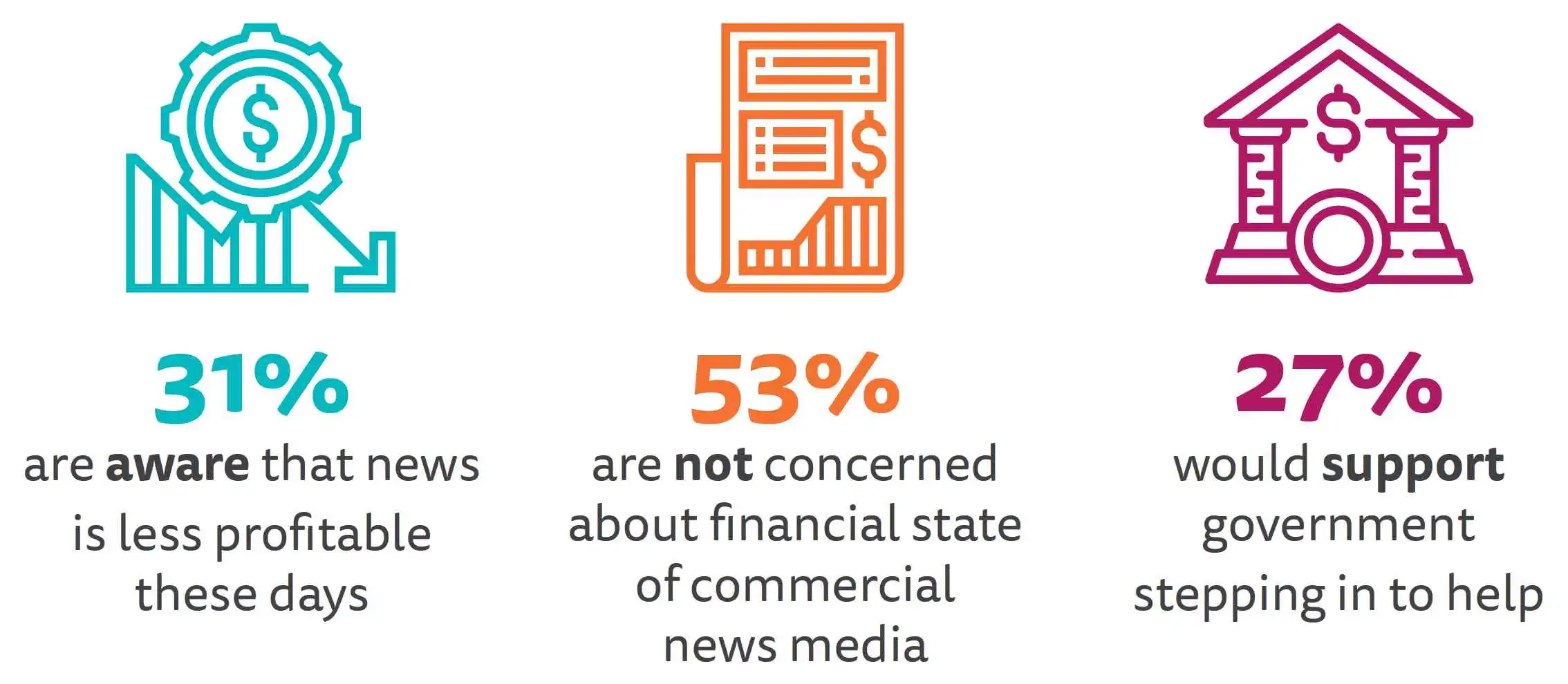
If the apathy toward news wasn’t scary enough, more people are avoiding news than ever. Political polarization seems to be the culprit, but I suspect the issue is more complex. Regardless of the reason, this isn’t good for publishers. This is also a self-inflicted wound. The moment news became entertainment, trust in news became collateral damage.
So where does that leave us?
A lot of imperfect solutions are much better than an ideal solution that will never be a reality. People like me crying over the sordid state of news publishers must make peace with this fact and try to fix one small thing at a time. History has never been kind to revolutionaries. If there’s a revolution that changes attitudes toward news among policymakers and consumers, that’s a bonus, but this scenario is a pipe dream at best.
Peeping into the future {#future.wp-block-heading}
Let me be clear: I have no idea what the future holds, but you can make reasonable guesses.
The end of mass delusion
For a brief moment in the 2010s, there was the belief that if you built enough scale, you could aggregate that attention and sell it to advertisers. This idea underpinned BuzzFeed, Vice, and pretty much all the digital native upstarts. That’s over. The problem was that these digital publishers never owned the audience but were rather renting them. They were at the mercy of the platforms and had to dance like monkeys to their tunes.
“Every publisher with that model is facing a potential problem, especially if their journalistic focus is too random that they can’t secure direct advertising deals. It’s not that advertising is failing as such. It’s the model of what we call ‘low-intent micro-moment’ traffic from social platforms monetised by random ads,” says Baekdal, who defines low-intent moments as when readers consume ‘snackable’ or entertainment content they’re unlikely to pay for. — Thomas Baekdal, media analyst.
Building an advertising-funded, scale-oriented publishing operation without social traffic is almost impossible.
Actually, I think you do see certain general journalism outlets being more sustainable now through reader revenues, and I think that that’s definitely a model for some of them. We don’t know much about payment mechanisms yet, how they will develop, and what people will pay for. So I don’t think that there is a viable advertising-supported model for free journalism — there just isn’t. It’s not going to happen. — Emily Bell
The news publisher of the future will be small and focused. Here are a few examples:
-
James Harding, a former editor of The Times, founded the UK-based slow news startup Tortoise. Instead of breaking news, Tortoise focuses on slow and deep reporting on important issues. It started with long-form articles and then pivoted to audio. The audio operation is profitable but the overall business is yet to break even.
-
Puck is a subscription-based newsletter that covers media, Hollywood, and Silicon Valley. Unlike regular business models, it puts the writers at the center, like Substack, but with the institutional resources of a legacy media company like the NYT. Puck writers aren’t just salaried; they earn incentives based on subscribers and also get equity in the company.
-
Zetland is another slow-news startup based in Denmark. As it was running out of money, it appealed to its readers to become members and is now profitable.
-
Rafat Ali founded the travel-focused publication Skift. It tried to raise VC money but was unable to match their voracious appetite for scale. It decided to stay small, focus, and expand by going deep instead of wide. It’s profitable and doing well today.
-
Mediapart is a French subscription-oriented publication that only does deep investigations. It has been profitable since 2011, with over 200,000 paying subscribers.
“Unless you’re the New York Times, you are not going to succeed if you don’t have a clearly defined understanding of who your audience is. Niche media is picking a lane and knowing exactly who is the consumer of that content.”
Jacob Donnelly, publisher of Morning Brew
Direct relationships
The story of the 2010s is all about the whirlwind romance and messy breakup between news publishers and social media platforms. Since the birth of the internet, there have been countless examples of the perils of relying on gatekeepers. If publishers knew history and had some common sense, they would have realized that relying on other platforms for all their traffic is a bad idea.
But they didn’t. From 2010 to 2016, they were high on social traffic—it was one helluva drug. Once social media platforms became raging dumpster fires after Trump, and they changed their minds about the value of news on their platforms, publishers were caught off guard. The visitors from social referrals were just that—visitors. They visited and then left. None of the digital-first publishers bothered to build direct relationships with their visitors. By the time they realized that, like Quartz, it was already too late,
The digital media company of the future can only survive if it can convince readers that it matters. Publishers can only survive if they become part of readers’ daily routines. Building businesses with high dependence on external referral traffic sources is a recipe for disaster. As if the example of the last decade weren’t enough, Twitter (X) seems to be throttling traffic to outbound links. This is after it stopped Substack from embedding tweets and showing Substack links in Twitter search results. LinkedIn is following a similar strategy of reducing engagement for posts with links. TikTok seems to be the darling of the moment among publishers, but it’s bound to disappoint—they always will. Building businesses around distributed models is like jumping from one burning building to another; you’ll be burned at some point.
Referral traffic matters, but the priority has to be to own the distribution through newsletters, communities, chat apps, applications, events, etc.
What is clear, though, is that the only way to build a thriving business in a space dominated by an Aggregator is to go around them, not to work with them. In the case of publishers, that means subscriptions, or finding ways to monetize, like the Ringer, beyond text. For web properties it means building destination sites that are not completely reliant on Google. For manufacturers it means building relationships with retailers other than Amazon and building brands that compel customers to go elsewhere. And for digital content providers…well, this is why I view Apple’s policies as the most egregious of all.
> I’ve lived through Yahoo going away; I’ve lived through Facebook going away; I’ve lived through a very strange moment of Snapchat going away. I feel like we would be making a mistake if we didn’t envision what it would look like if Google went away. I don’t think it’s going away tomorrow, but I do worry that every media executive that I’ve ever spoken to is deeply aware of how much Google drives the top of the funnel, how much the entire architecture of the internet is organized around Google’s wants and needs, and how little self-awareness there is about this being critical dependency instead of a benign relationship.
Nilay Patel, editor-in-chief of the Verge
> In hindsight, the twenty-tens saw the emergence, growth, dominance, and incipient decay of the largest social networks. All of us users have had the opportunity to learn the same lessons that Peretti did: we can’t rely on large digital platforms that are motivated by profit above all, and there is no guarantee they will protect or support us or work to deliver the best experiences possible. Instead, they will continue to encourage us to churn out content for free; they will work ruthlessly to capture our attention and then commodify it through every possible avenue. Those huge, public networks are growing riskier, messier, and less enticing by the day; the rocket that drove their explosive growth is faltering.
All advertising isn’t the same, and not all of it is bad
A big problem in publishing is that people often talk as if there’s one type of media company or funding model—there are no absolutes. A big mistake publishers made in response to the arrival of the internet was that they relied on the same print frame of thinking. The assumption was that advertisers would pay the same dollar for a web banner as they did for a print ad; that was a fatal miscalculation. In response, they stuffed webpages with low-quality ads, popups, banners, autoplay videos, and other garbage, destroying their brands and alienating readers in the process.
When this didn’t work, there was a shift to programmatic advertising, but it was rife with fraud. Everybody went along as if everything was okay, and publishers lost out once again.
They’ll say 50 percent of our marketing isn’t working anyway, therefore we’re used to that and still get good performance. If it works and looks like it’s performing everyone pats themselves on the back. The funniest conversation I’ve ever had with an agency was when I told them a campaign they had run was 90 percent fraudulent, and their reply was: ‘Oh, I know, but it really performed well. The click-through rates were phenomenal.’ I re-emphasized that those click-throughs were fraudulent; the ads weren’t seen by humans, and their response was ‘The client is happy. We’re renewing the contract.’
Confessions of an ad tech veteran on fraud
But there’s still a place for advertising done well. For all the talk about the NYT’s shift from print to digital, it still generated $73.8 million in digital advertising revenues in Q2 2023. This was possible in part due to its focus on creating first-party data and direct advertising sales.
The same is the case with Puck, the new upstart newsletter-focused publication. Despite having subscriptions from day one, advertising makes up a sizable chunk of Puck’s revenues. Even The Rebooting, a Substack newsletter by longtime media observer Brian Morrissey, is ad-supported because of its focused, high-intent, and niche audience. Packy McCormick’s popular Not Boring follows the same approach. It works because such blogs and newsletters have a high-intent audience, which is valuable for advertisers. If done well, advertising can still be a meaningful part of a larger business model.
Age of individuals?
One of the defining trends of the last five years has been the rise of the individual. The popularity of Substack and the boom and bust of the so-called “creator economy” were signs. With Substack, you saw several talented writers and journalists like Casey Newton, Matt Yglesias, Matt Taibbi, and Andrew Sullivan leave large publishers to strike out on their own, and they are doing well. Of course, it’s easy to start from scratch when you have built a brand elsewhere. While it’s still an 80/20 or 90/10 distribution, other talented writers like Packy McCormick, Byrne Hobart, Simon Owens, and Mark Rubenstein, among others, have built decent subscription bases.
Jarrod Dicker, a media executive at The Chernin Group, put it best when he compared a media business to a record label—it’s all about the talent baby:
> Media companies have always been talent companies but their business models don’t necessarily reflect that. That’s because while talent was a driving force behind their business, the financial focus was tied closer to content ownership and distribution; two things media companies once had complete control over.
The future media business will be inclusive of its foundation of advertising, subscriptions, events & brand reputation but will extend to newfound territory that fortunately is right in its wheelhouse: Talent Management (Artists and Repertoire A&R).
At the peak of the Substack mania around 2020–2021, there were endless think pieces about how all the talented writers would flee legacy organizations. That always sounded far-fetched to me. Being a solo creator means having to do the grunt work of everything from copyediting and accounting to filing your taxes. You also lose the institutional perks of legal support and insurance, among other benefits. It’s for some people, but not for everyone.
What Substack has done is a great example of a media business in a box. You and I are both using slightly different models than a lot of others, but I think what Substack has enabled is the ability for people to set up a media business in just 10 minutes. You can hook up a Stripe account and have a media business with all the necessary infrastructure and minimal costs. When you can lower your costs, you have a lot of upside. To some degree, it's hard because you have to do everything, and I don't think it's for everyone. Many people don't have the privilege to go off on their own and make it work, but for those who have some traction, reputation, and particularly expertise in an area, it's very attractive. —
Brian Morrissey speaking to Alex Kantrowitz of the Big Technology newsletter.
Talent will continue to be unbundled from large publishers. I don’t think it’s going to be a deluge, but writers will continue to leave to start on their own. While legacy publishers hate for their brands to be outshined by large personalities, it’s inevitable at some level. Some ambitions aren’t compatible with a regular paycheck, and that’s always been the case. What’s different this time is that there’s an entire ecosystem of tools and platforms, from Substack to that WEB3 stuff (don’t roll your eyes), that enable people to go solo with ease.
Publishers can either sit back and watch this happen or do something. The Atlantic hired several writers in 2021 under a model that offered the best of being independent while having institutional support. Puck is the latest example of this transformative shift away from institutions to individuals.
Pivot to quality
Brian Morrissey summed up the last decade well: “They were not writing for people; they were writing for algorithms.” This stupidity is over. It’s kinda shocking that people needed a decade to realize this, but publishers have learned that optimizing for the algorithms is a path to ruin. The era of hacks is over.
The publisher of the future will focus on quality, delivering value, and building lasting relationships. I don’t agree with the truism that people don’t pay for stuff. People will pay if they see value, as the examples I shared above have illustrated, but the proposition has to be damn good. It will be hard, but the media has always been hard.
Publishers know that social distribution matters, but they have they can’t rely only on that. Social distribution is the icing on the cake, not the cake itself. It has a role to play in helping publishers reach new audiences. But it can never be the primary distribution and monetization channel. If you play in other people’s gardens, you play by their rules.
> I think digital publishing, when it first started, the main issue was the artificial constraint on the ability to publish. In many cases, you needed a printing press. Now, the internet has changed that and it has led to all kinds of new publications. Anyone can create content and there are no gatekeepers. In some ways, this happened in the early internet. However, the problem was that it was impossible to find and it was impossible to make money from. So, algorithms became necessary. The original algorithm was the search algorithm. SEO popped up as a way to solve the problem of discoverability. What happened was that everyone started writing for algorithms instead of people.
Brian Morrissey speaking to Alex Kantrowitz of the Big Technology newsletter.
Other plotlines that are worth keeping an eye on:
Ey AI
Artificial intelligence will allow users to personalize the content they consume. So, what does this mean for the media brand when chat becomes the primary interface?
Will AI replace journalists or augment them? AI won’t replace human journalists anytime soon, but it’s already helping them be more productive. It opens up tons of possibilities to help publishers do more and tell better stories.
The other AI plotline to watch is how publishers react. Some publishers, like the AP, have cut licensing deals with OpenAI, while others are preparing to sue them.
Web27
While Web3—whatever that was—is a smoldering wreck, I don’t think it’s done with media yet. Publishers will have another tryst with Web3 or crypto technologies once again. What’s different this time is the fact that crypto is more legal than it has ever been. Europe has taken the lead by passing the Markets in Crypto-Assets Regulation (MiCA), a comprehensive piece of legislation to regulate crypto. The US Securities and Exchange Commission (SEC) has taken a regulation by enforcement approach. Crypto is neither legal nor illegal in the US, but as the ambiguity persists, crypto has entered mainstream both on the retail and institutional side. The recent launch of a stablecoin by PayPal is an interesting development.
During the last crypto bull run, publishers like Time, The Economist, AP, and CNN dabbled with NFTs and made some money. They had to abandon the projects as the crypto bubble popped. Crypto is more mainstream than it has ever been. Whenever the next bull run comes, it will open up opportunities for publishers to make a buck. The Civil Project launched in 2016 that tried to fund news companies with token sales was an early sign. I don’t know how it’ll end, but it’s something to watch.
Rebundling
Publishing always swings from unbundling to rebundling. Over the last two decades, we’ve seen the unbundling of everything from content to talent, but the pendulum always swings the other way. To some extent, you can already see this with the likes of NYT bundling news, games, cooking, commerce, and sports. Every that bills itself as a “writers collective” is another example of rebundling. Substack is an obvious candidate in my head.
Every company is a media company
Former A16Z partner Benedict Evans once said, “a16z is a media company that monetises through VC.” The storied venture firm took that seriously and launched a publication called Future in 2021. The motivation was the increasingly negative and unfair coverage that tech and Silicon Valley were getting. By the time Trump was elected, news publications had stopped writing glowing and optimistic puff pieces about tech companies and stopped treating them with kid gloves. The coverage became critical. The media had realized the power that tech companies wielded over society. Silicon Valley developed an adversarial relationship with the press in reaction to the critical coverage. Many of the tech elites bypassed mainstream media publications and went direct on Twitter, YouTube, and podcasts. Marc Andreessen decided that the world needed a techno-optimist publication and launched Future, but it shut down in 2022.
If you follow the media industry, the launch of Future was a big deal. It also portended an important shift: every company is now a media company. This trend has exploded in the last couple of years. You will see companies invest considerable resources to produce content and own their messaging. I am happy about this trend because we’ll see more idiotic puff pieces like the one Sequoia published on Sam Bankman-Fried. #NeverForget
Big is bad
Since the 1970s, deregulation has been the norm in much of the developed world and the US in particular. The result of this fetish for free market solutions is the massive concentration across vast swathes of developed economies. There’s a growing realization that concentration is not good, and the sentiment against “big” companies is turning. The antitrust movement that had all but died in the US is sputtering back to life. This comes at a time when governments are becoming comfortable with intervening to fix market failures. We saw this with the COVID-19 stimulus, measures to fix supply chain issues, the Inflation Reduction Act (IRA), the CHIPS and Science Act (CHIPS), and the European antitrust prosecutions.
The sentiment against bigness is pronounced for tech companies. There are several landmark antitrust cases against big companies like Google, Facebook, and Amazon working their way through the courts. The outcome of these cases can have profound consequences for news publishers.
What’s past is prologue
As American legacy media companies make their transition from print-oriented business models to digital, the media landscape resembles a wasteland. The depressing trends are the same across advanced economies like the United Kingdom, Canada, and Australia, but that’s where the resemblance ends. When I started writing this post, I assumed that news publishers were dying everywhere and that the entire world resembled a graveyard. It’s not. The trends are different in Europe, Asia, Latin America, and Africa.
The Europeans have had a long tradition of generous support for public service broadcasters and news publishers. They also didn’t see the same level of corporatization as the US and Australia, so the European news publishers are in much better shape compared to the US. Asia, on the other hand, is probably ten years behind the United States. In India, for example, print isn’t declining at the same rate as in the US. It’s difficult to draw definite conclusions because the circulation data sucks.
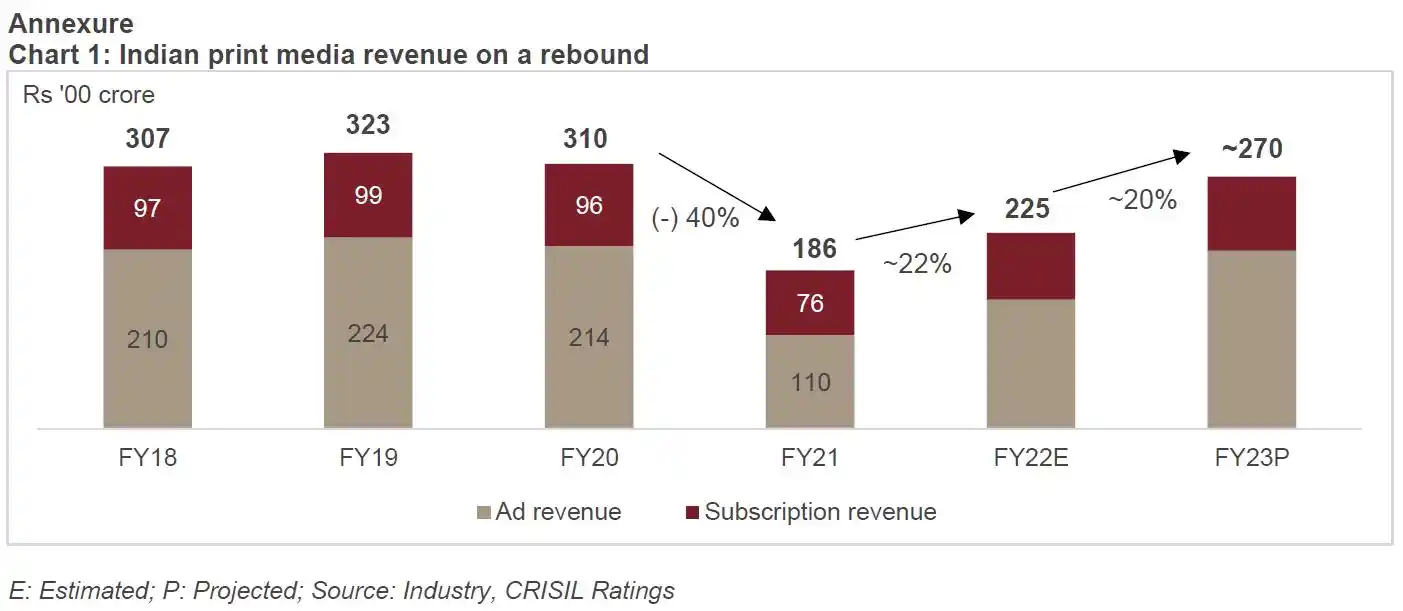
I wanted to write about the Indian news publishing industry as well, but I figured it was worth looking at the largest media market with the most advanced trends first.
While it’s easy and tempting to extrapolate the US experience to the rest of the world, the story may not play out the same way. Having said that, news publishers, even in emerging markets, are facing similar challenges with the transition to digital, changing attitudes toward print, the rise of news consumption on social platforms, and the coming age of artificial intelligence.
Despite the dreariness, there are signs of hope. Seasoned and young crazy people are building wonderful publications like Gaon Connection, Khabar Lahariya, Newslaundry, the reporters’ collective, The News Minute, The Ken, The Morning Context, The Arc, The Print, and The Wire with a variety of models. I don’t know how many will survive, but as legacy media outlets continue to debase themselves, I’m hopeful these new publications will thrive.
It’s hope that kills, but that’s life.
Why write this post? {#why.wp-block-heading}
If I can confidently say I’m a little less dumb in life, it’s because I grew up with newspapers.
As I grow older, I have started to appreciate the value of things a lot of people, including me, take for granted. Things like good journalism, good books, public libraries, sharing knowledge without agenda, and the value of archives, among other things. As I mentioned at the beginning of the post, I had dreams of being a journalist. A few right turns instead of left, and I can imagine an alternate reality where I would’ve been a journalist.
One thing that worries me the most is the slow and steady degradation of our information ecosystem. Nathan Robinson, the editor-in-chief of Current Affairs magazine, summed it up in his post titled “The truth is paywalled but the lies are free.” Paywalls are the most obvious symptom of this degradation. The number of publications implementing paywalls is increasing across the world. If the current trends in paywalls prevail, we’ll have an information apartheid. I’m not saying that news should be free, but the fact remains that most people can’t afford to pay for it. There have to be free alternatives, and this is where public funding can play a role. Sharp-eyed media observers like Simon Owens argue that there are still countless sources of free and quality news.
Is it true that many of the premium publishers now feature some sort of paywall? Yes, but no matter your interest, there are a huge number of high-quality YouTube channels, podcasts, news sites, newsletters, and social media accounts dedicated to that niche. Some of the best economic analysis in the world is being disseminated on places like Substack and Twitter, and longform podcasts allow experts to go extremely deep on just about every topic. A half hour before I sat down to write this article, I watched a 20-minute video explaining how global warming has placed Greenland into the center of a geopolitical quagmire due to its proximity to melting oceans. It was free to view and just as good as any reporting you’ll find at the Washington Post.
Such arguments miss the fact that journalism is still the dominant taproot of knowledge, and it’s shriveling. Good journalism costs a lot of money, and news publishers have to recover the cost. There’s nothing wrong with that, but it’s still a problem, and the markets aren’t going to provide a solution.
Then there’s the question of scientific and academic research. A small number of companies control the output and have turned subscriptions into extortion rackets. The victory of book publishers over the Internet Archive’s controlled digital lending was another punch in the gut for people who advocate for knowledge to be accessible. I’m not even getting into the issue of fake news and disinformation. This fraying of our information and knowledge systems has been bothering me for a long time.
At the heart of all existential issues that plague humanity, from climate change to pandemics, is an information component. Good communication and information can make a difference. One of my favorite examples comes from South Africa. Faced with a dire water shortage and the prospect of taps running dry in 2018, Cape Town implemented one of the most successful behavioral change campaigns, using good communication to nudge people to use less water.
A small number of gatekeepers choking off access to our collective knowledge is not good for society. A couple of months ago, I published a post titled “A life well lived.” One aspect of a life well lived is living with purpose. If I look back ten years later, I’d ask myself if I did something about this problem.
Parting thoughts
In the past couple of years, terms and phrases like “splinternet” and “twilight of the open web” have become popular. As I was writing this post, I couldn’t help but be amazed at the amount of free and open information. The fact that I could write about the history of American media despite having never been there or worked in that industry still blows my mind. We’ve all become jaded because of the internet, but the open web is a treasure. I don’t know if the open web as we know it will die, shrivel, or splinter, but I hope it doesn’t. If it does, humanity will be worse off for it.

